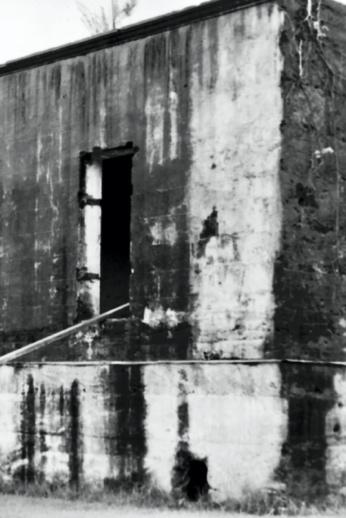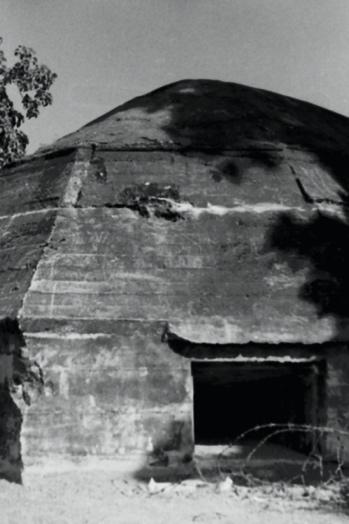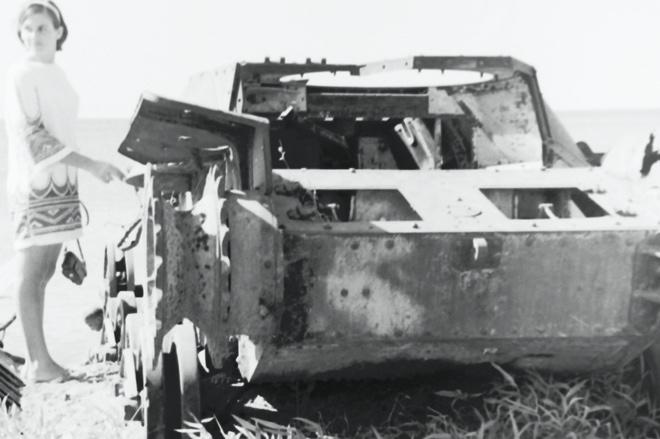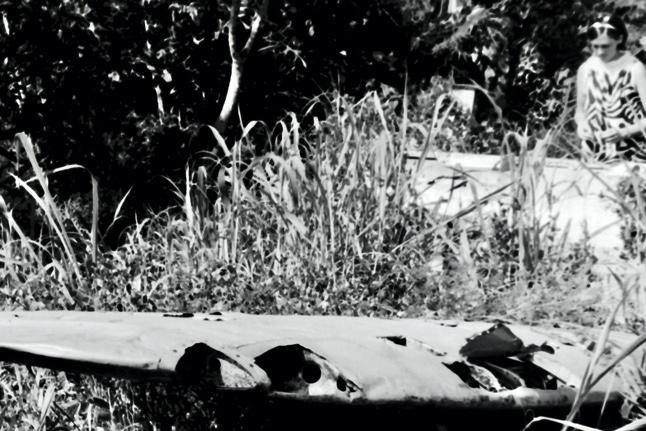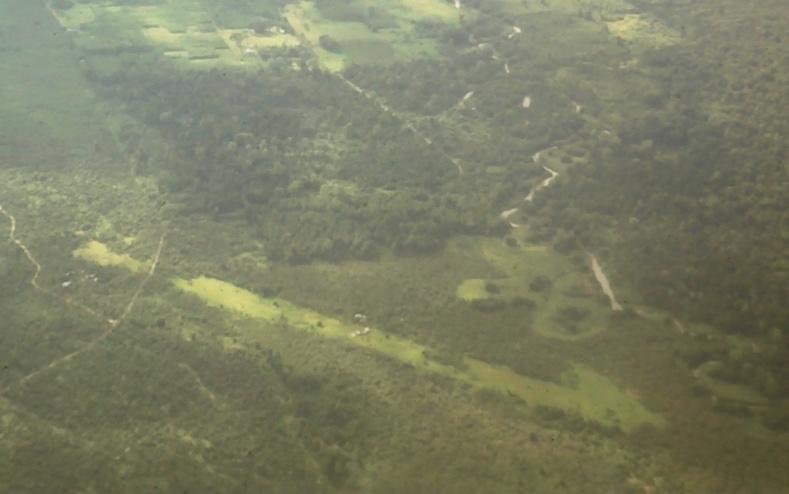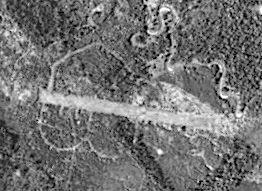FROM FORESTRY CADET TO FORESTRY PROFESSOR



(Part 3)
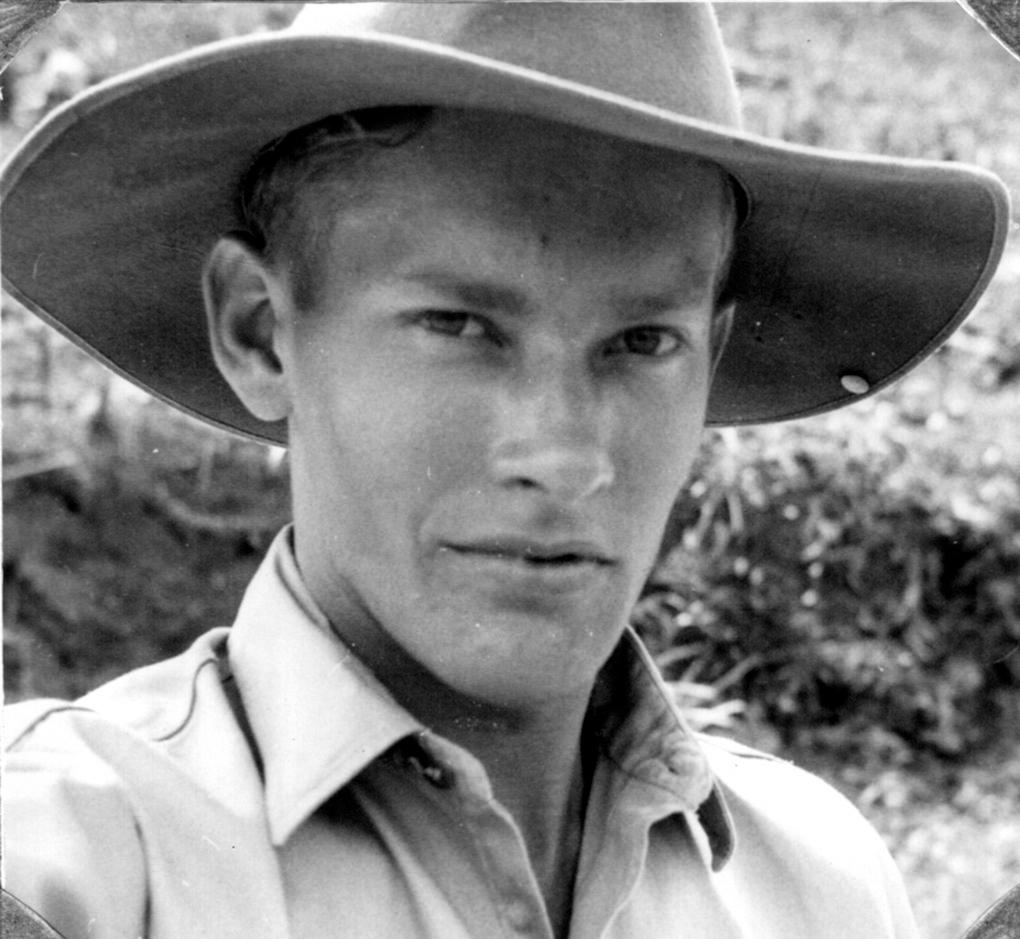
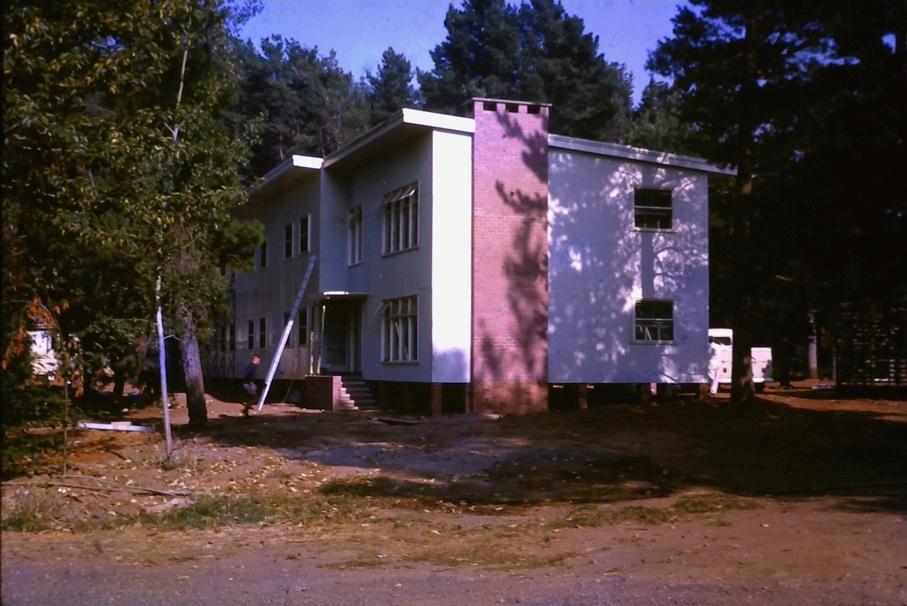
A number of changes had occurred since my previous brief attendance at the Australian Forestry School in early 1964. Already there was a sense of the presence of the ANU. The ANU Orientation Week Timetable had been adopted for 1 – 8 March 1965. Copies of the ANU 1965 Orientation Handbook (cover at left) were lying around in the forestry buildings at Yarralumla.
The “Waldorf” was no longer in use.1 Next to the existing Forestry School attached dormitory wing a “new” twostorey student dormitory building had been established. This was in fact a block of the former Canberra Hospital nurses’ quarters that had been moved from Acton to Yarralumla and rebuilt.2 The popular joke of the time was that some of the forestry students had got their old room back!
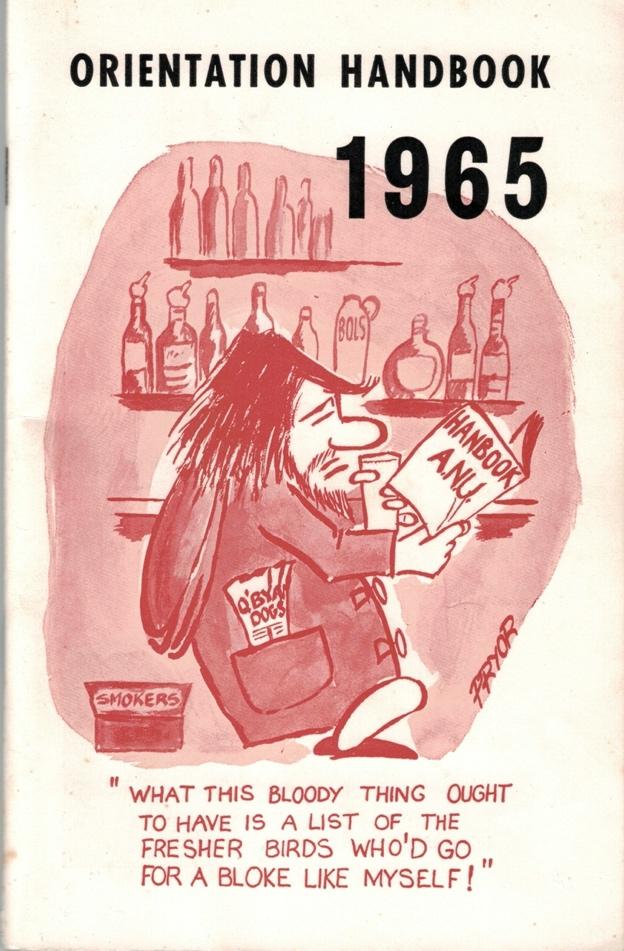
The building had a common room at one end and bathroom and toilets at the other on each floor. Study bedrooms were located each side of a central corridor as indicated by each pair of windows shown in the photographs. A built-in wardrobe, drawers and dressing table with large mirror were across all of one end wall in each room (perhaps a legacy of the design for a previous female occupant). Other than that, there was only enough room for a study desk and chair and a single bed. A plug-in electric convection heater was issued for each room, a necessity in Canberra’s winter months.
Other third year students assigned to the old nurses’ quarters (with room number in brackets) in March 1965, were Allen (22), Boomsma (4), Bowyer (15), Chiswell (11), Cross (19), Dundon (5), Emery (21), Farrow (9), Greve (16), Hiley (28), Hitchcock (13), Hodgson (26), Holesgrove (3), Johnson (18), Knaggs (1), Meakins (8), Medhurst (7), Nicholson (6), Nowill (17), Orme (2), Reynolds (14), Searley (10), Siemon (27), Temu (25), and Vowles (20). All other third year and all fourth year students lived in the main dormitory block that was integral with Forestry House. Married students in 1965, Horne and Udarbe (both Year Three) and Borough (Year Four), lived off campus.
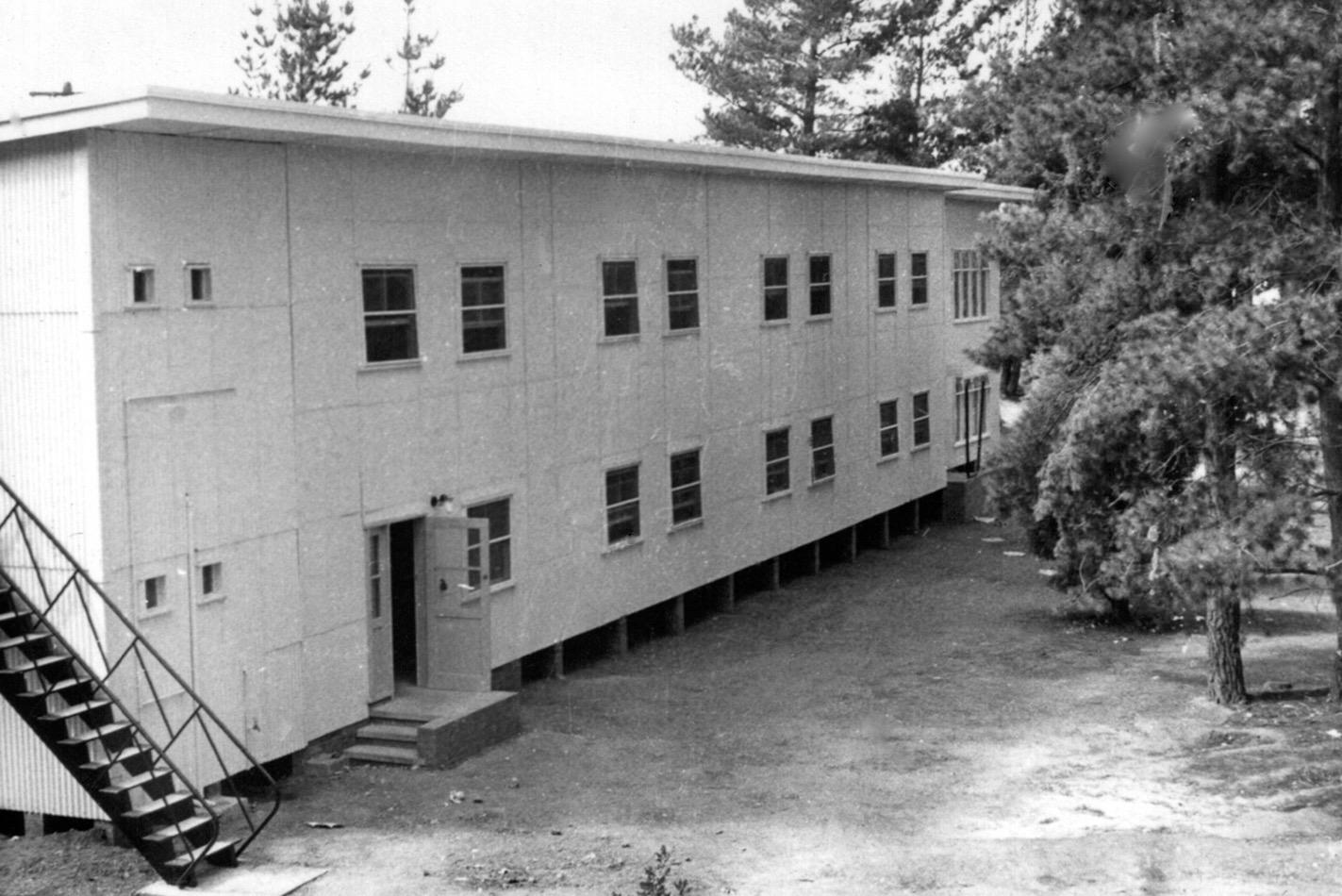
My room in 1965. Only enough room for a desk and chair, and a narrow bed. In the upper photograph the drainpipe from the sink in the common room above runs down one wall! In the corner near the towel rail are my obligatory axe and Biltmore stick. Maps of PNG, “Australia’s Western Neighbours” and Canberra adorn the walls. Occupying the whole wall opposite these photographs was a built in dressing table, mirror and wardrobe with drawers, a legacy left over from a former female occupant when the building served as a student nurses’ quarters in Acton.


sources. There funded students or women. In alphabetical order, as enrolled on 3 March 1965, and with home state and sponsor, they were:
Allen M R (NSW (State)), Barwick D S (New Zealand (Forest Service)), Benson A D (ACT (Commonwealth (Cth))), Bird T (Qld (Cth)), Boomsma D B (SA (State)), Bowyer P C (Qld (State)), Butcher T B (WA (Cth)), Cheah L C (Malaysia (State)), Chiswell E L. (NSW (State)), Chuong P H. (South Vietnam (Colombo Plan (CP))), Cross G J (Vic. (Cth)), Davidson J (NSW (PNG)), Dukuno A (Fiji (COE)), Dundon R L (SA (State)), Emery P H (SA (Cth)), Farrow M H (NSW (Cth)), Greve D McD (Qld (State)), Grimmett J L (Qld (Cth)), Harun bin I (Malaysia (CP)), Hiley D G (Qld (State)), Hitchcock P (NSW (State)), Hodgson B S H (Tas. (State)), Holesgrove R (SA (PNG)), Horne R R (NSW (State)), Ibrahim S bin S Ali (Malaysia (CP)), James R N (New Zealand (Forest Service)), Johnson G T (Qld ((State)), King G A (Qld (Cth)), Knaggs D G (NSW (Cth)), Lewis H N (SA (Cth)), Meakins J S (NSW (State)), Medhurst G E (NSW (State)), Nicholson C (NSW (State)), Noordin S (Malacca (State)), Nowill J F (Qld (State)), Orme R K (Tas. (State)), Pfitzner R H (SA (State)), Reynolds J G (NSW (State)), Richley L R (NSW (Cth)), Ryan P A (PNG (PNG)), Sands R (Qld (State)), Searley M E (NSW (State)), Shea S R (WA (State)), Siemon G R (Qld (State)), Temu M E (Tanganyika (Special Commonwealth Assistance for Africa Programme (SCAAP))), Traise L W (NSW (Cth)), Udarbe M P (North Borneo (Colombo Plan)). A 49th student, Turner J S P (New Zealand (Forest Service)), withdrew part way through the year.

Teaching staff and Third and Fourth Year Students, Department of Forestry Australian National University in 1965:
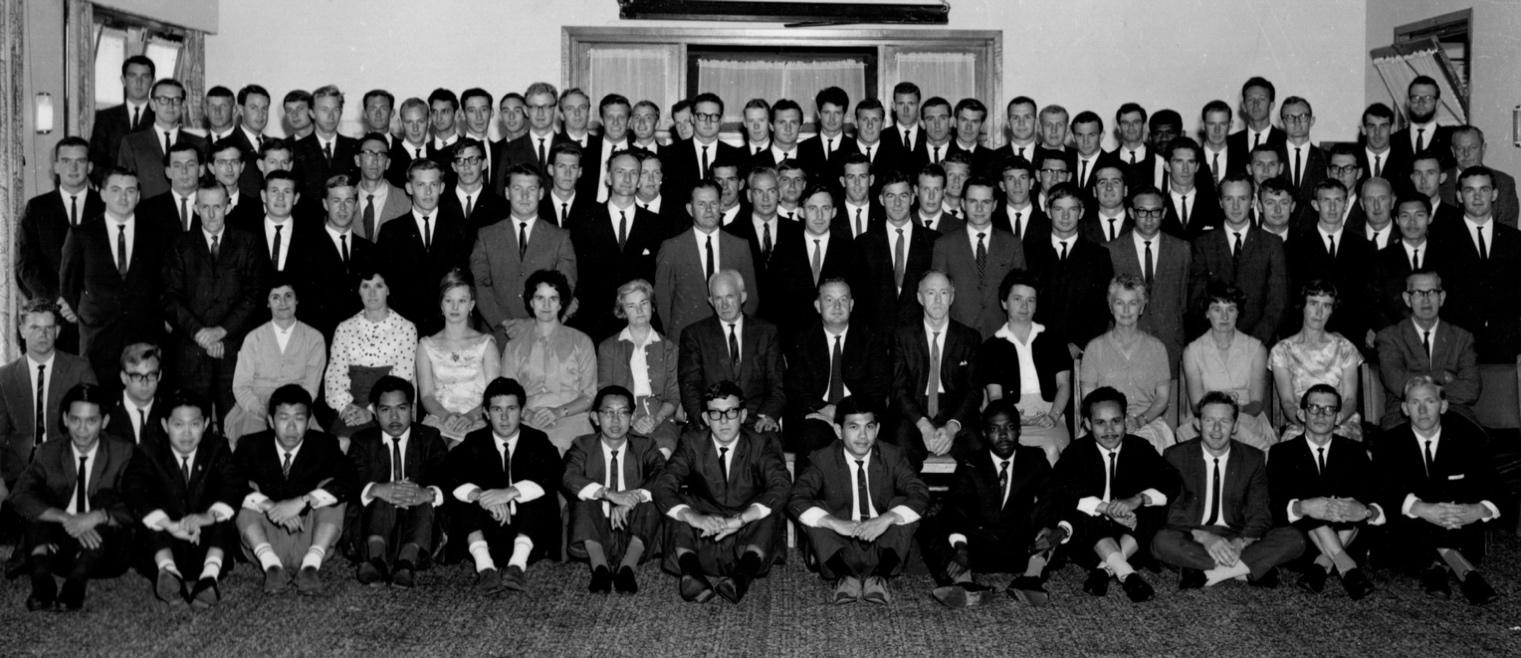

Listed left to right, with home State/Country of origin for students (names without State/Country were staff): Front row, seated on floor: Udarbe (North Borneo), Chai (Malaysia), Cheah (Malaysia), Harun bin Ismail (Malaysia), Grimmet (Qld), Low Beng Hock (Malaysia), Holesgrove (SA), Noordin (Malacca), Temu (Tanganyika), Sheik Ibrahim (Malaysia), Johnston (Qld), Sands (Qld), Hitchcock (NSW).
Next row, seated on chairs (Staff): A Wood, Dr R Florence, A Brown, Dr W Heather, N Hall, K P McGrath, Prof J D Ovington, L T Carron, Dr M Tanton, C D Hamilton, Dr E Bachelard, C Clements, G Hogg.
First row standing: Smith (Tas.), Dundon (SA), Vowles (Qld), Bolland (Qld), Van der Sommen (NSW), Davidson (NSW), Day (NZ), Knaggs (NSW) Bird (Qld) Jennings (Qld), Chiswell (NSW), Hiley (Qld), I Gordon, D Lamb, R Edmunds, Chuong (South Vietnam), Higgs (Tas.).
Second row standing: Bowyer (Qld), Harrison (PNG), Eddy (NSW), Lewis (SA), R Fenton, Hooper (Qld), (G) King (Qld), Searley (NSW), Reynolds (NSW), Butcher (WA), Grattidge (PNG), Cross (Vic.), (R) King (NZ), R Paton, Siemon (Qld), Meakins (NSW), McKinnon (NZ).
Third row standing: Boomsma (SA), Wrigley (NSW), Turner (NZ), Traill (Tas.), Gwalter (NSW), S Meikle, Horne (NSW), Shea (WA), Benson (ACT), Farrow (NSW) Traise (NSW), Hodgson (Tas.), Nicholson (NSW), Dukuno (Fiji), Richley (NSW), Higgins (Qld), Orme (Tas.).
Back row standing: Medhurst (NSW), Ryan (PNG), Emery (SA), Barwick (NZ), Pfitzner (SA), James (NZ), Banks (Qld), Haynes (SA), Squire (NSW), Nowill (Qld), Bruce (PNG), McCutcheon (WA), Davis (SA), Phillis (NSW), Allen (NSW), Greve (Qld).
Third Year Students, Department of Forestry Australian National University in 1965:
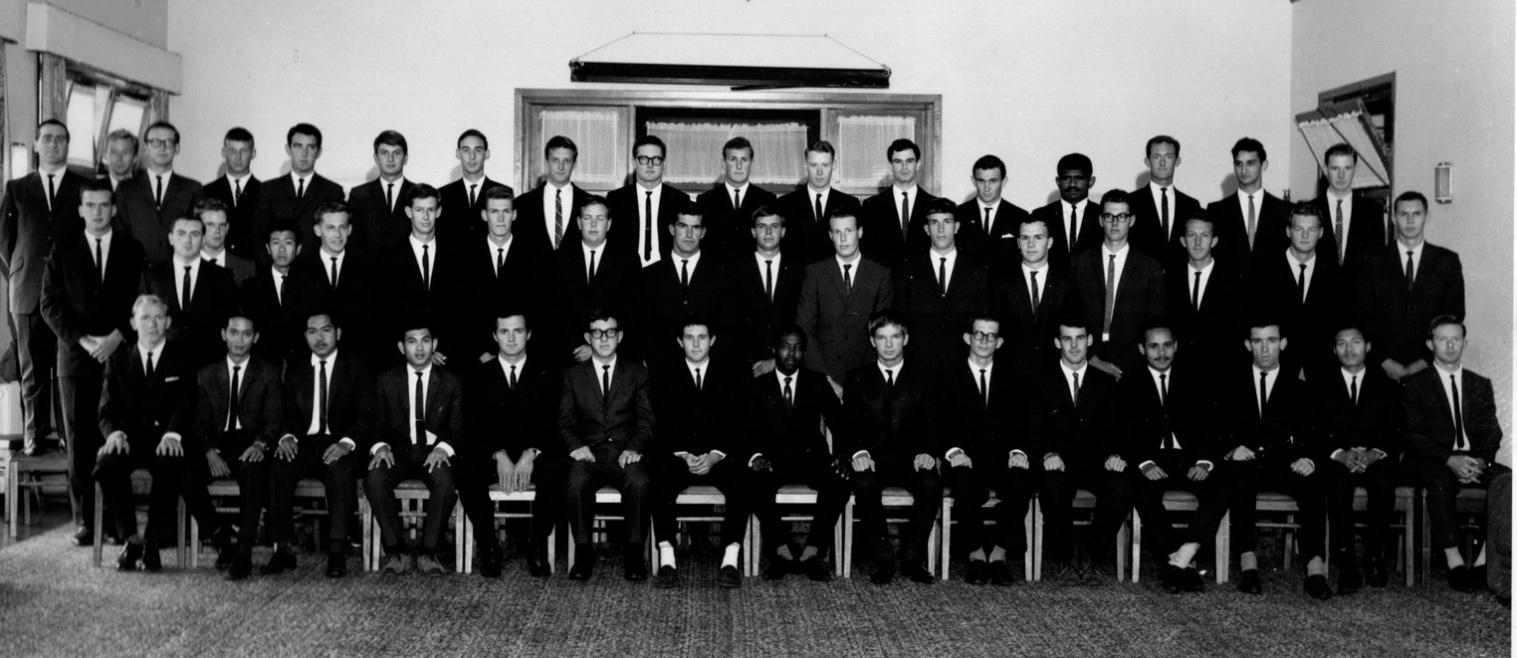
Listed from left to right with home State/Country of origin (see separate list given earlier for sponsor):
Front row seated: Hitchcock (NSW), Udarbe (North Borneo), Harun bin Ismail (Malaysia), Noordin (Malacca), Benson (ACT), Holesgrove (SA), Grimmet (Qld), Temu (Tanganyika), Hiley (Qld), Sands (Qld), Orme (Tas.), Sheik Ibraham (Malaysia), Traise (NSW), Chuong (South Vietnam), Johnston (Qld).
Middle row standing: Dundon (SA), Vowles (Qld), Bowyer (Qld), Cheah (Malaysia), Davidson (NSW), Lewis (SA), King (Qld), Searley (NSW), Knaggs (NSW), Bird (Qld), Chiswell (NSW), Butcher (WA), Hodgson (Tas.), Meakins (NSW), Greve (Qld), Reynolds (NSW), Siemon (Qld).
Back row standing: Cross (Vic.), Turner (NZ), Boomsma (SA), Ryan (PNG), Medhurst (NSW), Emery (SA), James (NZ), Horne (NSW), Shea (WA), Farrow (NSW), Nowill (Qld), Allen (BA Syd.) (NSW), Nicholson (NSW), Dukuno (Fiji), Barwick (NZ), Pfitzner (SA), Richley (NSW).
In March 1965, the first Soviet Space walk took place.
Forestry House Rowing Team 1965. Seated, left to right: Hodgson, Banks, Siemon. Standing, left to right: Turner, Shea, Haynes, James, me, Meakins.

The ANU opposed the number and structure of the units taught under the Forestry School curriculum3 calling them inappropriate for a university degree.4
The ANU Faculty of General Studies accepted a new course assessment structure in 1965 that provided for only four units toward the degree of Bachelor of Science (Forestry), two in the third year and two in the fourth, designated IIIA, IIIB, IVC and IVD. The individual subject courses that made up the former Diploma of Forestry had to be redistributed into these units for which points were awarded towards the Degree. However, during the transition, students in year three still were assessed and graded on some individual subjects. As a result, for 1965, the official transitional transcript of results would show only a single grade against “Forestry III” without the “A” and “B” designators.
Forestry Degree classes start under the jurisdiction of the ANU
A Professor and Head of the ANU Department of Forestry had been appointed (Professor J D Ovington PhD DSc FFS), taking over from Mr K P McGrath, the last Principal of the Australian Forestry School. New staff appointments had been made, including Dr R Florence (Silviculture), Dr M Tanton, and Dr E Bachelard. Forestry School lecturers transferred to the ANU included Dr W Heather (Wood Structure and Identification), Mr A Brown (Foundations of Silviculture), Mr N Hall (Engineering, Harvesting, Transport, Photogrammetry), Mr K P McGrath (Forest Management, Economics, Policy), Mr L T Carron (Mensuration, Statistics), Mr A G McArthur (Fire Control) and Mr C D Hamilton (Soils, Dendrology).
In the absence of teaching accommodation on the main ANU campus, lecture and laboratory classes were still held in the Forestry School buildings in Yarralumla. There was a fleet of Commonwealth owned and registered VW combi-vans for transport of students on excursions.
Approved student drivers drove these Commonwealth vehicles, after they had been passed a competency test at the beginning of the year.
3 Individual subject units taught at the Australian Forestry School/ANU in 1965 – 1966 included Logging, Major Forest Products, Forest Pathology, Minor Forest Products, Seasoning and Preservation, Plantation Establishment, Engineering I, Engineering II, Wood Structure and Identification, Utilization I, Utilization II, Foundations of Silviculture, Statistics, Statistical Method, Aerial Photography, Dendrology, Entomology, Forest Finance I, Forest Finance II, Fire Control, Forest Soils, Forest Mensuration, Forest Surveying, Forest Policy and Forest Management.
4 See p273 in Carron L T 1985 A History of Forestry in Australia. ANU Press Canberra.
In 1965, Canberra’s population was only about 95,000. There were no Belconnen suburbs and only the very first houses were being started in Curtin in the thus far empty Woden Valley (photograph below).
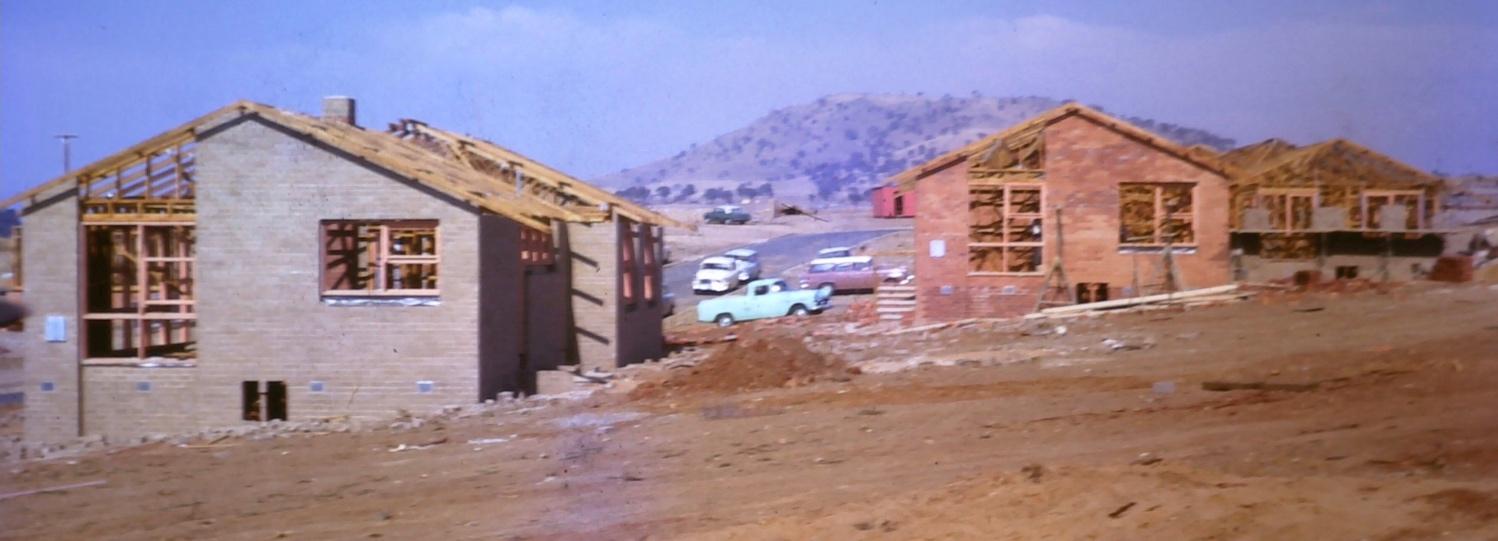
I flew from Canberra to Armidale on the evening of Wednesday 7 April 1965. Gloria’s 21st Birthday was celebrated with a special dinner at a restaurant in the city in the evening. Later that same evening I anxiously made a proposal of marriage to Gloria, which was accepted, and confirmed with a diamond engagement ring placed on the second finger of her left hand.
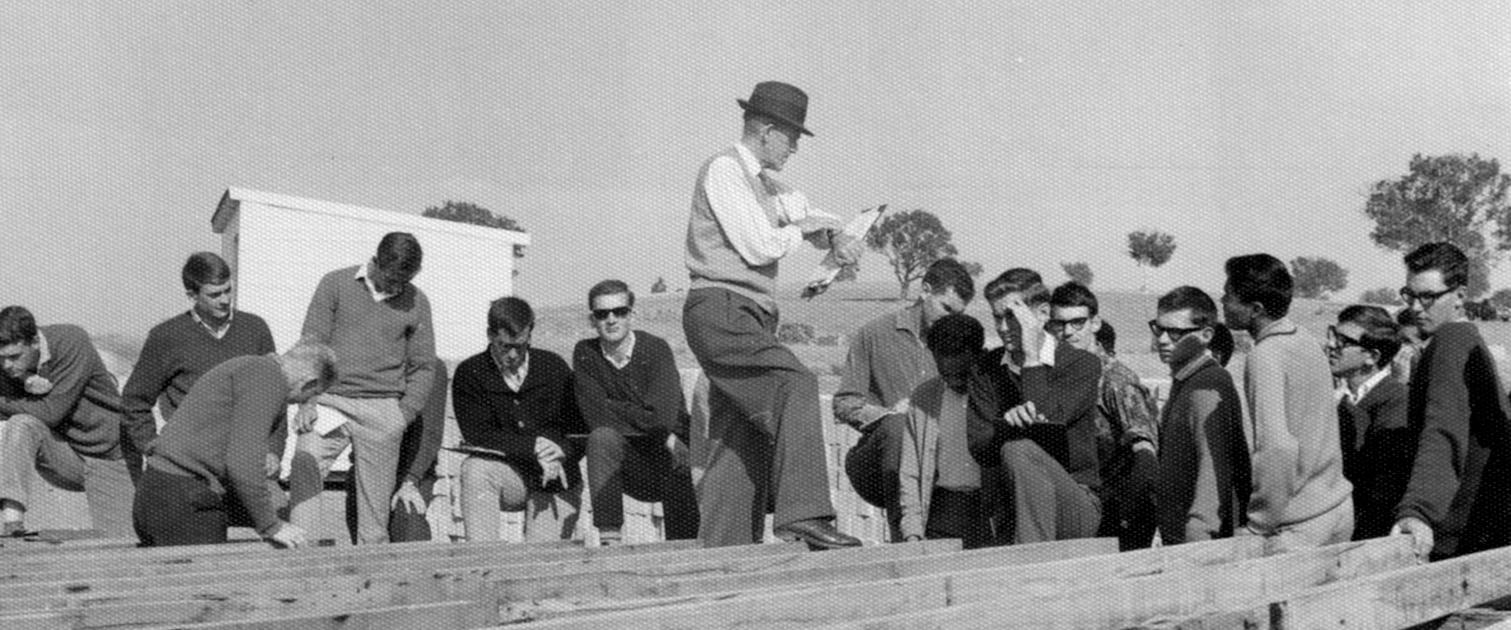
Celebration of another kind took place on Saturday 10 April 1965 at the UNE, with the Degree of Bachelor of Science conferred on me at a sunny open-air ceremony in the Northern Court in front of Booloominbah.
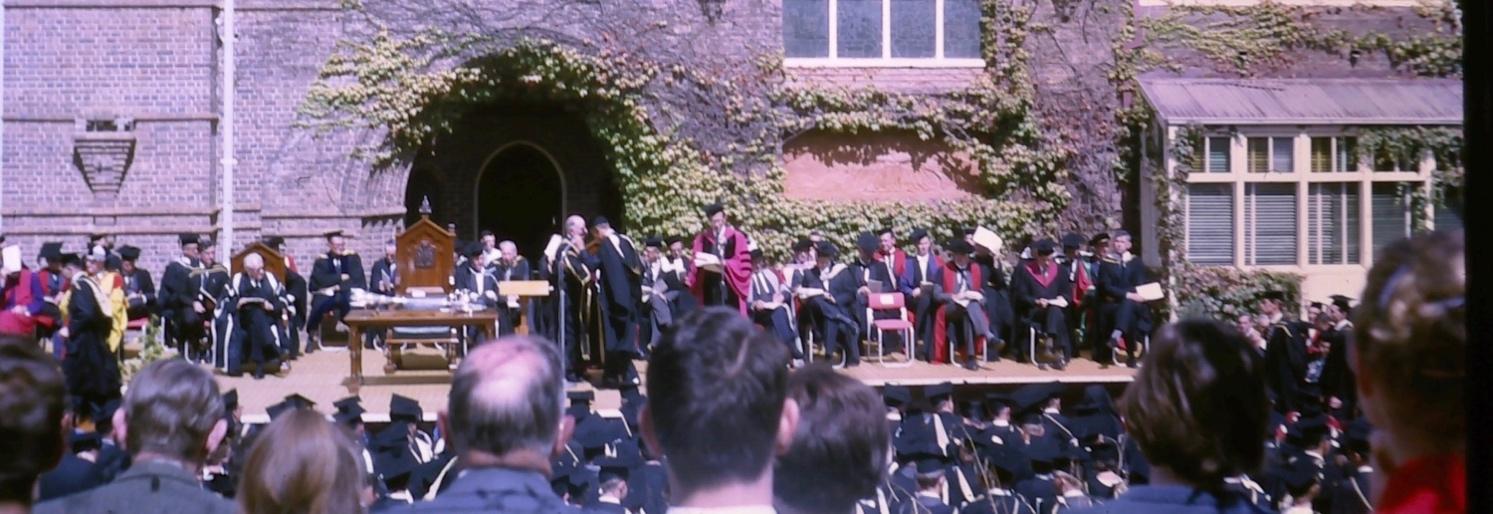
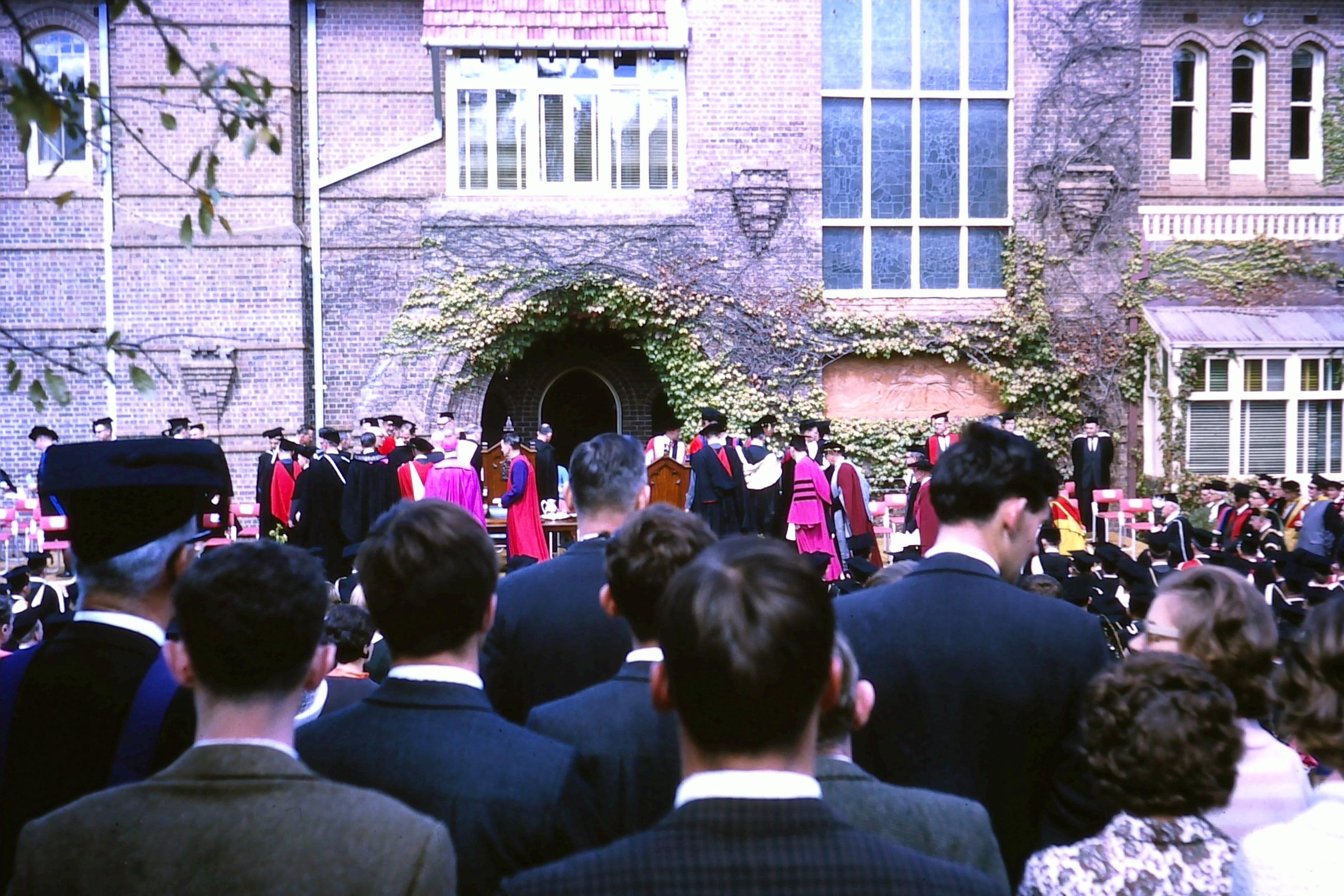
After being announced by the Dean of the Faculty of Science Prof. N H Fletcher (standing, centre, in magenta robes), I step forward (just left of centre) to accept my Bachelor of Science Degree scroll from the Deputy Chancellor of the UNE, in front of Members of the University Council, Guests and Senior Staff seated on the dais. The date was 10 April 1965.
Of note in the same proceedings, UNE Bachelor of Science in Forestry Degrees were conferred on three overseas forestry students who had completed studies at the Australian Forestry School in 1964: O Faleye, G Singh and P Kio. (See lists in the proceedings booklet reproduced here on the next page).
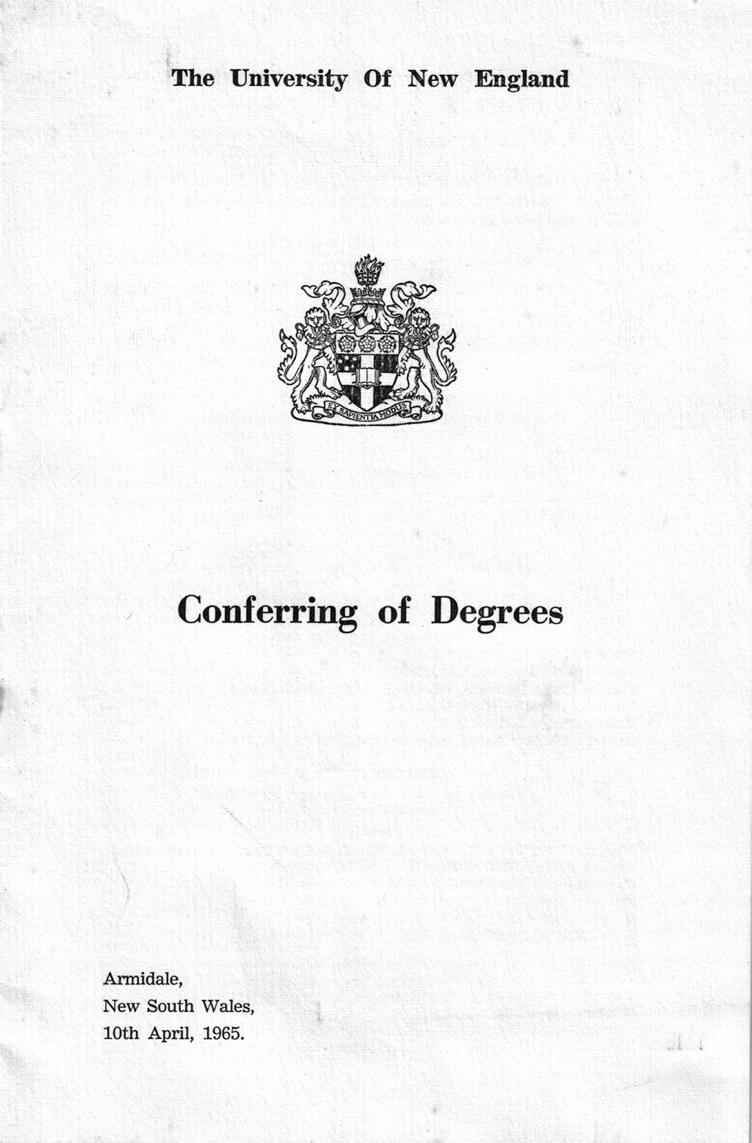
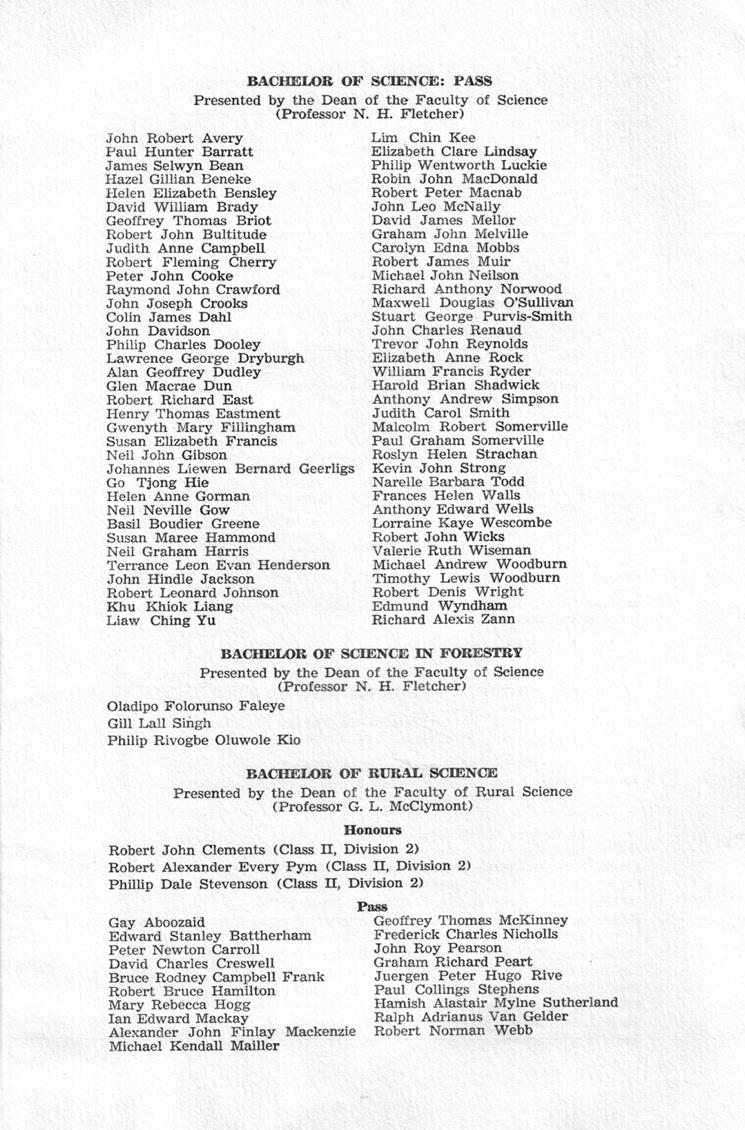
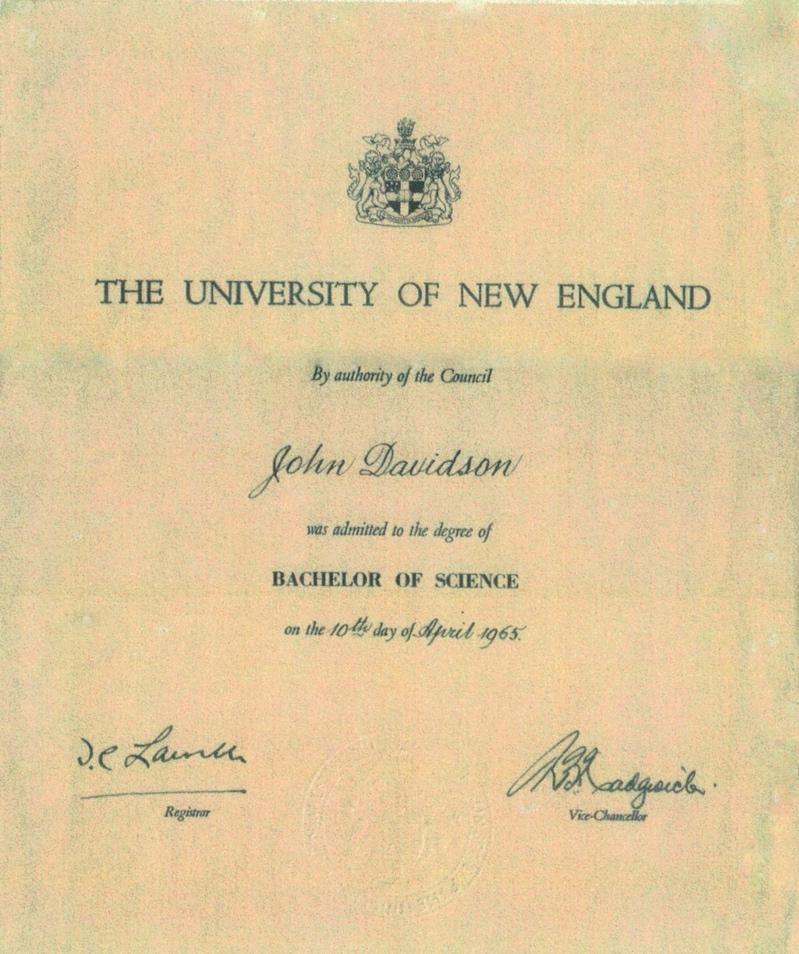
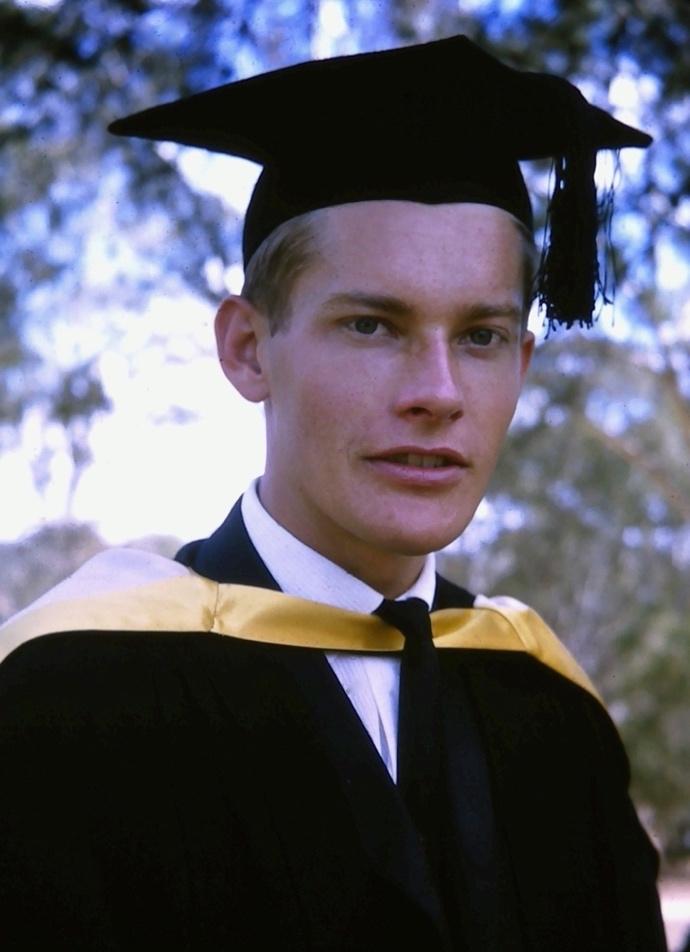
Easter 1965 was from 16


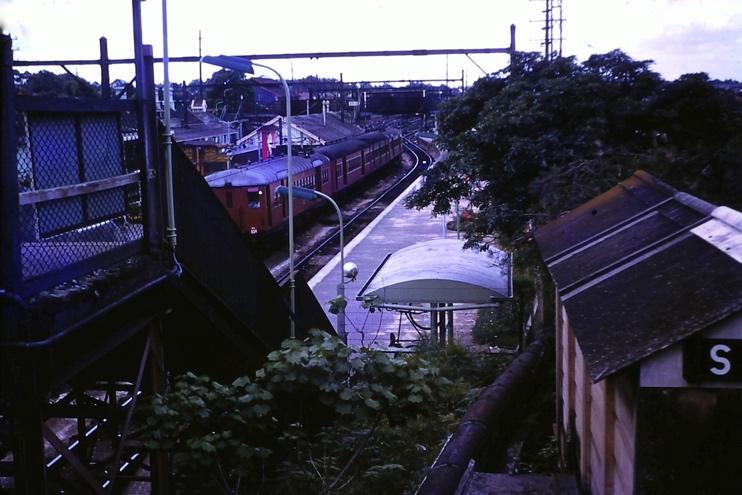
19 April and Gloria and I met up in Sydney for a brief holiday at my grandmother’s place at 6 Bellbrook Avenue Hornsby, Sydney (left, unchanged since the late 1940s). It was decided to set a wedding day date in December 1965, mid-way between the end of Third Term at the ANU and Christmas.
Gloria and I took the opportunity for some sightseeing around Sydney. This included a trip on the Harbour Ferry to Manly, a ferry to the zoo, a walk in the Botanical Gardens, a stroll around the shops in the central city with commutes by train from Hornsby Station to Wynyard Station across the Sydney Harbour Bridge. A climb was made up the southeastern pylon of the Bridge to look at the developing central Sydney skyline and progress on the Opera House.

The AMP building at Circular Quay (with flag on top) was the tallest building in Sydney in 1965 and offered access for visitors to a covered observation deck on the roof. Construction of several other tall buildings nearby was underway, as indicated by the number of cranes deployed, but not yet for the later major high-rise buildings.
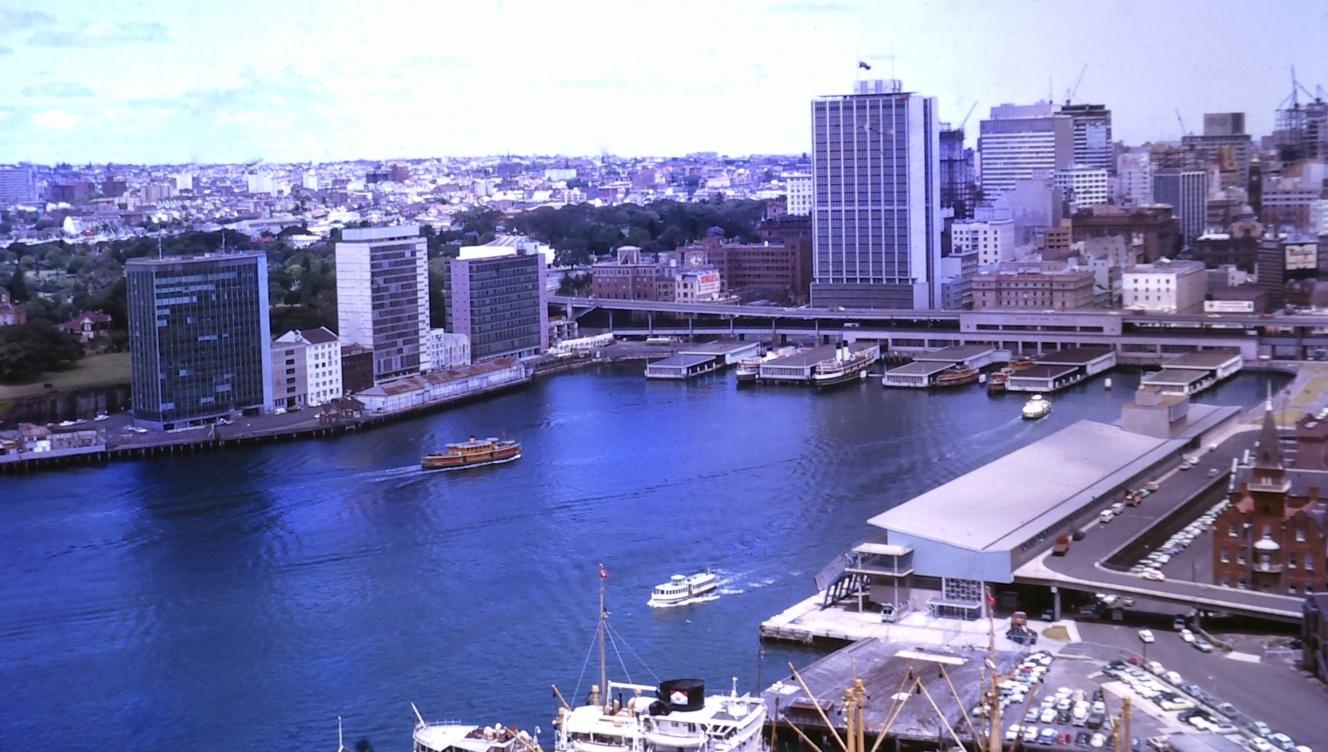
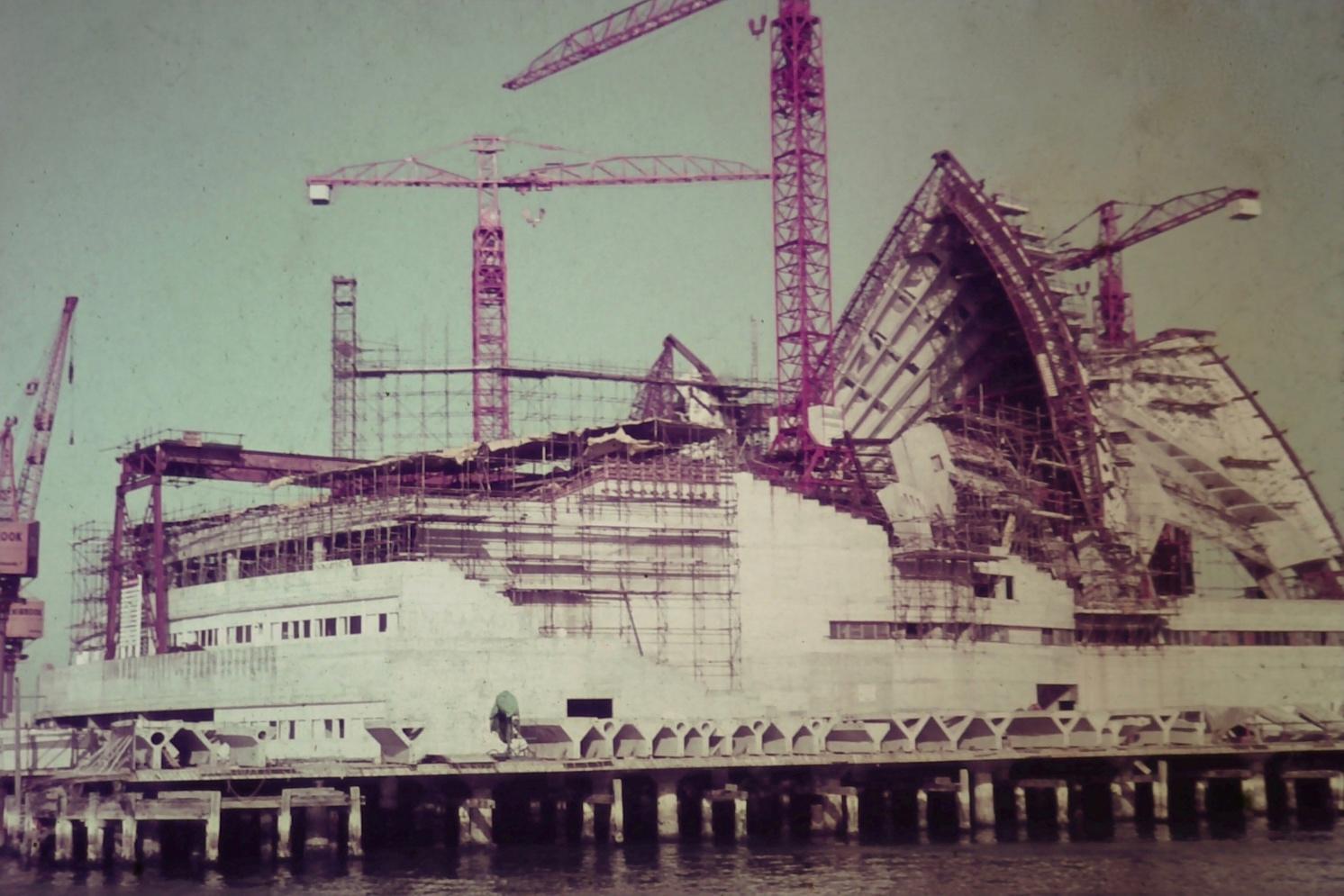
Then it was back to Canberra for course work up to the end of First Term on Saturday 15 May 1965. During the break between first and second terms a series of Mensuration exercises was carried out in the field in Compartment 140 Pinus radiata, Uriarra and Yield Plots 35/60/1 and 15A/80/1 in P. radiata, Kowen, under the guidance of Mr Carron. Included was the measurement of individual tree height using a number of instruments: Pole Hypsometer, Vorkampf-Laue Hypsometer, Christen Hypsometer, Abney Level, Haga Altimeter, Blume-Leiss Height Measurer and Suunto Clinometer. Tree volume estimation by several methods was covered: Sectional Method, Percentile Method and Graphical Method. Tree growth was estimated in a number of relationships: Height – Age, Diameter – Age, Basal Area Under Bark – Age and Volume – Age.
A detailed report was required to be prepared for handing in at the beginning of Second Term. Second Term began on Monday 7 June. The Queen’s Birthday Holiday was celebrated on Monday 14 June.
“Bush Week” was observed from Sunday 1 August to Saturday 7 August 1965, the latter date also being the end of Second Term. The original aims of Bush Week were “to remind students of their debt to the pioneers of this nation and the part played by all under-privileged workers of today; to provide an occasion for student frivolity, and, to raise (if possible) funds for charity”.5
Meanwhile, in Papua and New Guinea, some two years after teaching started, the Papua and New Guinea Forestry School in Bulolo was officially opened on 3 August 1965 by the then Minister for Territories, the Honorary C E Barnes MP (Commonwealth). In his speech6 the Minister alluded to plans to replace the Certificate Course with a three-year Diploma Course by 1967 and ultimately in conjunction with a new Territory University and an Institute of Higher Technical Education (see later). Some students from the School then would have the opportunity to graduate with the degree of Bachelor of Science (Forestry). Soon after, other Schools like the Forestry School in more disciplines were started in PNG, and all were thereafter referred to as “Colleges”.
The University of Papua New Guinea (UPNG) located in Port Moresby was established by ordinance of the Australian administration in 1965. This followed the Currie Commission which had enquired into higher education in Papua New Guinea in 1964.7The Currie Commission at the time proposed graduate and postgraduate training in forestry for Papua New Guineans in Australia.
5 ANU Orientation Handbook 1965, p26.
6 Speech by the Minister for Territories the Hon. C E Barnes at the opening of the Papua and New Guinea Forestry School, Bulolo, 3 August 1965. Bulolo TPNG and Canberra ACT, 3 August 1965.
7 Currie G, Gunther J T and Spate O H K 1964 Report of the Commission on Higher Education in Papua New Guinea. Canberra, Australian Government Publishing Service. vii + 335 p.
Among the several social functions held in Forestry House was the annual Fancy Dress Ball. This one was in 1965. A great deal of effort was put into decorations and costumes. On the next page a close inspection will find Paul Ryan, Chris Borough, Rod Holesgrove (PNG Cadets) and Les Carron (Staff)!

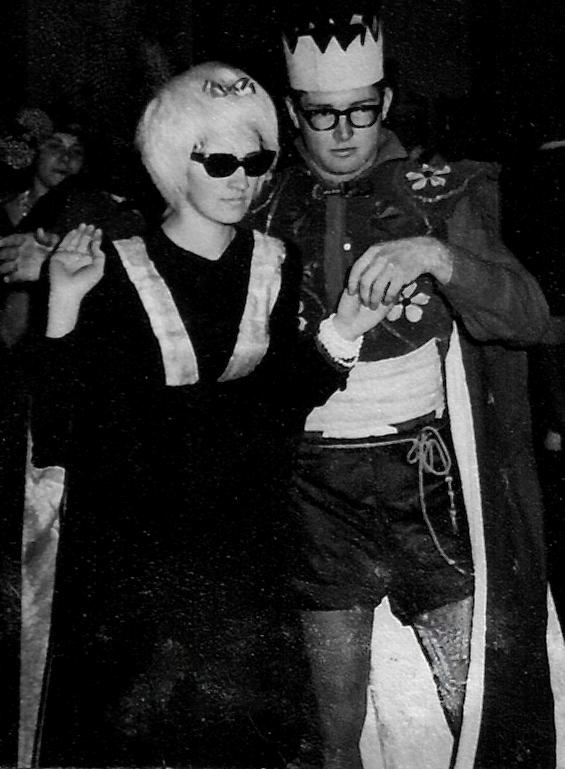
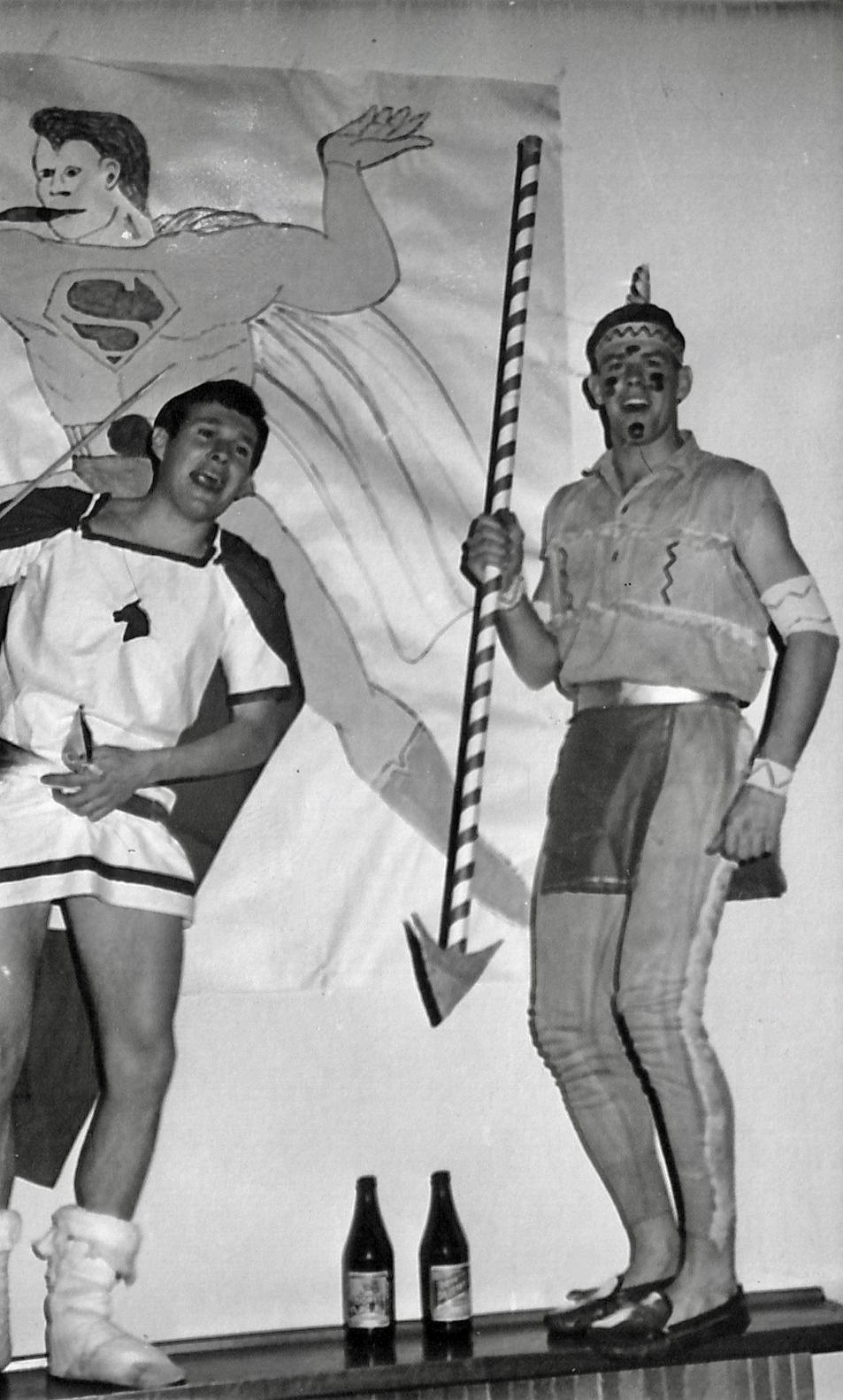



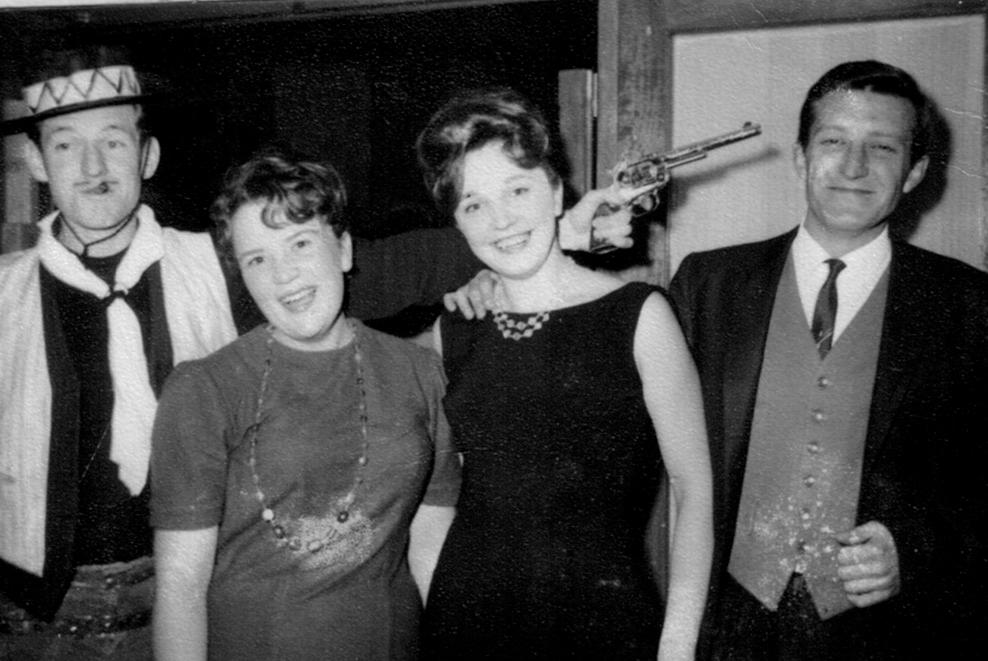

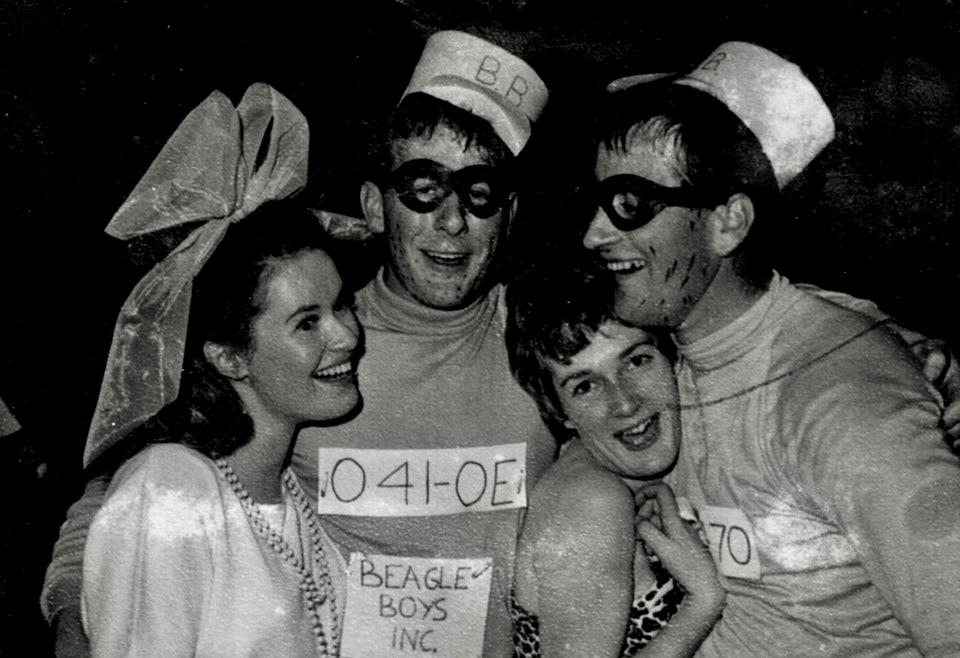
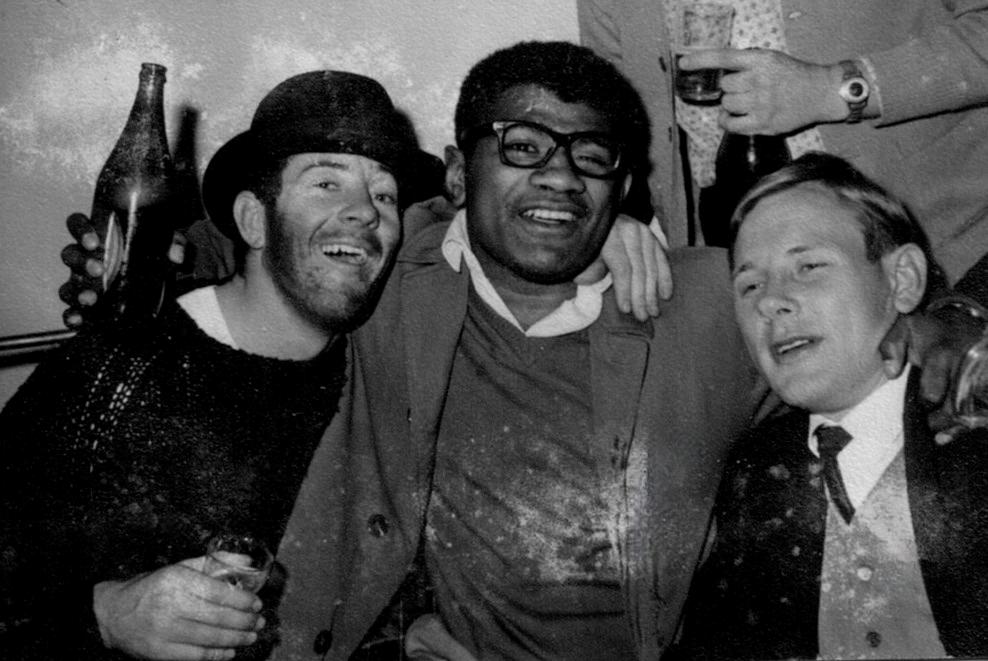
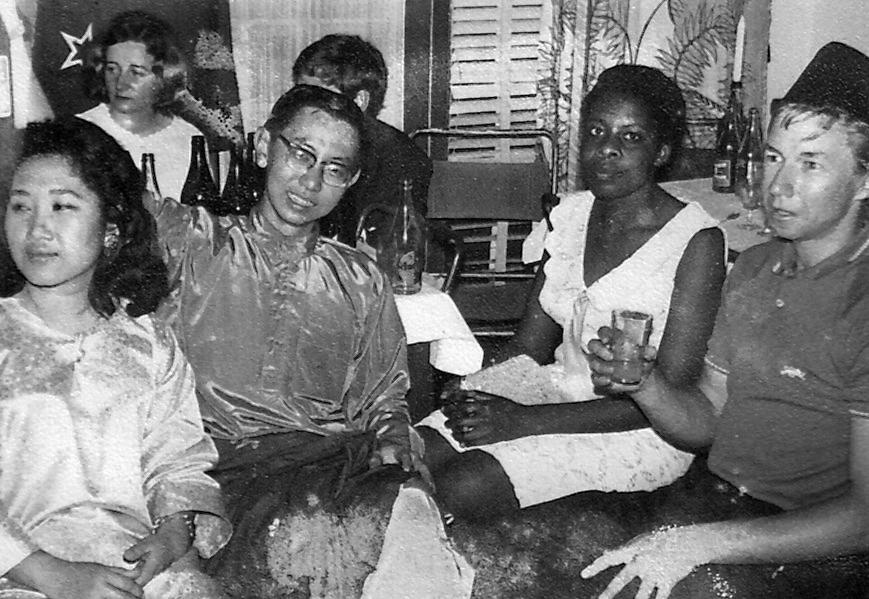
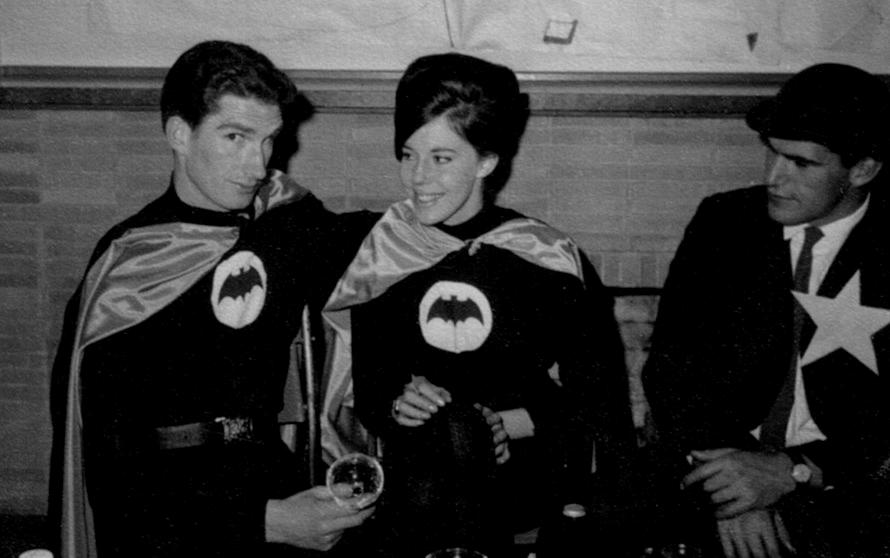
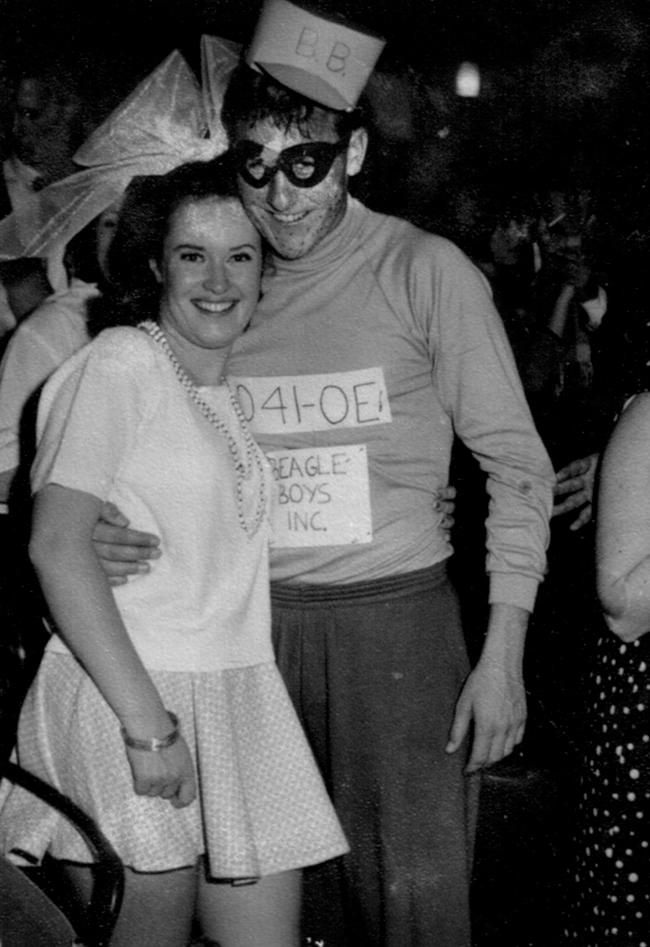
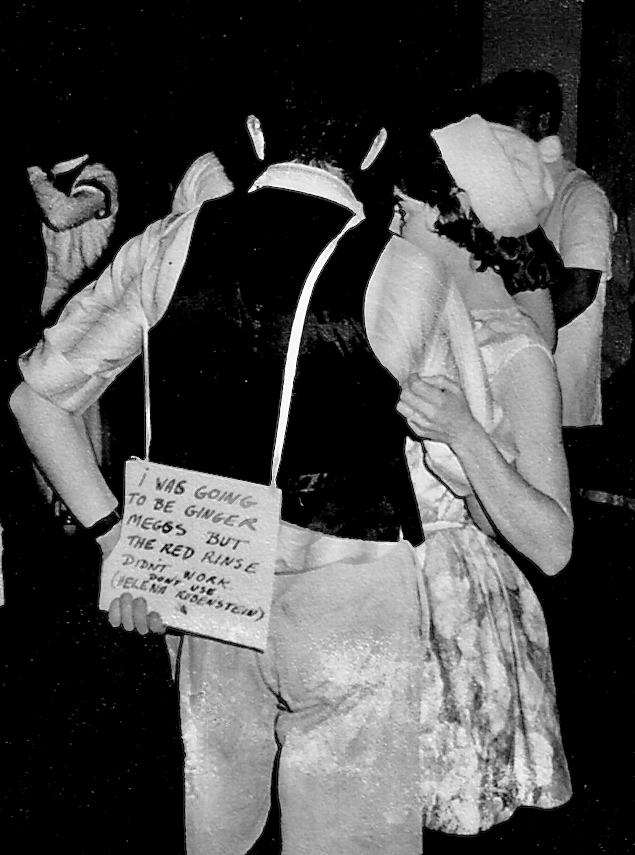
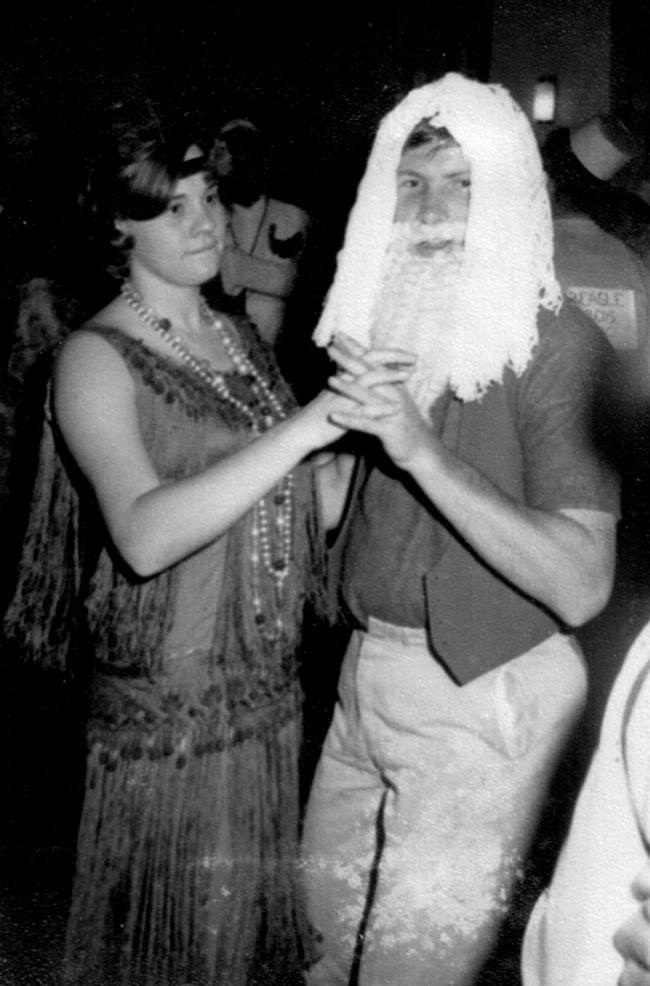
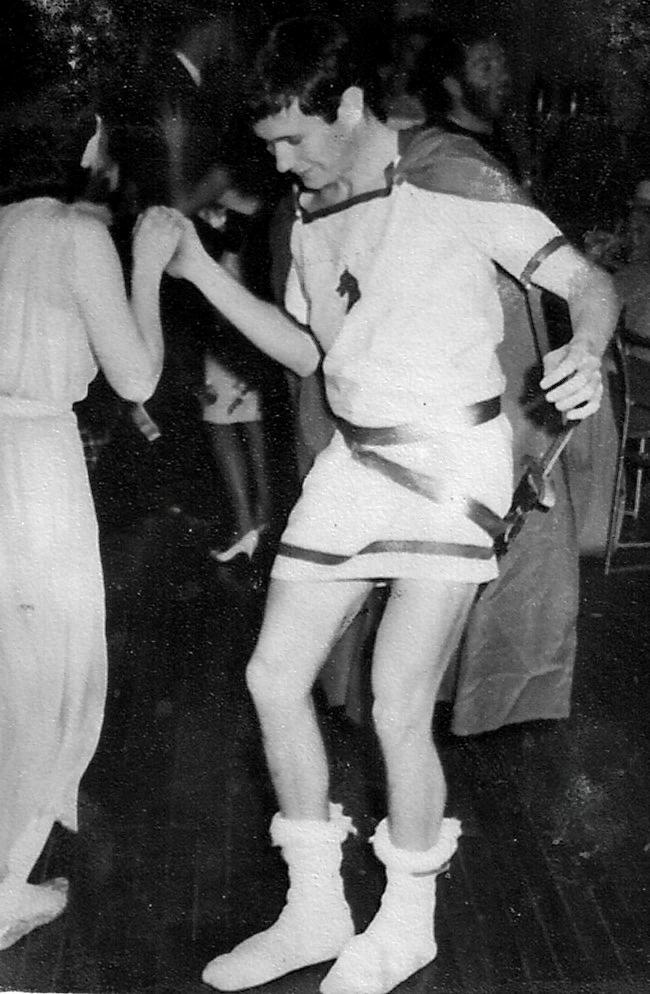




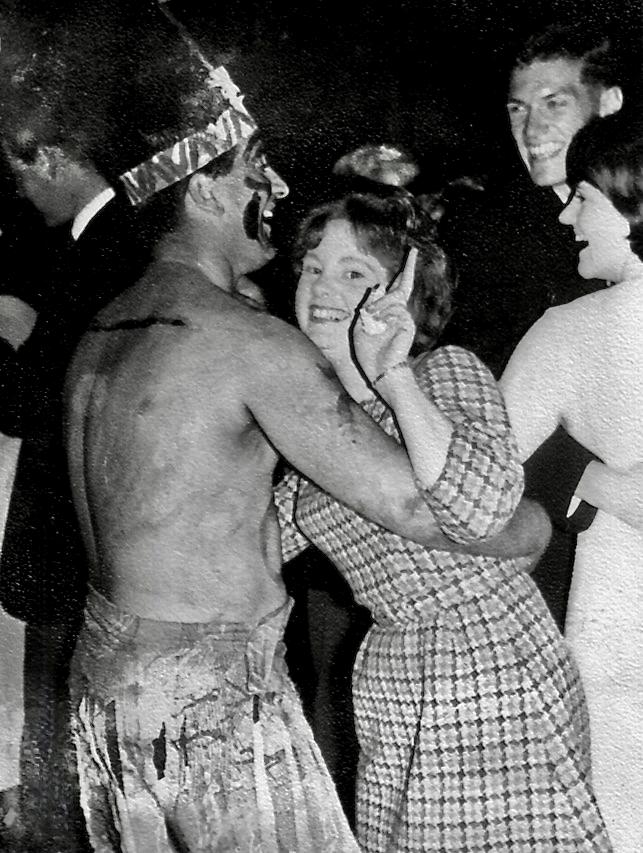


During the break between Terms 2 and 3, I travelled to Sydney to pick up a new Ford Falcon car that Gloria and I had decided to buy for £1,100 ($2,200) through a dealer in Kempsey, and drive it back to Canberra. Invitations for our wedding were sent out.
Wedding invitations were sent out in October 1965.
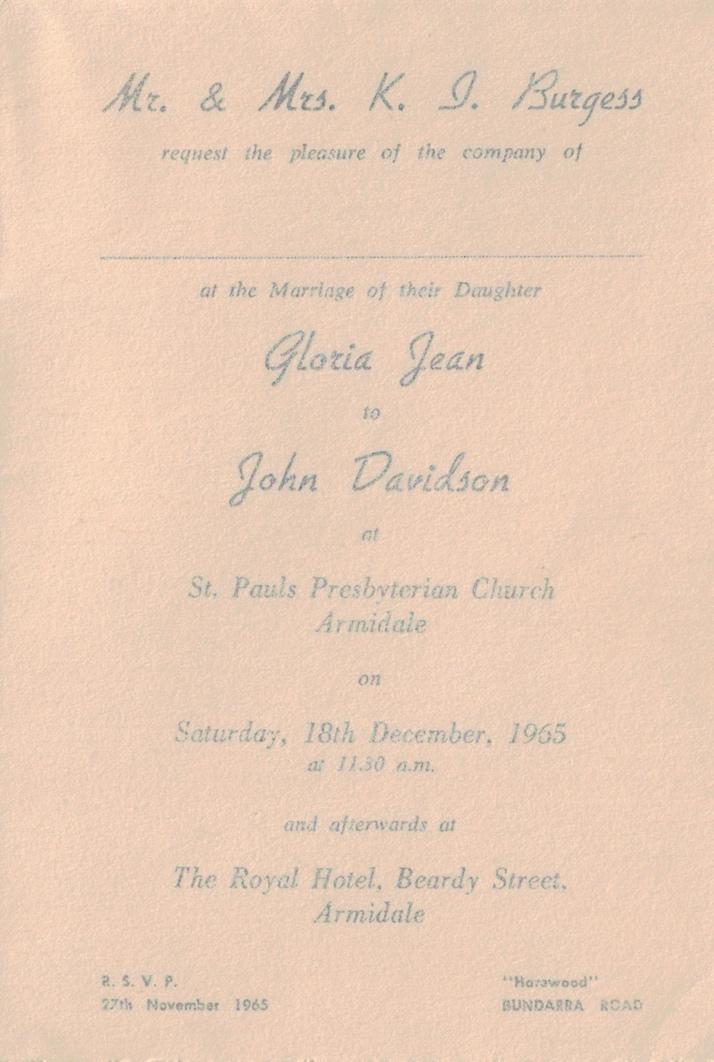

Third Term began on Monday 6 September with lectures for the year ending on Saturday 23 October 1965. The time between 23 October and 8 November was allowed for fulltime voluntary study.
Because of the relatively large number of separate examination papers to be sat in forestry at the time, the exams ran from 8 November through to 11 December 1965.
The ANU Department of Forestry held an Annual Dinner on Friday 5 November, just before the official start of annual examinations on Monday 8 November. The photographs in this section record the afterdinner entertainment provided by “The Forestry House Goons”.


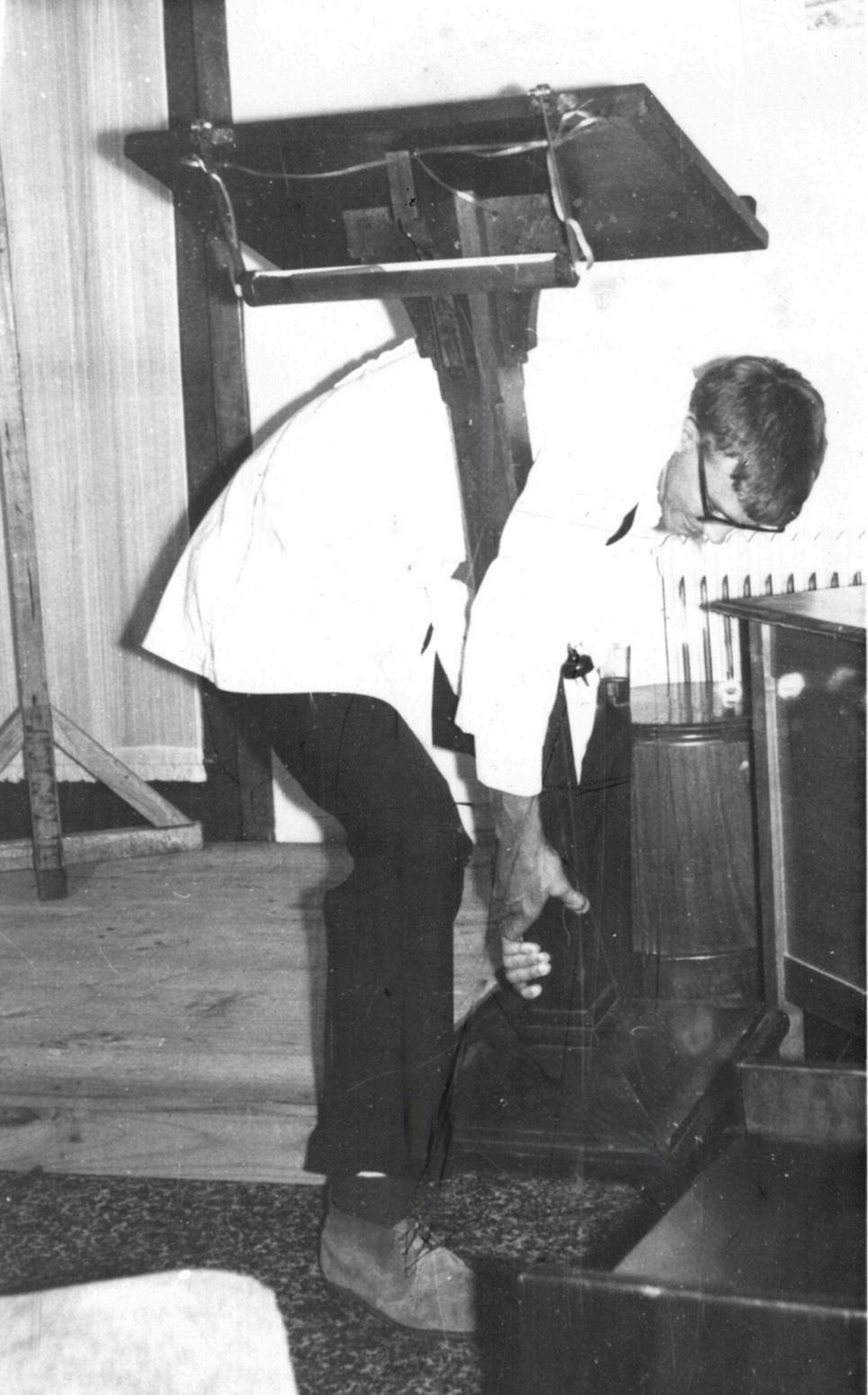
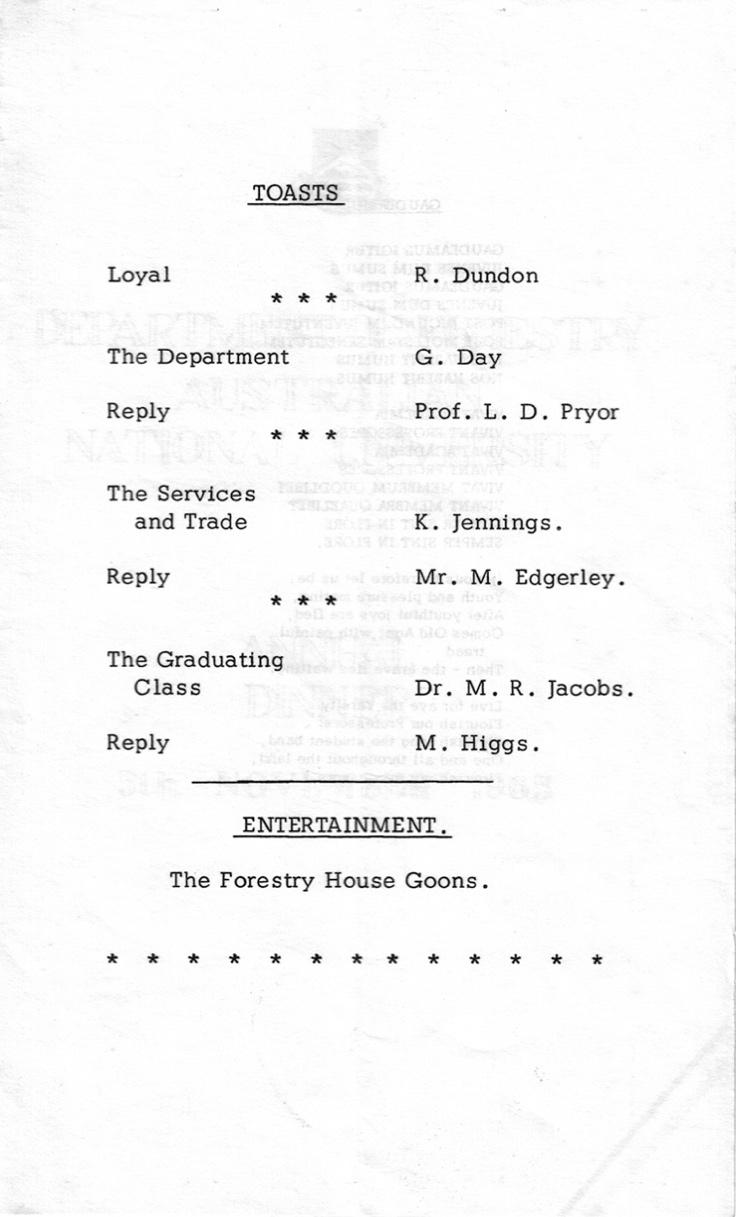
The Forestry House Goons present (top) a “lecture” on sexually transmitted diseases, and (bottom) a “lecture” on ecology, involving botany and a detailed “soil profile”. The “lecturer” in soft white hat with a hand lens on a string around his neck, played by Gerry Cross, parodied Charlie Hamilton one of the actual lecturers in dendrology and soils in the Department. Others in the cast for this item included John Meakins, Ken Traise, “Clarry” Grimmet and Sid Shea.
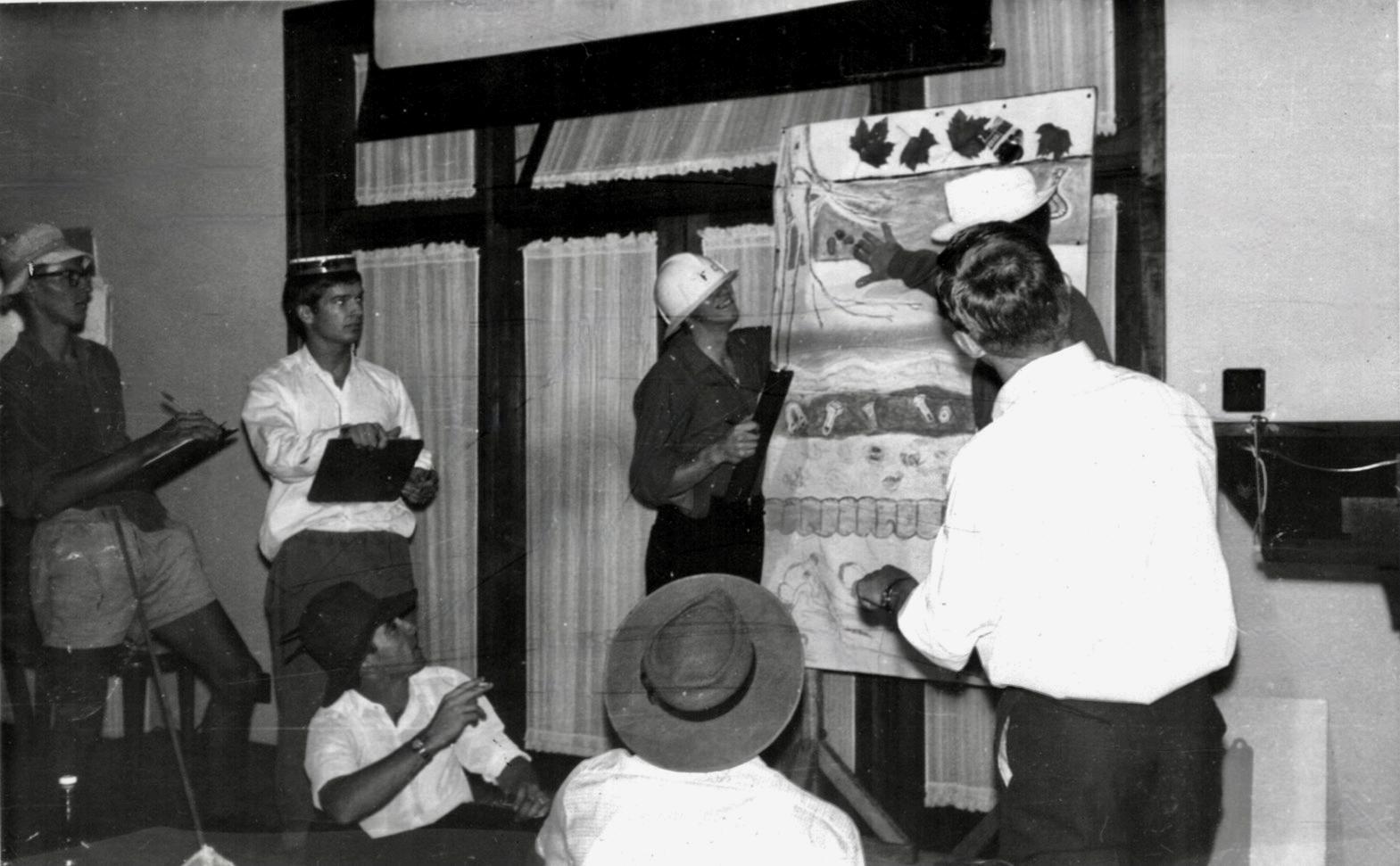
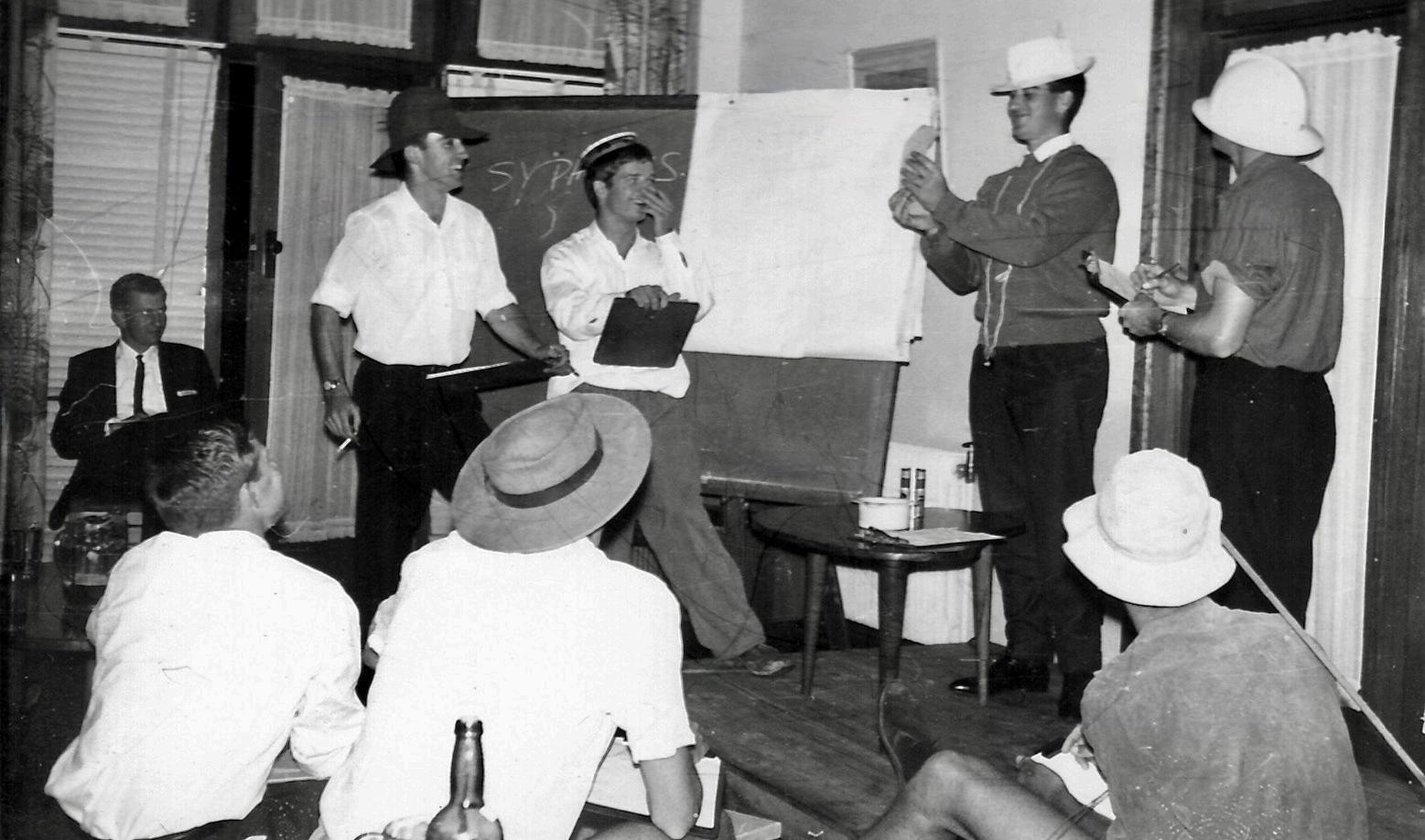
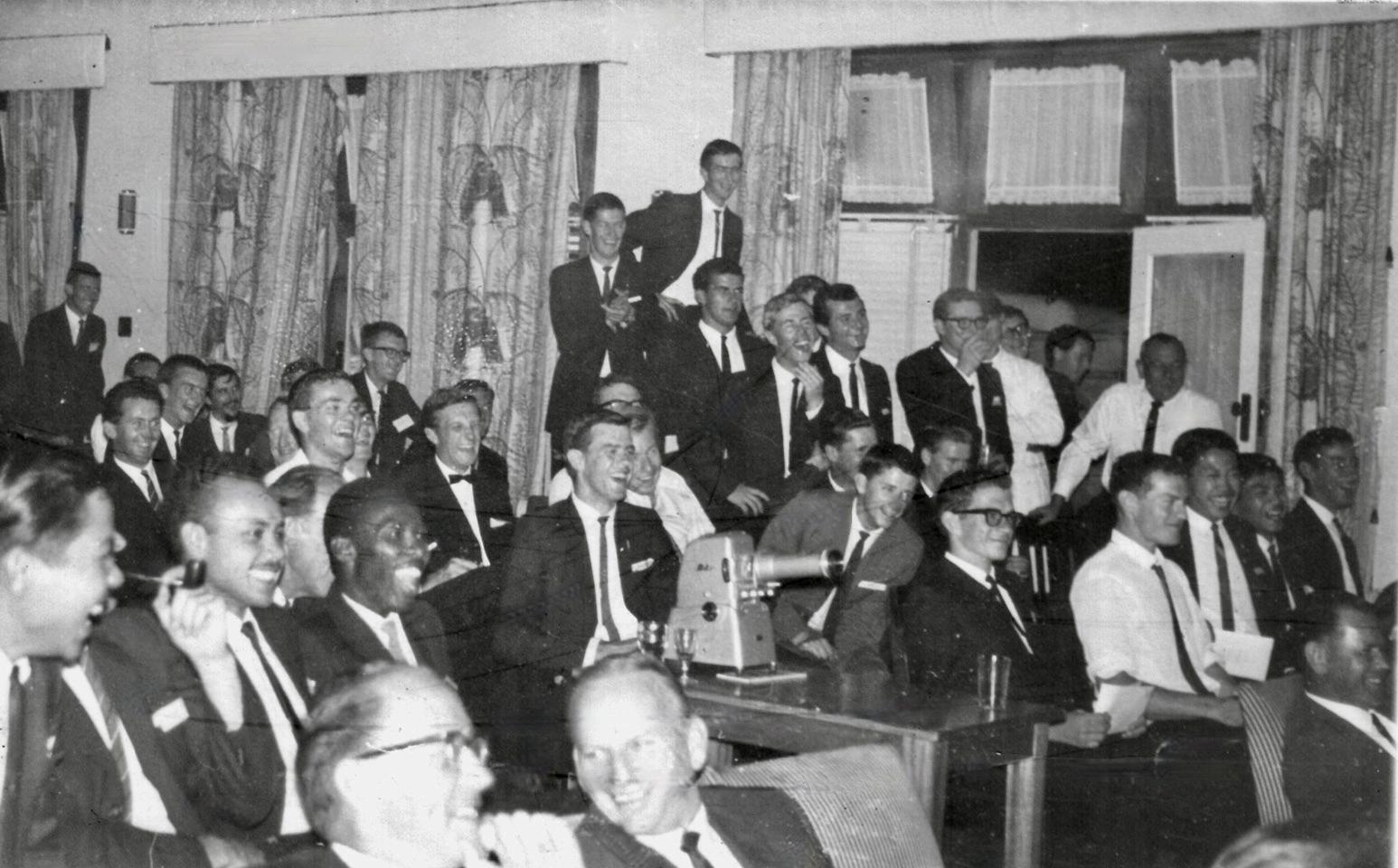

“Growth Habits of the Eucalypts”.
Third Term ended after the finish of examinations on 11 December. On 12 December, I set out on the drive to Armidale, with only a week remaining before our wedding.
Among the individual subject results for 1965 were some outstanding achievements of a number of students (only students gaining High Distinction (HD), Distinction (D) and Credit (C) grades are listed here in rank order; other students not listed here were graded with a Pass (P)):
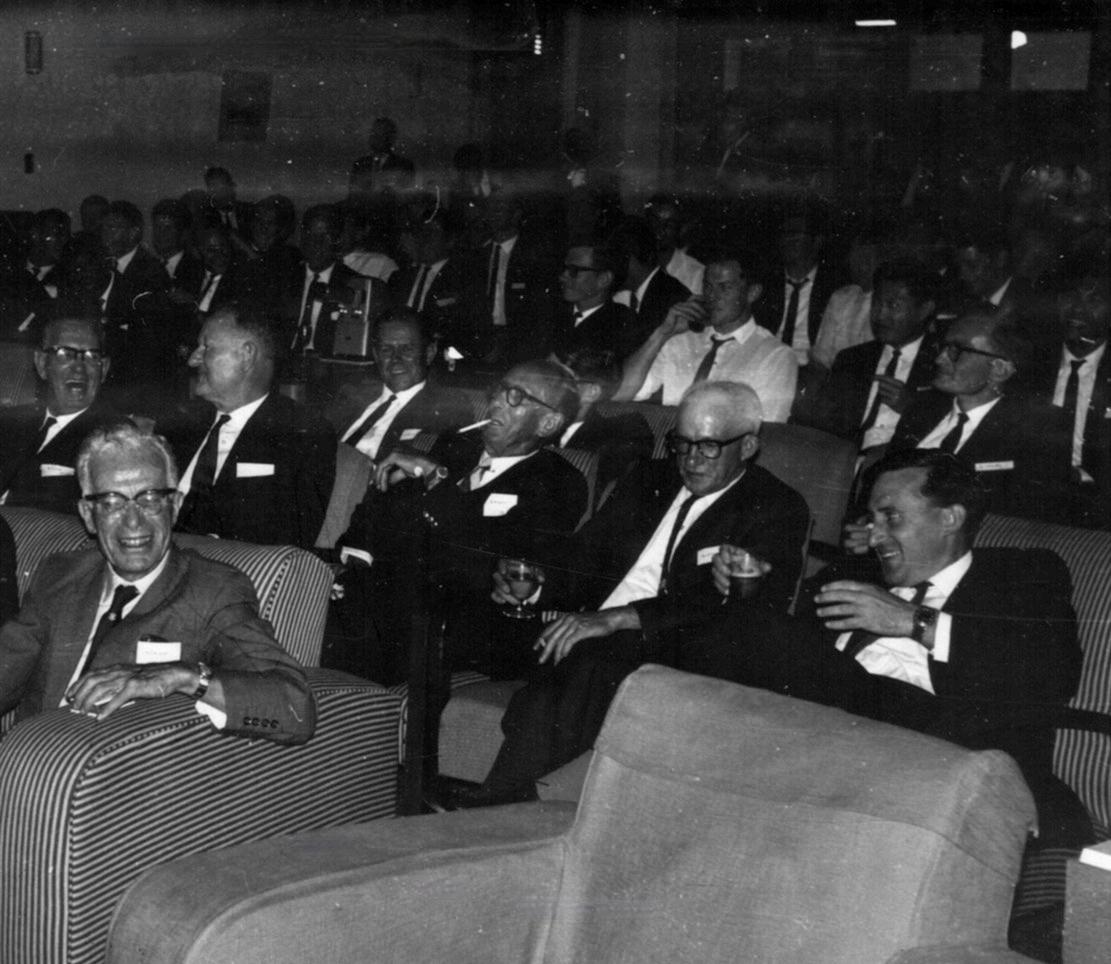
Pathology: Sands D, Davidson C, Boomsma C; Fire Control: Sands D, Davidson D, Meakins D, Siemon D, Boomsma D, Barwick D; Statistics: Sands HD, Bowyer HD, Barwick HD, Meakins D, Siemon D, Vowles D, Dundon D, Hodgson D, Davidson C, Chuong C; Engineering: Davidson D, Sands D, Bowyer D, Siemon D, Hodgson D, Barwick D, Chuong D; Forest Management: Siemon D, Barwick D, Davidson C, Sands C, Vowles C, Dundon C; Wood Anatomy: Davidson D, Boomsma D, Sands C, Meakins C, Bowyer C, Siemon C; Forest

Policy: Davidson HD, Sands HD, Vowles HD, Boomsma HD; Forest Products: Davidson HD, Sands D, Meakins
D, Bowyer D, Seimon D, Vowles, D, Boomsma D, Hodgson D; Silviculture: Davidson HD, Sands D, Meakins
D, Bowyer, D, Vowles D, Boomsma D, Dundon D, Barwick D; Forest Finance: Sands HD, Vowles HD, Davidson
D, Meakins D, Bowyer D, Siemon D, Boomsma D, Barwick C; Aerial Photography: Davidson D, Sands D, Boomsma D, Dundon D, Hodgson D, Barwick D.
Since the University opposed the number and structure of the units as inappropriate for a university degree, these and other results were distilled into the single grade for BSFOR Forestry III in 1965. I was given a “D” (Distinction), which was formally notified in an “Advice Slip” dated 16 December 1965 and posted to my home in Clybucca. These results were recast again in 1967 to give a separate grade for each of Forestry IIIA and Forestry IIIB.
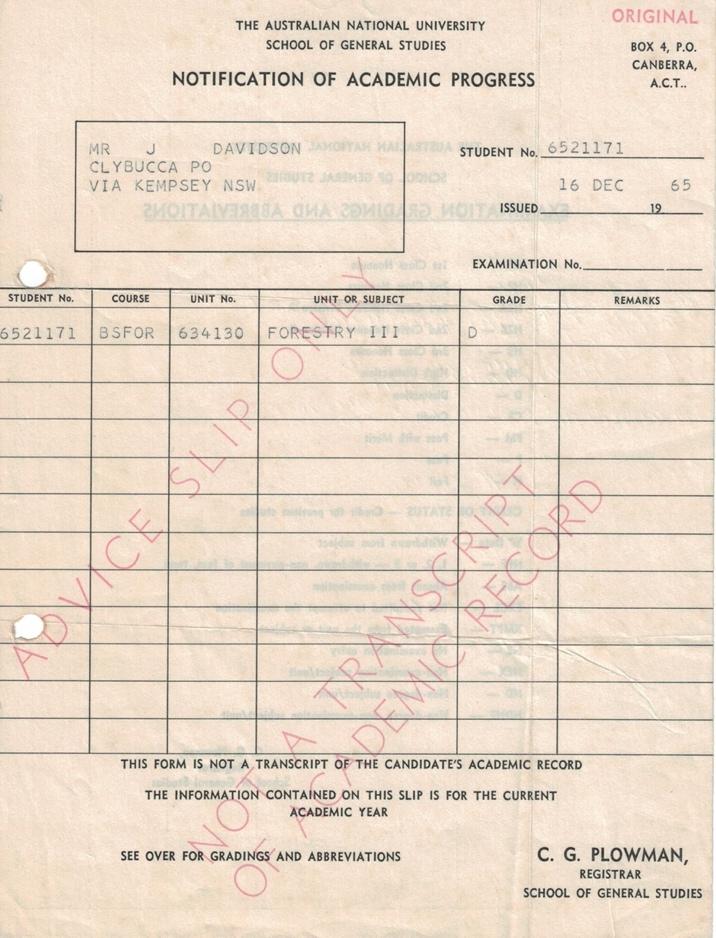
At the end of 1965 three ex Fourth Year students/ex TP&NG Cadets, Chris Borough, Bob Bruce, and Rex Grattidge left Canberra to take up their posts in the Territory. John Harrison completed his forestry degree in 1965 but did not go back to TP&NG after graduation. During his field year in 1963 he was bitten by a Papuan Black Snake near Brown River Station. After graduation he joined the Division of Wood Technology, NSW Forestry Commission
The Biltmore Stick (BS) cover for December 1965 illustrated the end of the first year of Forestry in the ANU with BSc(For) degrees in Santa’s Christmas gifts bag. Also acknowledged by the two trophies in the bag was Forestry winning the inaugural ANU Interhall Cup ahead of Bruce, Burton and Lennox Halls and the award of the Canberra Day Cup in 1965.

Staff member, and my eventual PhD supervisor, Bill Heather, was awarded his PhD in 1965.
This issue of the BS sent best wishes to me and Ron King for our upcoming marriages.
It was recorded in this BS that Norman Hall’s roneos supplied to the Fourth Year men in 1965 reached a new annual record “… as the most monumental and voluminous work to stem from the quill of one
man”. Research showed 5.433 miles (8.74 km) of roneos had been issued, some 850 foolscap pages for each student!
Data collected on excursions undertaken during 1965 showed the diversity of student enlightenment: “24 sawmills of fantastic variety, 2 eucalyptus oil distilleries of Ned Kelly vintage, 3 pole preservation plants, one charcoal burning setup, one engineering workshop, 2 quarries, 2 power stations, 2 plywood factories, 3 truss manufacturers, 3 paper (±pulp) mills, 5 other assorted wood sheeting material manufacturers, and 14 forest nurseries”!
An all-pervading jingle was on everyone’s mind during most of 1965. This was to advertise the impending introduction of decimal currency in Australia. The jingle was sung to the tune of “Click Go the Shears” with lyrics written by Ted Roberts. “Dollar Bill” (below) led the publicity campaign.
“In come the dollars and in come the cents to replace the pounds and the shillings and the pence. Be prepared folks when the coins begin to mix on the 14th of February 1966.

Clink go the cents folks clink, clink, clink. Changeover day is closer than you think. Learn the value of the coins and the way that they appear and things will be much smoother when the decimal point is here. In come the dollars and in come the cents to replace the pounds and the shillings and the pence. Be prepared folks when the coins begin to mix on the 14th of February 1966.”
December 1965 – January 1966
Gloria and I were married in St Pauls Presbyterian Church Armidale on 18 December 1965. Two identical green Ford Falcons carried the bride, groom and attendants. One car was Gloria’s and mine, the other was owned by Gloria’s father Ken Burgess.
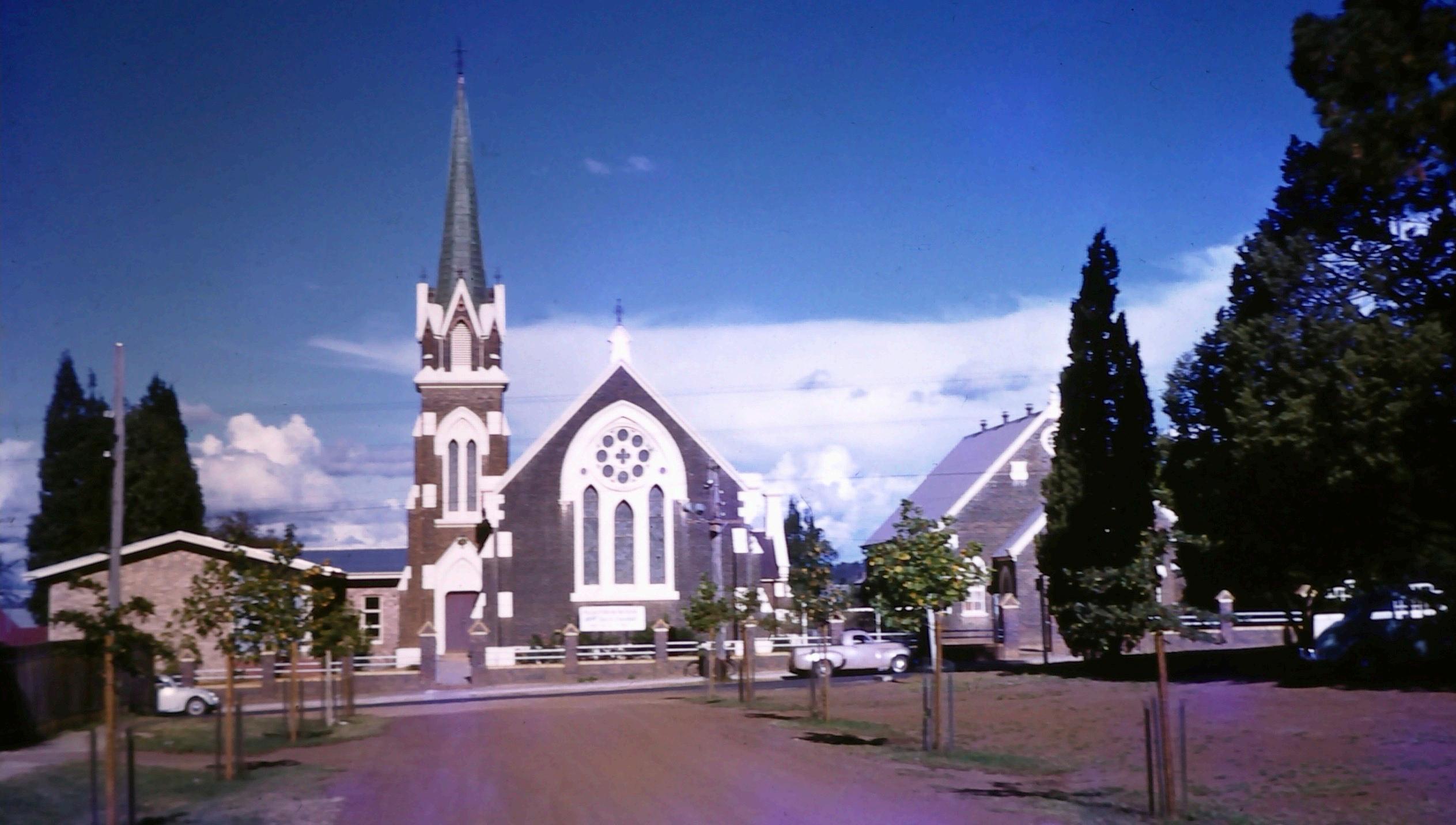
Other forestry student marriages on the same day were Ron and Judy King in Canberra and Col and Sue Nicholson in Coramba, a small village west of Coffs Harbour. Forestry staff member Eric Bachelard and Sally were married in York, Western Australia on 5 January 1966.
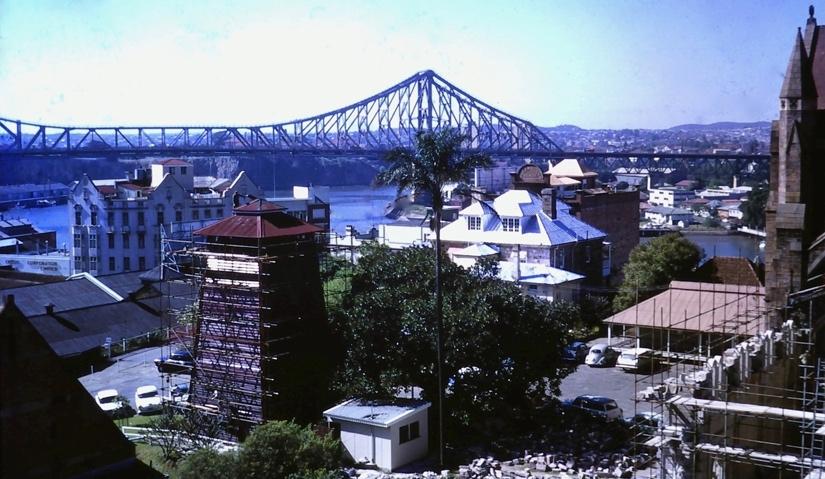
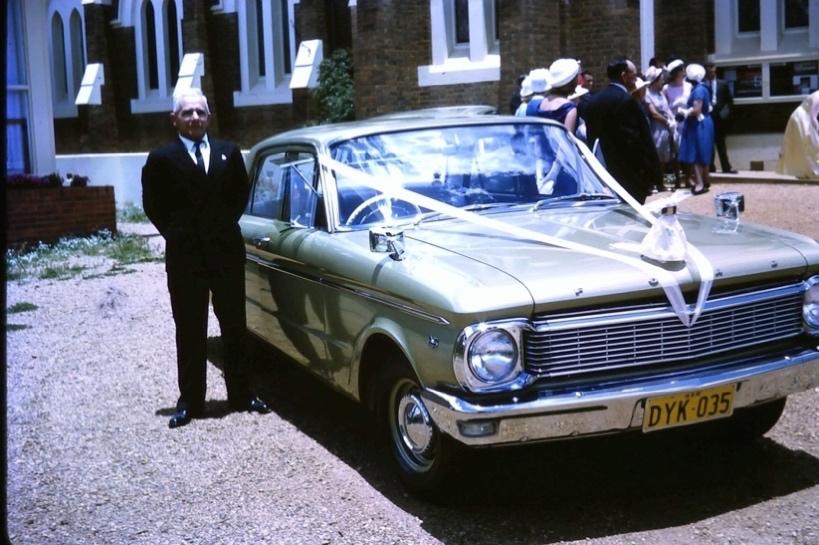


Gloria and I spent our honeymoon on a driving and camping trip from Armidale to Brisbane, then north up the Queensland coast as far as Rockhampton and return. A heavy 3 x 3 m canvas tent, wood poles, pegs etc. were carried in the car boot along with a portable gas stove and a blow-up bed (no fancy lightweight tents and camping equipment in those days!).
Top left and right, and above left: Wedding day photographs. Gloria and her mother made the wedding dress, trains, and veil and bridesmaids’ gowns. Twin cars were used, the one in front for the bride with a small bride doll on the bonnet dressed in a miniature copy of the bridal gown, the second for the bridesmaids with two small bridesmaid dolls on the bonnet dressed with miniature copies of the bridesmaids’ gowns. Bottom right: Story Bridge and surrounds, Brisbane, Queensland in December 1965 seen on the early part of our honeymoon.
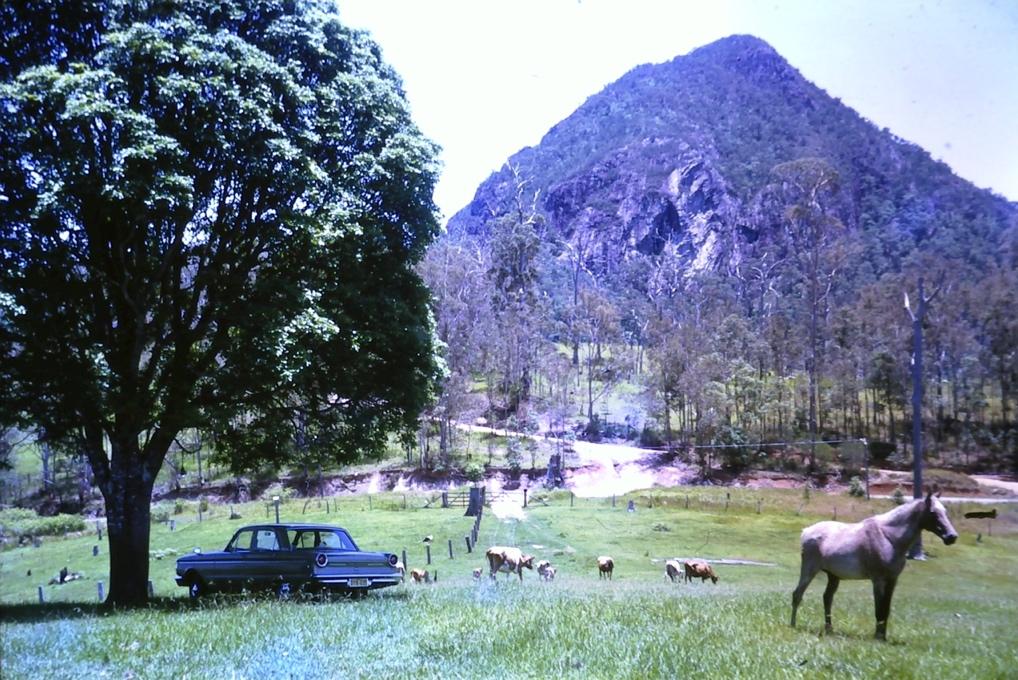
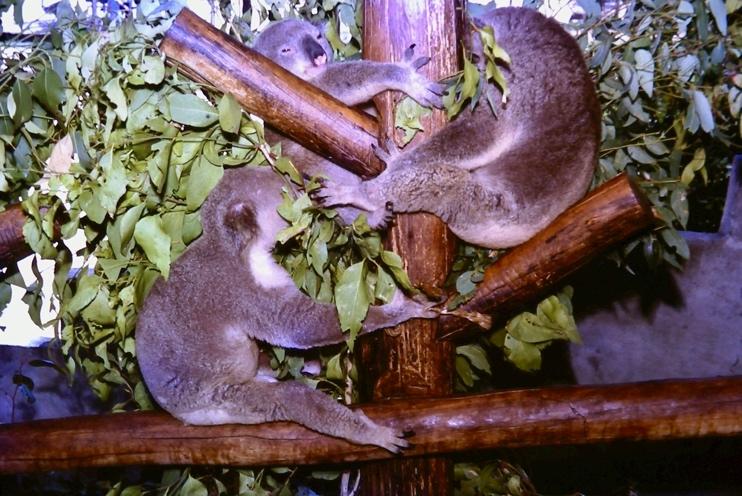

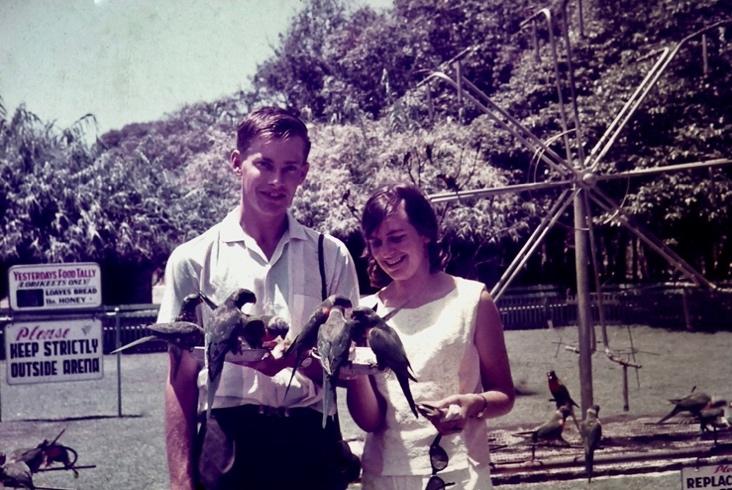

We proceeded through Rockhampton to the Capricorn Caves located 23 kilometres north of the city. These limestone caves (right) were one of the largest cave systems known in Australia at the time.
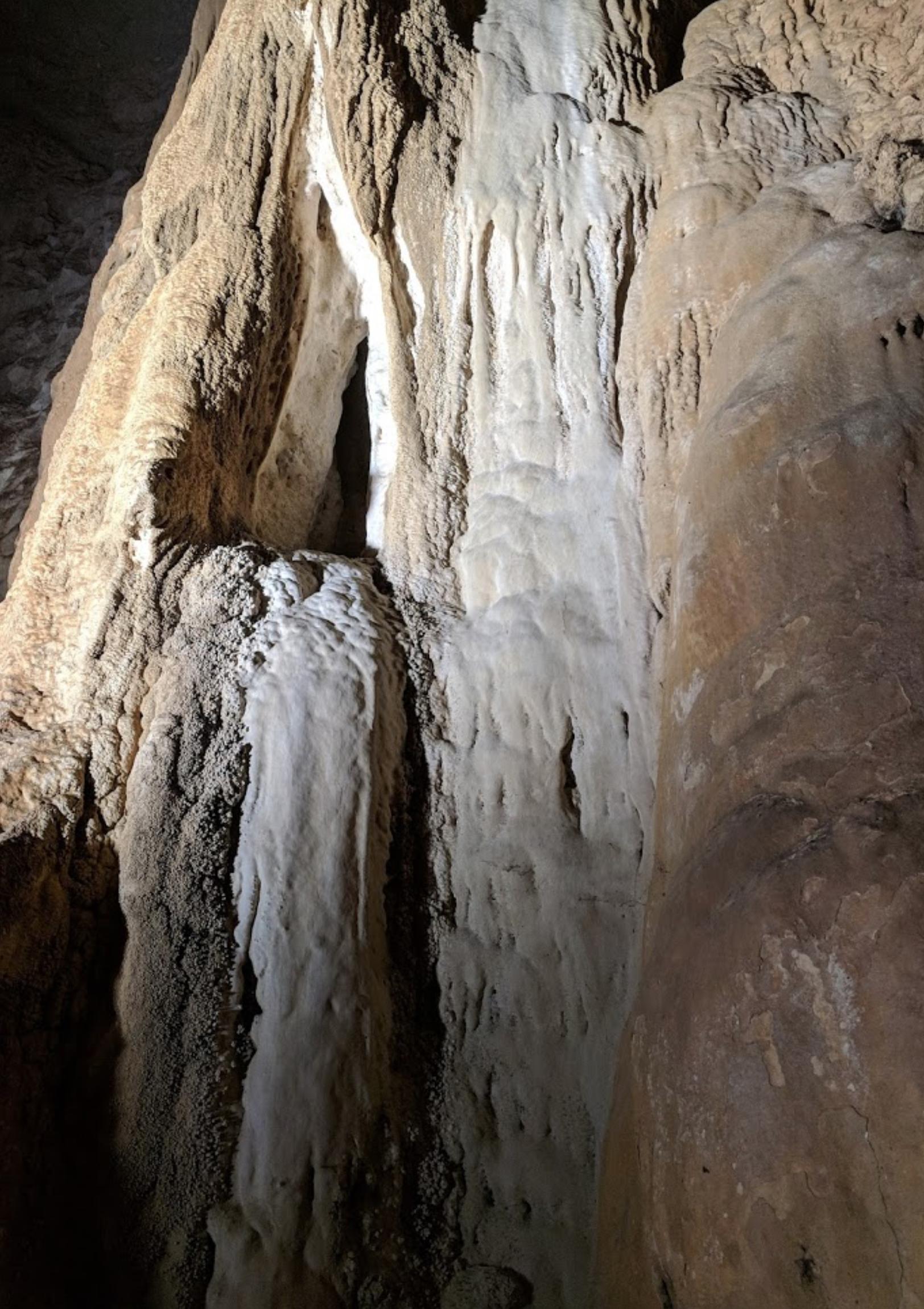

At this point, to allow time to travel back to Canberra, our honeymoon travels had to end and we began to retrace our steps back to Armidale and on to Canberra.
On arriving in Canberra in January 1966, Gloria and I moved into an attached one-bedroom flat at the rear of 3 Deane Street Yarralumla. This flat was the one vacated by Chris and Robyn Borough and their daughter Janet earlier on their departure for Papua and New Guinea, after Chris had finished his final year Cadetship at the Australian Forestry School. The relatively seamless transition into this flat was very convenient since it was only a five-minute drive to the Forestry School in Banks Street, Yarralumla. It also had its own off-street carport.
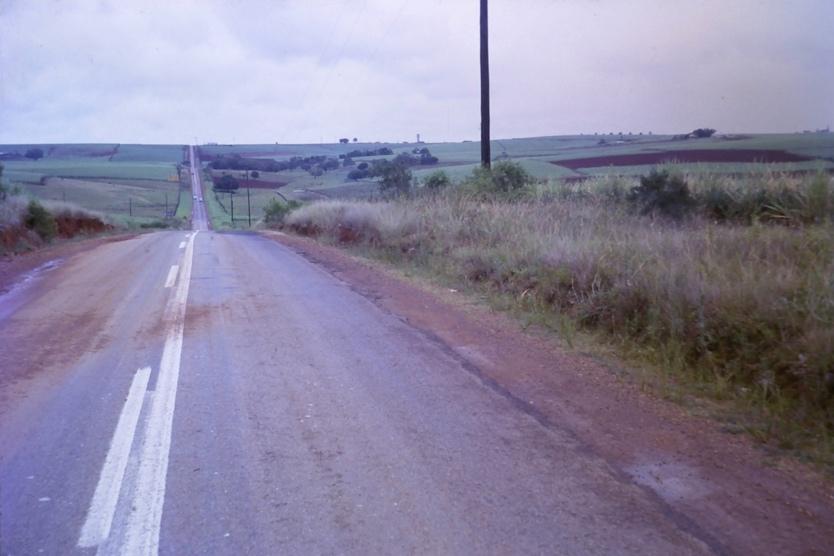
As we were setting up house, what was noticeable in all the shops was the dual price ticketing for the former and decimal currency.




The main shopping centres then were Civic, Kingston and Manuka. The only shopping mall was the three-level Monaro Mall in Civic, dominated by David Jones (left).

in January 1966. In February a Soviet spacecraft lands on the moon.
Australia (and PNG) on 14 February 1966.
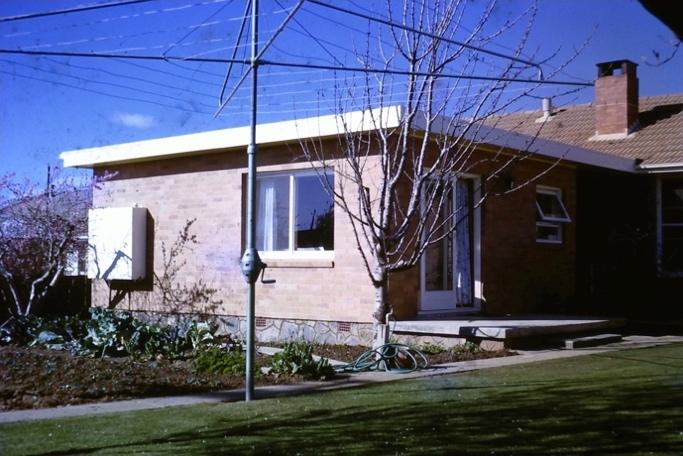

From the beginning of my Cadetship in 1962 there was concern among serving expatriates that their careers would be cut short well before retirement age. From the early 1960s, the Public Service Association of the Territory of Papua and New Guinea (PSA) had held discussions with the Australian Government about the future of expatriate officers serving in the Territory. In 1962 assurances were given that the Commonwealth intended to protect the superannuation entitlements of serving expatriate officers. Also “[permanent] expatriate … officers who continue to serve in the Territory in carrying out the Government’s intention .. and whose careers are terminated before normal retirement age for the sole reason that they are replaced by people serving under local conditions, will be assisted to provide other employment or will be provided with reasonable compensation for loss of employment.”8 However, the PSA remained dissatisfied and pressed for a detailed and formal scheme to provide compensation. Although the Department of Territories was somewhat sympathetic to the PSA demands, the then Minister for Territories C E Barnes9 presided over the phasing out of the Cadetship programme from 1963 and the cessation of permanent appointment of expatriates to the Territory Public Service from September 1965, allegedly to limit further exposure of the Commonwealth to future claims of compensation for loss of career.
Between 1962 and March 1965, 570 permanent officers resigned - over 10% of the expatriate government workforce – and the contract expatriate staff members that replaced them were less experienced. Barnes informed Cabinet that “…the effectiveness of the public service is declining. An ever-increasing proportion of new staff has to be set-off against wastage with the result that the overall net gain needed to achieve the aims of policy is becoming more difficult to maintain.”10 Minister Barnes further pointed to “a continuing need after selfgovernment for at least some Australian permanent officers of the present Territory Public Service.” He therefore recommended to Cabinet the adoption of a prescribed scheme of compensation, to which Cabinet gave in-principle support after considering a favourable report from an interdepartmental committee and after an independent expert also endorsed Barnes’ original scheme as being the most appropriate of several proposals.11 A Paper on the scheme was issued by the Minister on 7 June 1966.12
8 Page 35 In Doran S R (ed) 2006 Documents on Australian Foreign Policy. Australia and Papua New Guinea 1966 – 1969. Australian Department of Foreign Affairs and Trade, Canberra.
9C E Barnes was an elected Country Party member in the Commonwealth House of Representatives from 1958 to 1972. He served under a number of Prime Ministers: Robert Menzies, Harold Holt, John McEwen, John Gorton and William McMahon. Following on from Paul Hasluck, he was Minister for Territories 1963 – 1968 and Minister for External Territories 1968 – 1972, therefore responsible for the Territory of Papua and New Guinea. In this Ministerial role he began the process to guide the Territory towards independence.
10 Page 35 In Doran S R (ed) 2006 loc. cit.
11 Page 35 In Doran S R (ed) 2006 loc. cit.
12 The Future Security of Permanent Officers of the Public Service. Issued under the Authority of the Minster for Territories, the Hon. C E Barnes, M P, Canberra A C T, 7 June 1966. In late 1968, the Australian Government made an additional attempt to reassure expatriate public servants by translating into law at least the previously informal guarantees of superannuation entitlements.
My Cadetship continues: Australian National University (ANU) 1966
The incoming Fourth Year Class undertook a pre-term field excursion. This ran from 19 to 25 February 1966 inclusive. The trip by road covered parts of the Murray Management Area, the Rushworth Management District, the Broadford Management Area, the Upper Yarra Forest District and Batlow Forest as representatives of the inland forest areas of Victoria and NSW.
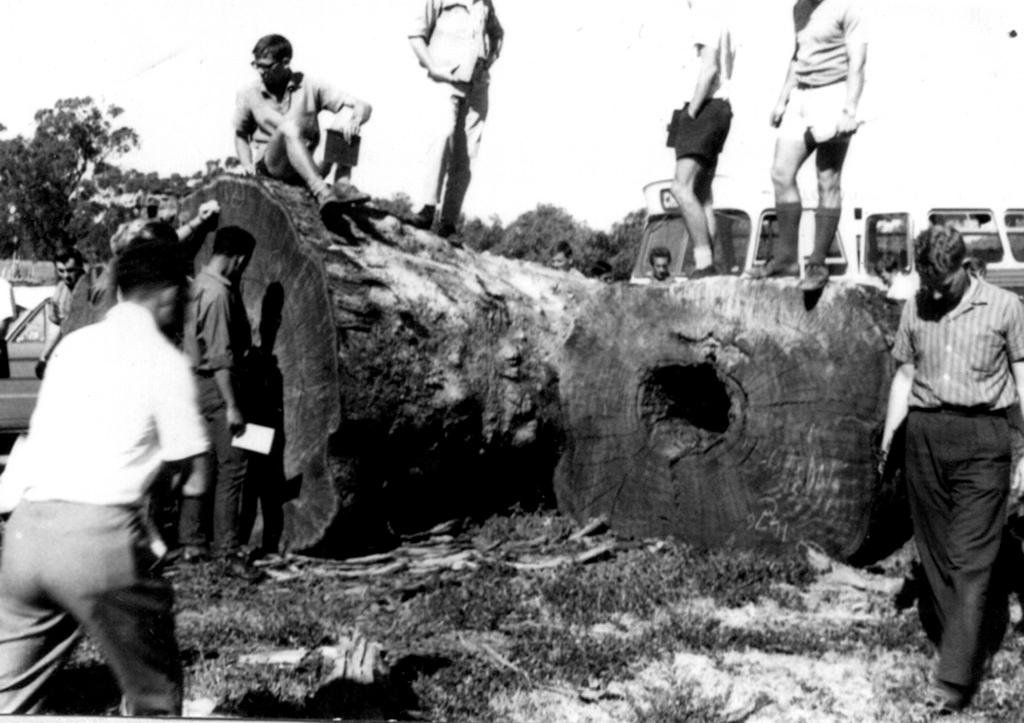
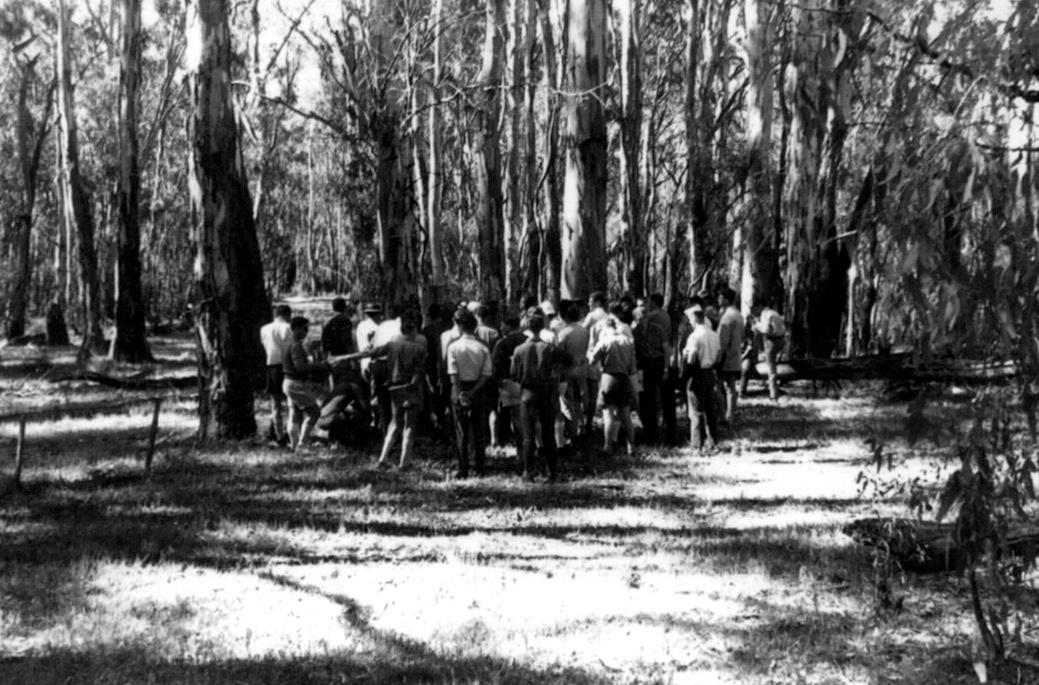
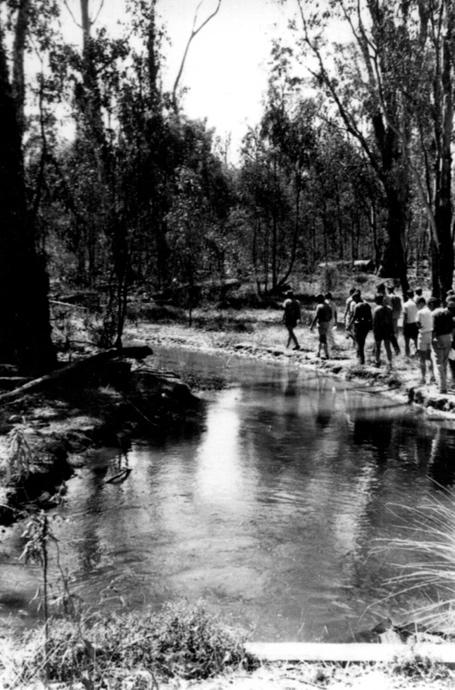
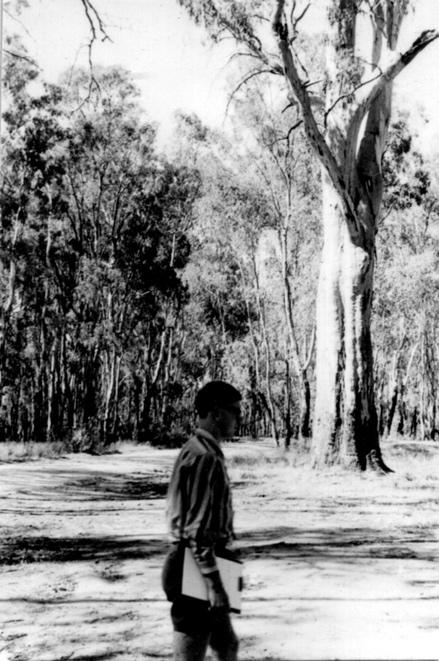
Inland Victoria and NSW Forests Excursion February 1966. Above left: Sawn Red Gum railway sleepers, short lengths and billets in the yard of the Mathoura Mill. Above right: Blue Mallee (Eucalyptus polybractea) grown for eucalyptus oil production
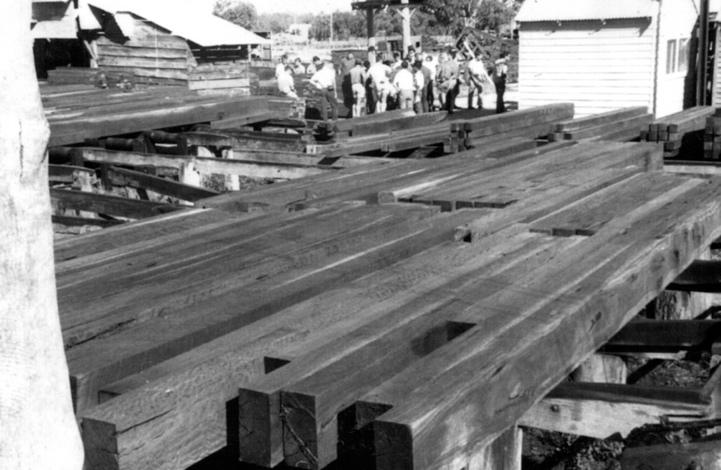
Left: Sample Plot 1, Hills Creek Forest Area, Eucalyptus obliqua, age 56 years, thinned 15 years before the photograph was taken, when the mean dominant height was 105 feet (32 m).
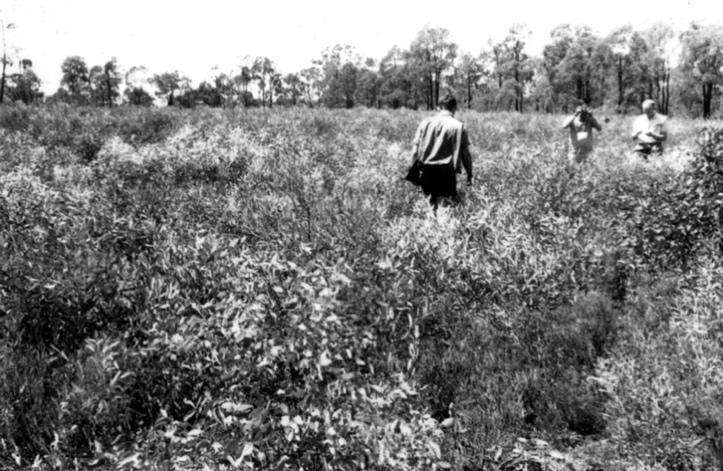
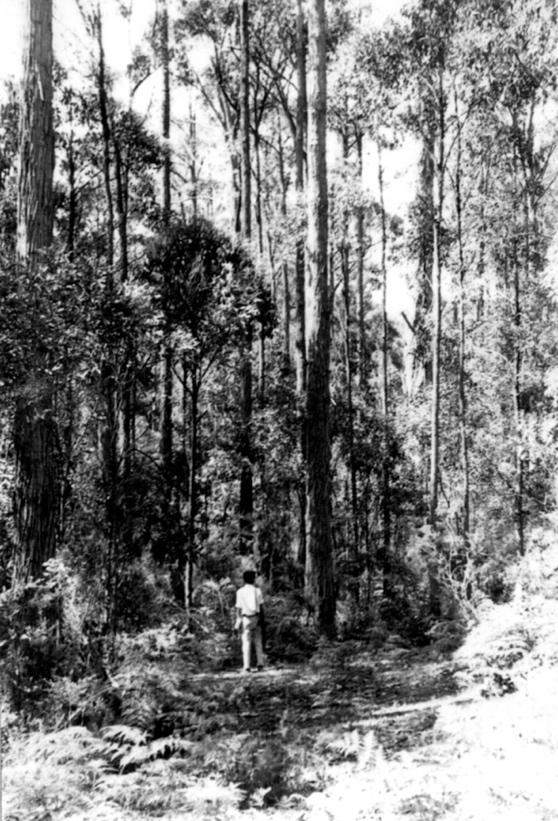
A report was required to be prepared and submitted at the start of First Term. I submitted my 58-page typed and illustrated report (right) on 7 March 1966.

The following is a list of the staff and students of the Department of Forestry ANU in 1966:
Third Year Students:
N G Ashcroft, P E Beaumont, J D Belford, P R Carter, R V Clark, M J Cooper, B Cumberland, J A Dale, J J Douglas, C R Dunlop, H J Elliott, G L Gattera, A R Gobby, K E Gould, G E Grout, A G Hamid, R L Harding, P J Harper, D M Hobson, A J Howe, B A Ismail, P A Jenkins, M E Johnson, G C King, B T Lau, B H Leaver, R B Lyons, R B McCarthy, A McDonald, G. Malajczuk, D R Mutton, L A Newman, D Num, R W Passauer, R G Power, J A Riggs, J B Robinson, R F Robinson, B J Salter, R W Smith, J L Steller, J W Van Pelt, T J Vollbon, J P Wood.
Fourth Year Students:
M R Allen, D S Barwick, A D Benson, T Bird, D B Boomsma, T B Bowyer, L C Cheah, E L Chiswell, P H Chuong, G J Cross, J Davidson, A Dukuno, R L Dundon, P H Emery, M H Farrow, D McD Greve, J L Grimmett, bin I Harun, D G Hiley, P Hitchcock, B S H Hodgson, R Holesgrove, R R Horne, S bin S Ali Ibrahim, R N James, G T Johnson, G A King, D G Knaggs, H N Lewis, J S Meakins, G E Medhurst, C Nicholson, S Noordin, J F Nowill, R K Orme, R H Pfitzner, J G Reynolds, I R Richley, P A Ryan, R Sands, M E Searley, S R Shea, G R Siemon, I R H Telford, M E Temu, L W Traise, M P Udarbe, T A Vowles.
Postgraduate Students: K G Eldridge, R Fenton, W G Forest, B J Furrer, A Gillison, G Goodrick, J E Gray, M L Higgs, C Palzer, I H Sario, M U Slee, R J Thistlethwaite.
Academic Staff: Dr E P Bachelard, Mr W C Boughton, Mr L T Carron, Dr D Colless, Dr R G Florence, Mr N Hall, Mr C D Hamilton, Dr W D Heather, Mr A G McArthur, Mr K P McGrath, Professor J D Ovington, Mr E D Parkes, Dr P Rudman, Dr M T Tanton, Mr D Lamb.

Non-Academic Staff: Mrs V A Boughton, Mrs O M Brierly, Mr C Clements, Mr J A Coley, Mrs J Crawford, Mrs B Driver, Mrs J Fenton, Mrs M Harmey, Mrs T Hill, Mrs C Hogg, Mrs A James, Miss J Johnson, Mr I G McArthur, Mr R Paton, Mrs M E Reid, Mr D L Wilson, Mr A Wood.
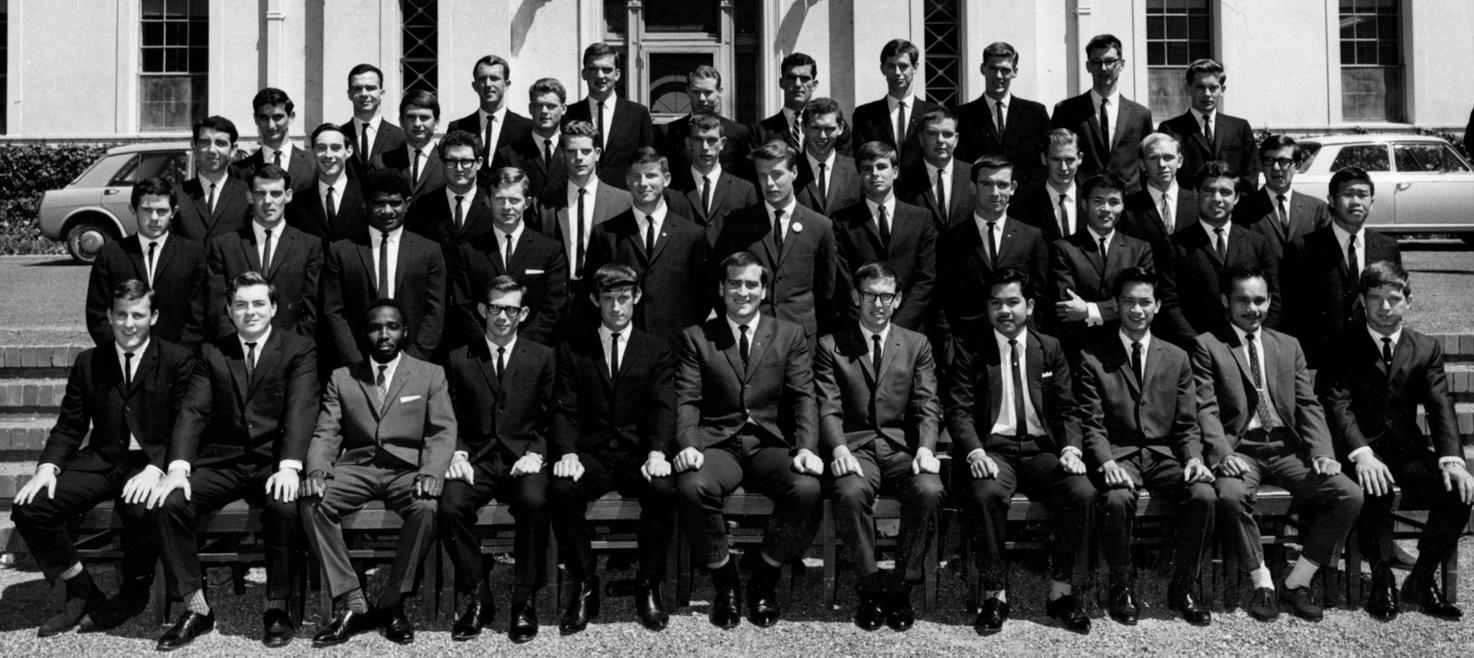
The March 1966 issue of the Biltmore Stick (right) recorded that Rod Holesgrove and Syd Shea had become engaged (not to each other!).
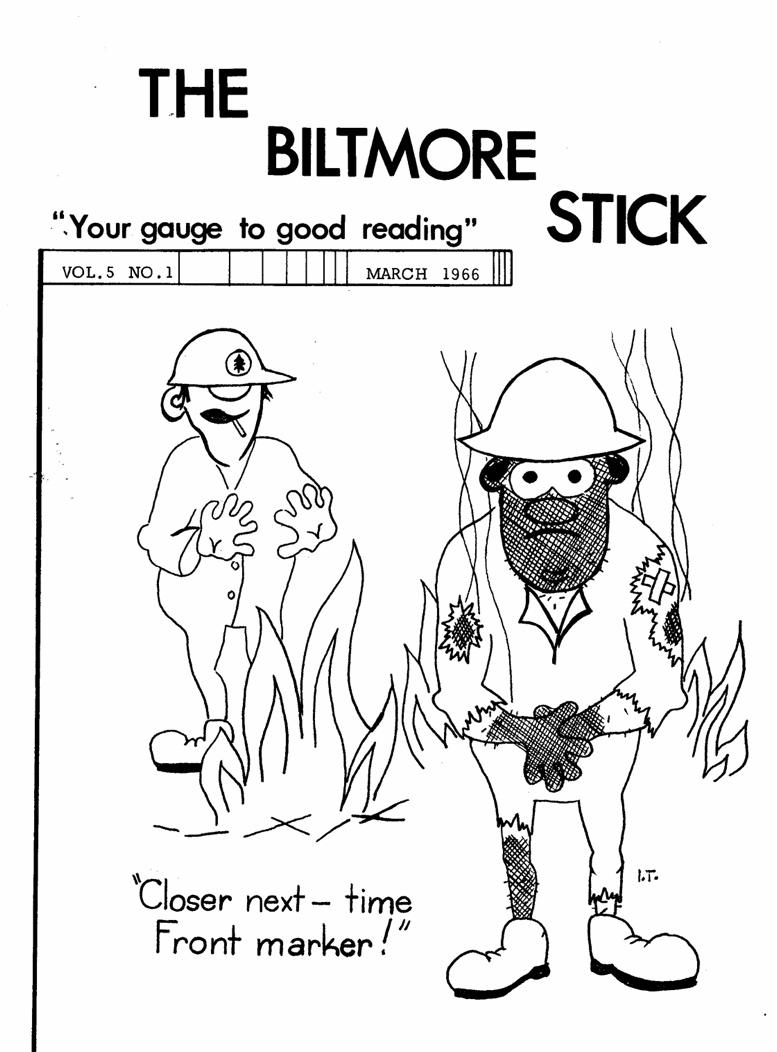
I as head of the Photography Club included a lengthy article on photography with a technical note on “Exposure” and information on the running of the Club’s darkroom.
The main part of the issue was “Meet the Fourth Years – 1966”.
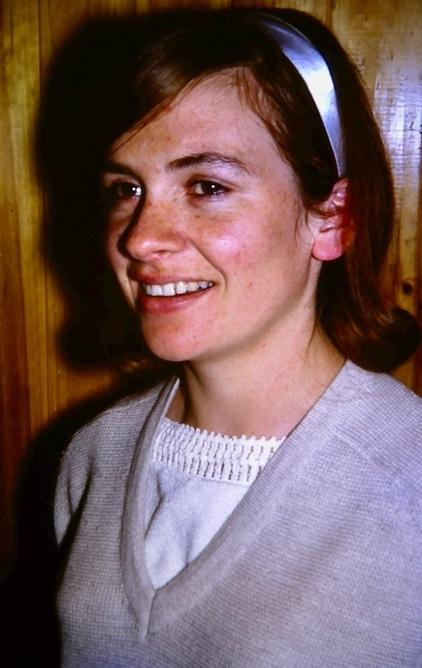
“Mark Allen: Dapper gent often seen swinging cane umbrella. Fluent debater. ‘Dipper’ Barwick: A New Zealand Sioux who prefers car bonnets as resting places and keeps a rapid turnover of young squaws. Dave Benson: Eccentric rules player with up-to-date weather report. “T” – Bird: Master of the impromptu comment who deserves no sacred cows. Dave Boomsma: Noisy bike rider and ace hockeyite. Prefers sarsaparilla and wins arguments with obscure facts. Peter Bowyer: Survivor of the Emry – rollover. Believer in the beauty of empty bottles. Trevor Butcher: Lithe basketballer and hockey player who is always ready with a quick nudge in the kidneys for those with slower reflexes. “Harry” Cheah: Judo extremist who plays a mean guitar. Alcohol produces a chameleon effect. Ernie Chiswell: Avid churchgoer and convertor of disbelievers. A strong contributor in the forwards. “Joe” Chuong: Usually seen with camera poised, but sometimes lowers it to listen to fine stereo music or engage in multilingual conversation. Gerry Cross: Spirogyrical belly dancer and extrovert who is easily recognized by voice alone. John Davidson: Seldom seen since marriage, but since this event has managed to cure darkroom anæmia caused by winter hibernation in studio No. 2. “Saki” Dukuno: Solid easy-going Fijian who conserves energy for regular scoring bursts on the field where he is undoubtedly team morale booster. Ray Dundon: Casual young socialite with suave and salubrious

appearance. Peter Emery: Home gardener with fascination for alluring young staghorns. Survivor of ghastly, concussive, bone-dislocating rollover on Capital Hill. “Flaggy” Farrow: Now seldom seen and known to disappear for long periods. Quo vadis Flaggy? Dave Grieve: Keen crusader of Bruce Hall where he has secured a valuable trophy. “Clarry” Grimmet: Drives a chocolate box and prefers short girls. Ismail Harun: Badminton and soccer player and serious student of religions and stereo music. Graeme Hiley: Wizard on the weights and strong competitor in Pocket Atlas cheesecake competition. Loss of front teeth and crude vocal cords are identifying features, together with voluminous barracking. Peter Hitchcock: Strange ambition to be a forester has produced a keen collector of E. kybeanensis. Hockeyist and collector of insurance cheques. Brian Hodgson: Rower, sailor, flier and parachutist. Obviously suffers from a height and speed fixation. Rod Holesgrove: Comes unstuck and performs wild gyrations at parties. “Roscoe” Horne: Tolerant domesticated lion who finds expression at squash. “Sheik” Ibrahim: Nippy squash and basketball player sporting a trim mustache to unsettle his opponents. Ride James: Room horticulturalist, expressive listener and sympathizer of lost souls. “Doctor” Johnson: Versatile tennis, squash and golf player who always makes it to the 19th “Gak” King: Gangly beast with long internodes. Indulges in champagne room entertainment. Dave Knaggs: Gambler extraordinary. Even won the conscription ballot. “Jock” Lewis: Sports savage hate for Mini accelerator. Social man with self-taught knowledge of “who’s who at the ANU”. John Meakins: Member of the early breakfast club and a sailing and water enthusiast with an obscene camera. “Mudza” Medhurst: Remarkable ability to imitate logs on field trips but has been known to move fast on the soccer field or on wheels. Col Nicholson: A winner on the poker machines who is now trying his luck at love and marriage. His absence from Forestry House allows runners-up to compete for the untidiest room title. Sulaiman Noordin: Soccer and hockey player engaging in sly and silent room orgies. “Fred” Nowill: Voluntary wallflower and engager in earnest conservation at parties. “Biggles” Orme: Can indoctrinate on any aspect of the art, languages or politics with iconoclast tendencies. Photographs well (and often). Roger Pfitzner: Well tanned runner and basketballer with gift of discretion who has been known to blush. John Reynolds: Able cricketer with gout which masquerades as football knee injury. Lindsay Richley: Falsetto soccer player who can’t help grinning back at you. “Ugga” Ryan: Holds record for longest and loudest out-of-tune sing-song. Better kept at distance from microphones. Roger Sands: Bespectacled academic whose rapid brain turnover requires heavy feeding. Mick Searley: Large size footballer who hates practice and dabbles in modern art. Sid Shea: Red headed Westralian of Irish descent suffering periodic attacks of depression due to the width of Australia. Graeme Siemon: Healthy 5BX-er of varied sporting talents but lacking the killer instinct. Ian Telford: Rower with loud belly laugh and more field experience than most. Marco Temu: Bearded bod whose serious oratory boo-boos seldom fail to raise a laugh. Ken Traise: Usually looks tired but makes amends on the football field. Has a pen friend at Armidale. Marcelo Udarbe: Slim, good-natured gent with beautiful wife. Characteristic butterfly net technique is worth watching. Terry Vowles: Sporting interests table tennis and water fights. Spherical outline is an early adaptation to eventual position of Conservator.”
The office bearers of the ANU Forestry Students’ Union for 1966 were: President: Professor J D
Ovington, Vice President: Gerry Cross (Vic.), Secretary: Dave Barwick (NZ), Treasurer: Dave Boomsma (SA), Social Secretary: Ray Dundon (SA), Social Treasurer: Graeme King (Qld), Social Committee: Dave Benson (ACT) and Malcolm Farrow (NSW), Canteen Committee: John Grimmet (Qld), Ken Traise (NSW) and Graeme Medhurst (NSW), Auditors: John Davidson (NSW/PNG) and Ross Horne (ACT).
The 1966 Forestry students’ float for the 1966 Canberra Day procession was “Prince Charles at Timbertop; Cherry Brandy Charlie”. Prince Charles spent two terms (6 months, February to July 1966) at Timbertop, which was a branch of the Geelong Church of England Grammar School. Involved in a bout of underage drinking (he was 17!) at Timbertop he gained the nickname “Cherry Brandy Charlie”.
For me, major fieldtrips continued. One was to Queensland. We travelled by train from Canberra to Sydney, then on an over-night sleeper train from Sydney to Brisbane where we were met by a pair of
Commonwealth buses. The tour was concentrated on the planted forests around Beerwah and was organized by the Forest Department of Queensland.

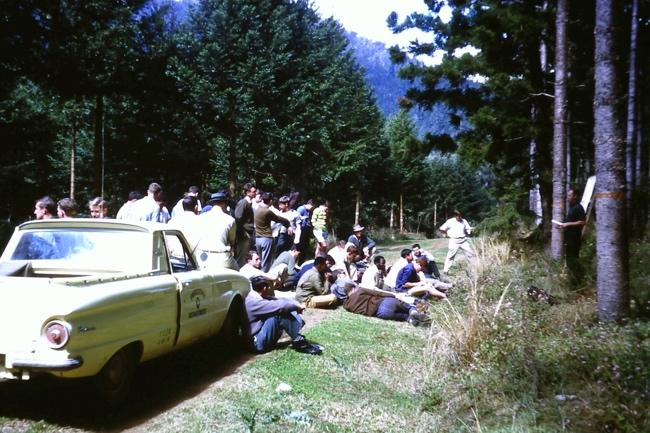
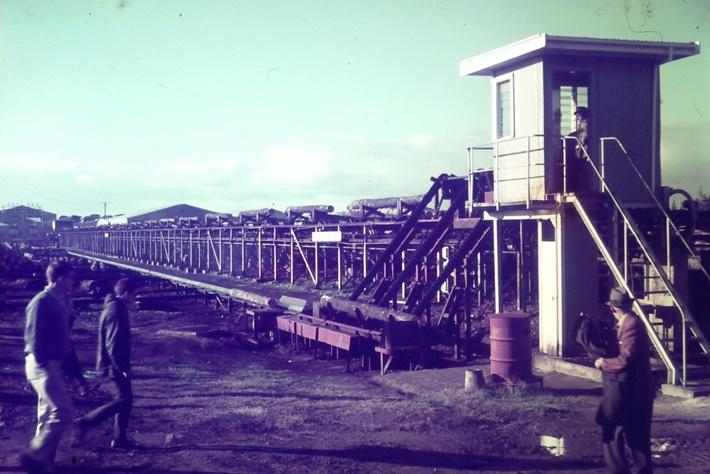


In 1966, a documentary film on forestry in Papua New Guinea called Tree Business was released (details at left.) Later over the period 1969 – 1971, I was requested to show it in 16mm format at several venues in Canberra while I was working on my PhD.


A heavy snowfall occurred in Canberra in the winter of 1966. Left: Me. Above: Black Mountain, Black Mountain Peninsula and Lake Burley Griffin observed from the intersection of Schlich Street and Banks Street, Yarralumla.
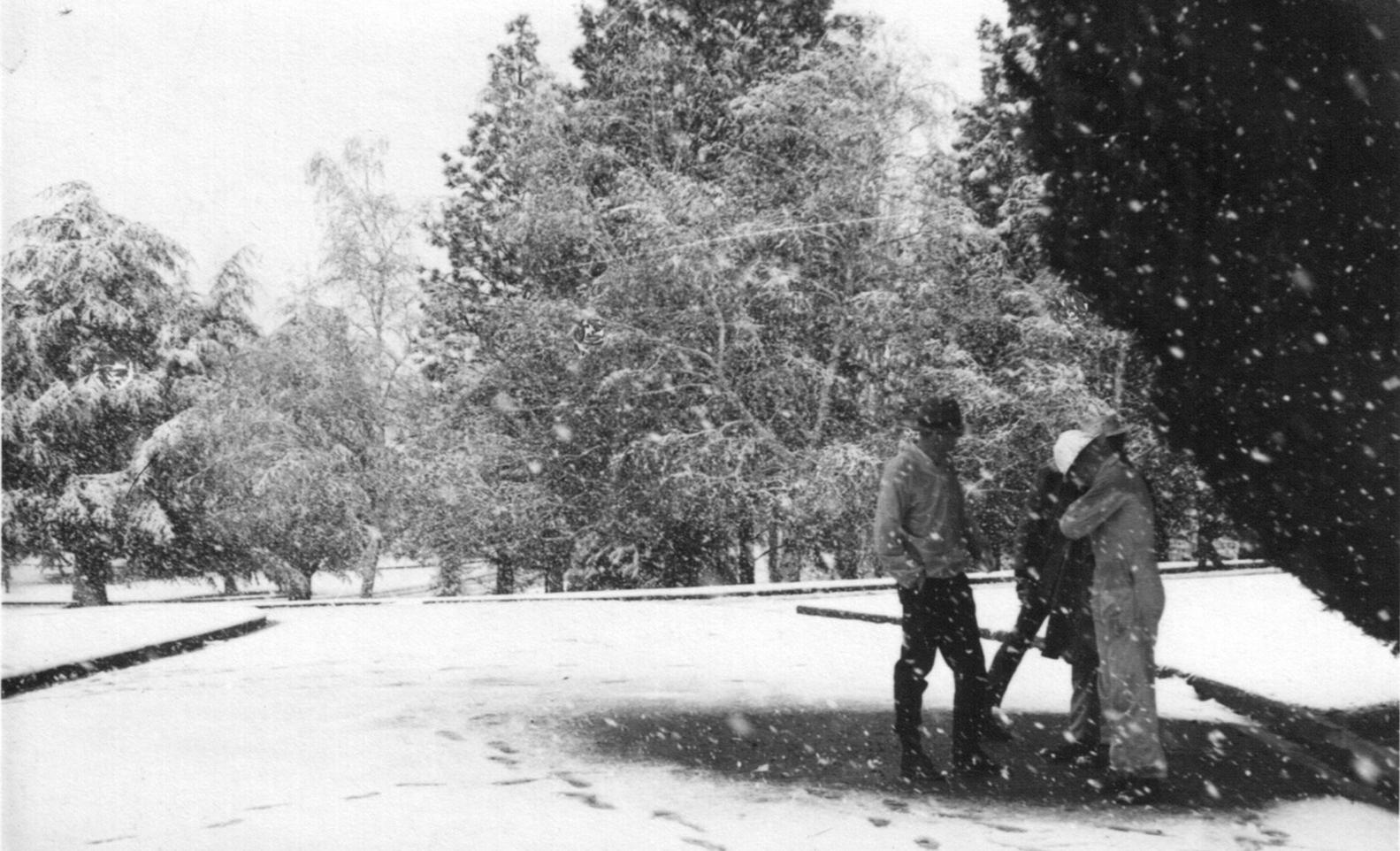
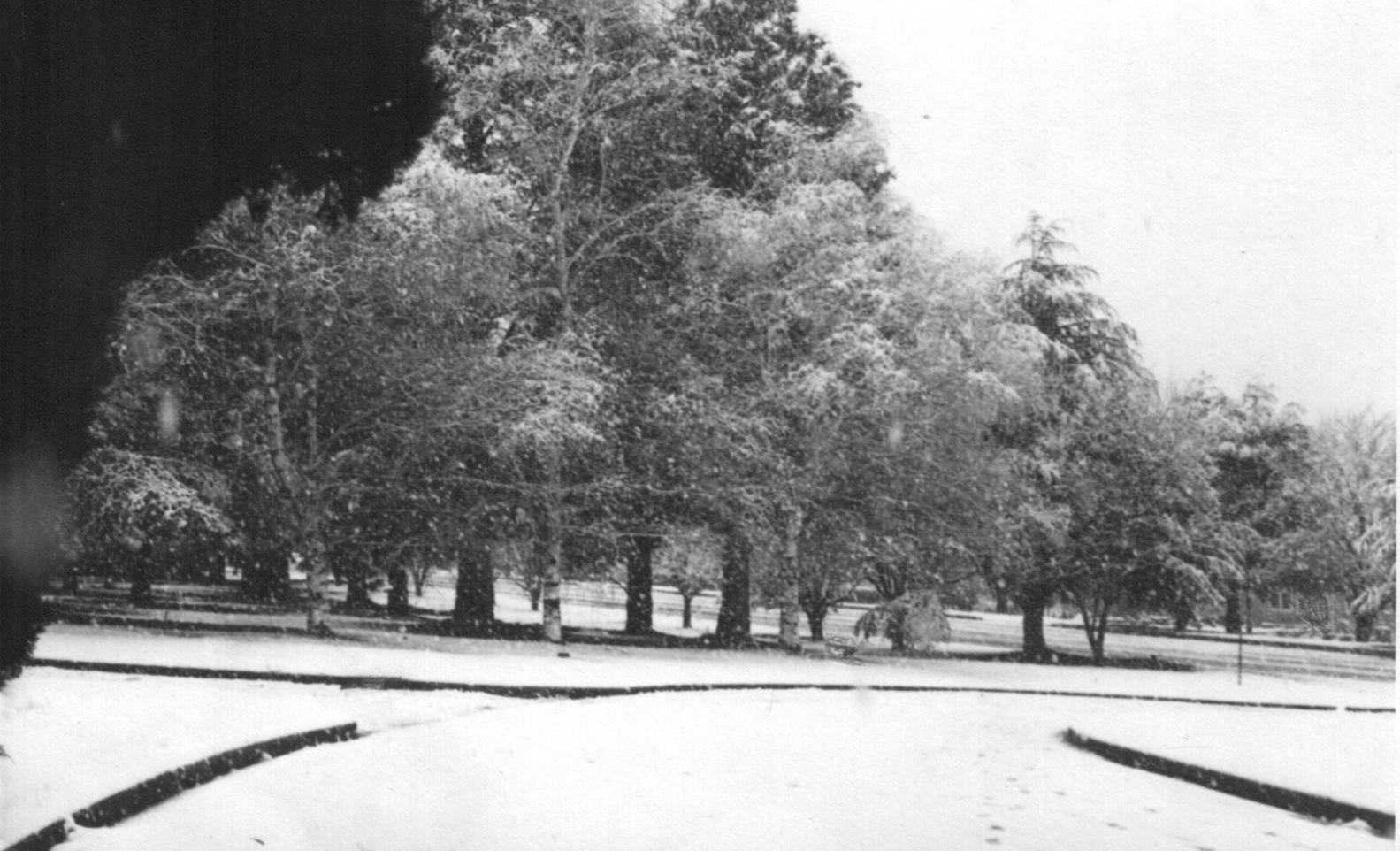




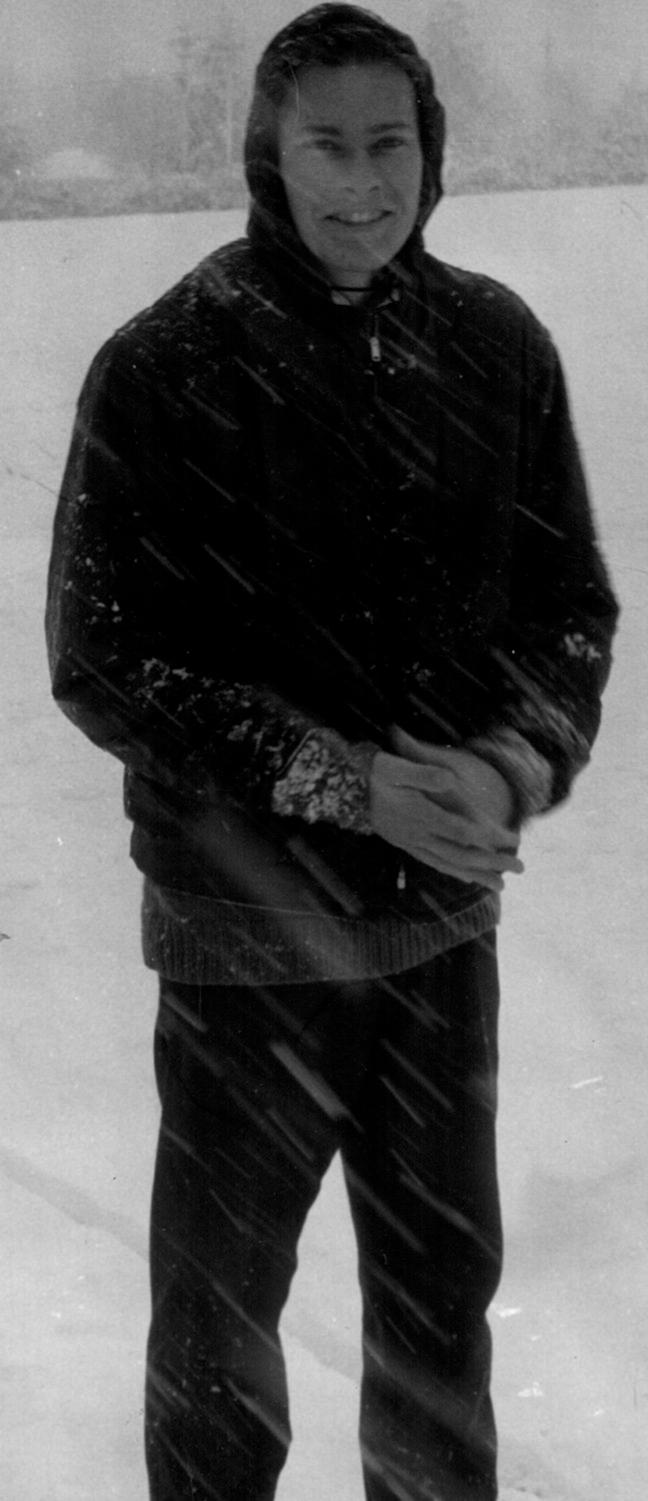
Left: Australian Forestry School building, forecourt and Banks Street Yarralumla under a carpet of snow, winter 1966. Right: The takeover is official! An Australian National University Department of Forestry sign goes up outside the former School building. Sid Shea (student, WA) takes a close look in the snow.



Gloria applied for a position at the Forestry and Timber Bureau in that part of the staff which was housed in the former Australian Forestry School Principal’s tudor–style residence13, about 100 m north of the School. She was successful. This appointment had the added advantage that both Gloria and I could drive to work together and take less than five minutes to do so from our flat in Deane Street in the same suburb. Soon after, Gloria was promoted to the post of Personal Assistant to Dr Max Jacobs, Director General of the Forestry and Timber Bureau, a position she held until she left to join me in Papua and New Guinea in April 1967.
13 Westridge House, also known as the “Tudor House”, was built in 1927 to house the Principal of the Australian Forestry School. The then Principal, Lane-Poole, chose the architect, Harold Desbrowe Annear of Melbourne. Like the Forestry School building, it was designed to show the best of Australian timbers, with jarrah floorboards and exposed beams. It was purchased by CSIRO in 1975 and used by CSIRO staff. It was restored after a fire in the late 1970s and again from 2000-2006 converted back to a residence in order to comply with listing in the Register of National Estate. In December 2010, it was sold for $3.2 million to a private buyer and sold again in 2018 to Jaehee Choi for $6.05 million.
Left:
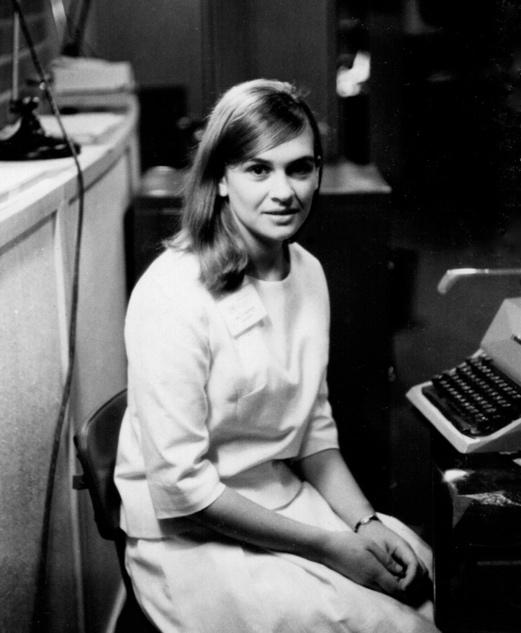
1966, former residence of the Principal of the Australian Forestry School Yarralumla which became office accommodation for some staff of the Australian Forestry and Timber Bureau, Department of National Development. Dr Jacobs’ office was in this building (he was also the last Principal to use it as a residence). Right: Gloria, Personal Assistant to Dr Jacobs from early 1966 to April 1967, in her office in Westridge House.

Another major field excursion was to Pine Creek State Forest near Coffs Harbour in northern NSW. This time the fleet of Commonwealth VW combis, Landrovers and other vehicles (above) was used to travel by road from Canberra. Travelling in one vehicle on the Pacific Highway north of Kempsey, I was able to call in to the farm at Clybucca briefly on the way past. At Pine Creek several long-term plots in predominantly Flooded Gum (Eucalyptus grandis) forest were re-measured. Some plots were re-thinned or had other treatments applied or reapplied, building on work done much earlier by Dr Jacobs when he was lecturer in Silviculture at the Australian Forestry School.
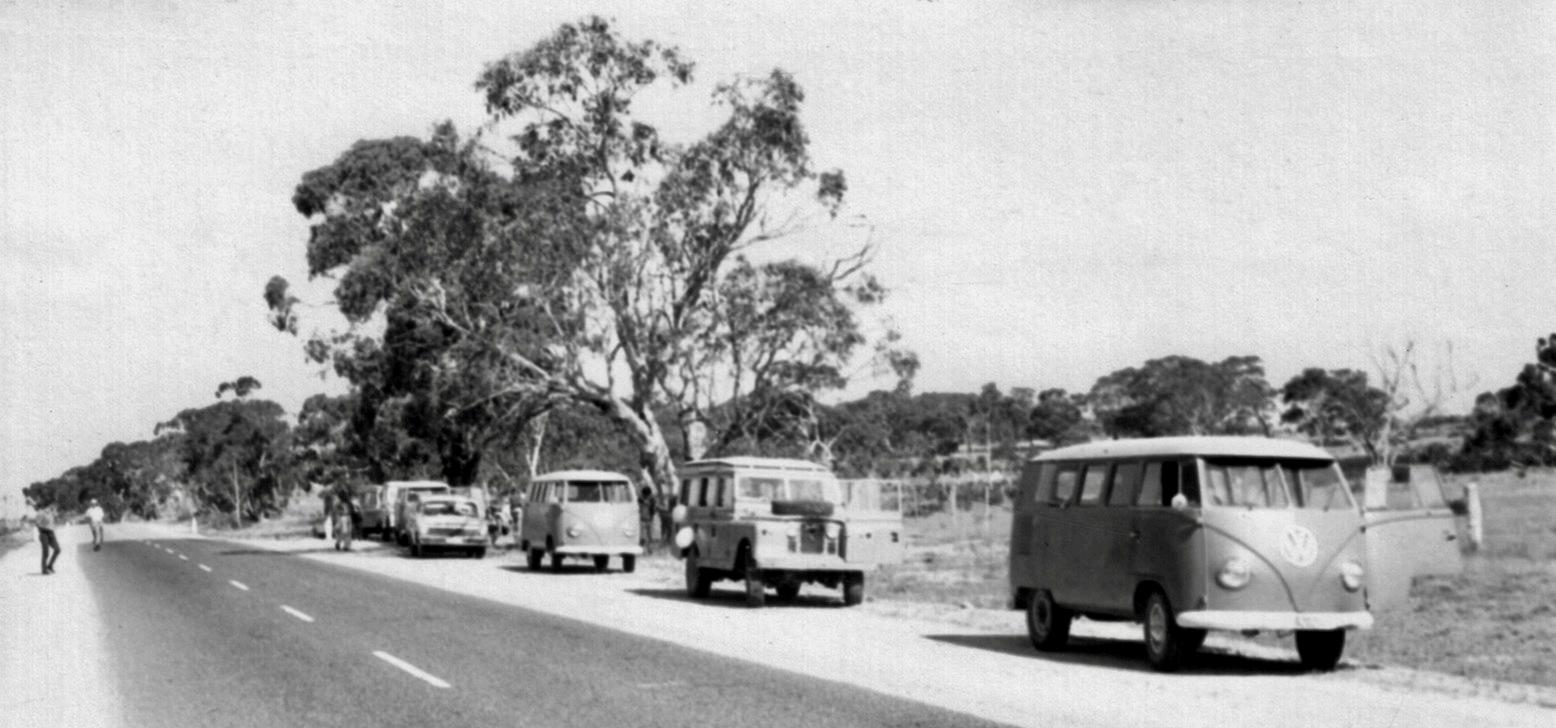
Excursion by road to Pine Creek State Forest near Coffs Harbour in northern NSW in 1966. These photographs show the VW combis and other vehicles in the convoy on the road leaving the ACT (previous page) and near Coffs Harbour (left and below). Paul Ryan is standing in the open doorway of the vehicle in the photograph below, while we wait for the following vehicle to catch up.

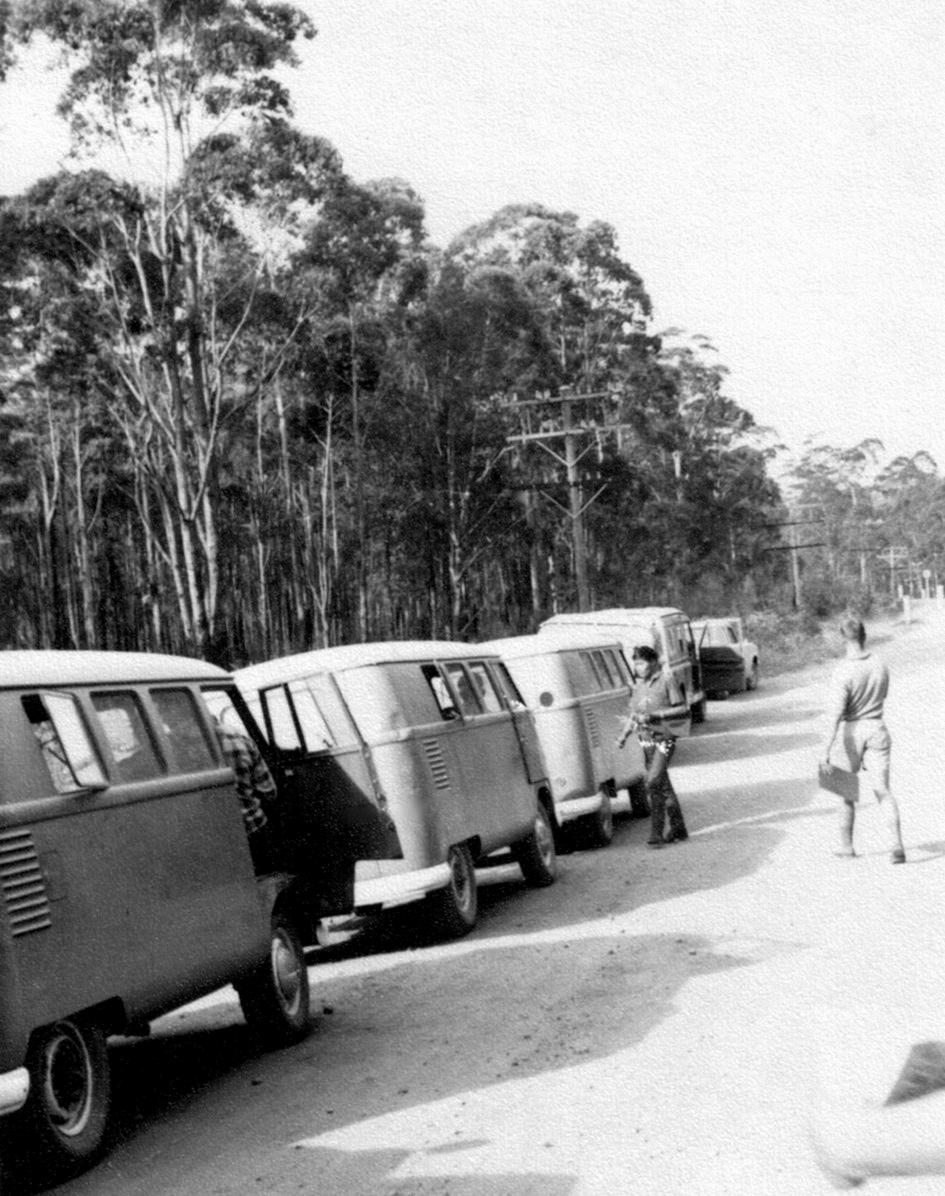
Conscription into the Australian Army had been introduced in November 1964 to boost troop numbers. This was based on bi-annual ballots of birthdays from among men turning 20. In 1966, I was a year too old to be caught up in this. Mark Higgs, and Dave Knaggs, later the only forestry students in my year called up, were able to defer their call up until after their university studies, by which time conscription had ended in December 1972.
It was “All the way with LBJ” when the President of the United States Lyndon Baines Johnson and Lady Bird Johnson landed in Canberra on the evening of 20 October 1966 for a three-day visit to Australia. There were numerous demonstrations in the city against the Vietnam War. Gloria and I, as members of Canberra’s small population of only about 96,000 at the time, got only brief glimpses of the President and his wife as they were rushed around the city at high speed. One tall building in Civic had its windows either lit or blacked out to show “L B J” on opposite sides at night.
Top left: Air Force One carrying the President of the United States lands at Fairbairn Airport. At the time it was possible for Gloria and I to park on the roadside just outside the airport at the southern end of the runway without restriction! Top middle: President Johnson complete with bodyguards in an open-topped car, like the one in which President Kennedy was assassinated, zooms past Gloria and me standing on the side of the road. Apparently only one hardtop Presidential limousine was airlifted into Canberra. When the Presidential pair moved around Canberra on separate engagements, it was always the hardtop car that was used by the President’s wife, reportedly to protect her hair from the wind! Top right: “LBJ” on a building in Civic created by lit and blacked out windows. Bottom left: Lady Bird Johnson (centre) and Zara Holt (left) wife of Australia’s Prime Minister Harold Holt come ashore from a launch at Yarralumla Jetty after a tour on Lake Burley Griffin on 21 October 1966. Below: The First Lady, in the President’s bulletproof Lincoln, soon after disembarking at Yarralumla Jetty, speeds past Gloria and me standing kerbside in Yarralumla.
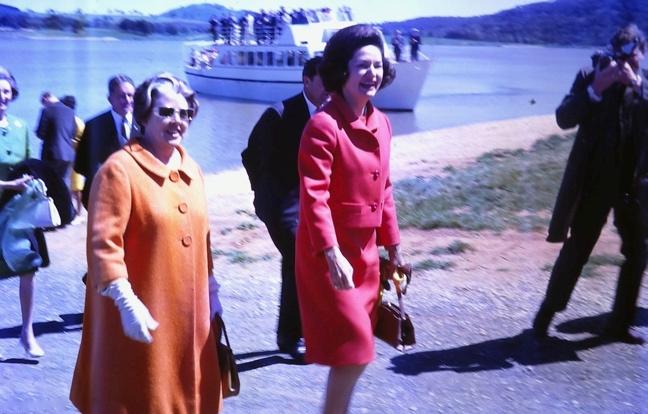
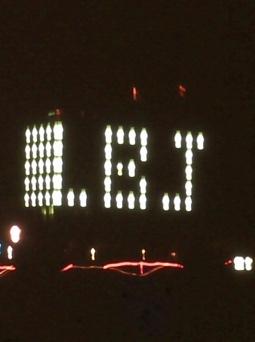
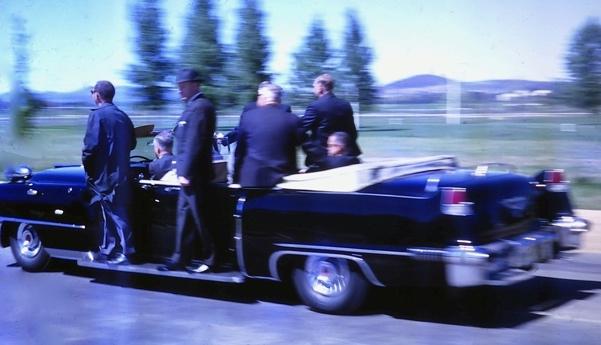
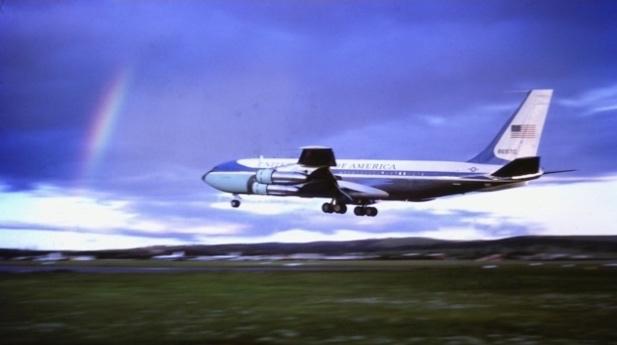

Overall ranking of Fourth Year students, end of 1966, based on both 1965 and 1966 examinations
End-of-year examinations took place through November 1966. Forestry Department records gave the order of merit rank for each fourth year student after the end of year 1966 examinations:
1 Sands*, 2 Davidson*, 3 Boomsma*, 4 Siemon*, 5 Barwick*, 6 Vowles*, 7 Bowyer*, 7 (eq.) Meakins* , 9 Dundon*, 10 Chiswell, 10 (eq.) Shea, 12 Chuong*, 12 (eq.) Hodgson* 12 (eq.) Richley, 15 Allen, 15 (eq.) Greve, 15 (eq.) Hitchcock, 15 (eq.) Johnson, 15 (eq.) King, 15 (eq.) Nowill, 15 (eq.) Traise, 22 Benson, 22 (eq.) Butcher, 22 (eq.) Farrow, 25 Bird, 25 (eq.) Hiley, 25 (eq.) Nicholson, 25 (eq.) Ryan, 29 Holesgrove, 29 (eq.) Pfitzner, 29 (eq.) Reynolds, 29 (eq.) Searley, 33 Cross, 33 (eq.) Grimmett, 33 (eq.) Harun bin Ismail, 33 (eq.) Horne, 33 (eq.) Lewis, 38 Ibrahim, 38 (eq.) James, 38 (eq.) Orme, 41 Emery, 41 (eq.) Knaggs, 43 Cheah, 43 (eq.) Noordin, 43 (eq.) Udarbe, 46 Dukuno, 47 Medhurst, 48 Temu, 49 Telford. (* Honours students)
The official notification for my academic progress at the end of the fourth year 1966 and dated 12 December 1966 did not reveal a grade for Forestry C H and Forestry D H, instead showing only that I had withdrawn (“W”) from Forestry C and D on 1 April (“1/4”). This was because on 12 December 1966 I had not yet finished the honours courses for Forestry

C H and D H.
Additional special course work, language study and examination, research and presentation and examination of a mini-thesis still had to be undertaken under the Honours programme. Completion and examination of this work caused a change in the ranking of students given earlier.
Early in 1966, the Faculty of General Studies approved a special arrangement whereby selected forestry students could carry out an Honours program concurrently with the third and fourth years of the undergraduate course, including the intervening long vacation, on the grounds the then undergraduate course was already four years in length (five years for those students who had completed an intervening
field year).14 It was further agreed that a one-off arrangement would be made for the students already in their fourth year in 1966 (that included me) in that they would be withdrawn from Unit No 634340 Forestry C and Unit No 634440 Forestry D pass courses on 1 April 1966 and instead be enrolled in Unit No 634341 Forestry C H and Unit No 634441 Forestry D H (the “H” in each standing for “Honours”). This one-off arrangement allowed eleven selected fourth year students Barwick, Boomsma, Bowyer, Chuong, me, Dundon, Hodgson, Meakins, Sands, Siemon and Vowles to carry on an Honours curriculum in parallel with the remainder of the final year undergraduate program. However, we would also be required to stay on after the 1966 end-of-year exams for almost another five months through the 1966-1967 long vacation and into March 1967 to complete the requirements for Honours, including sitting a language exam and writing up, submitting and presenting a mini-thesis on a research topic.
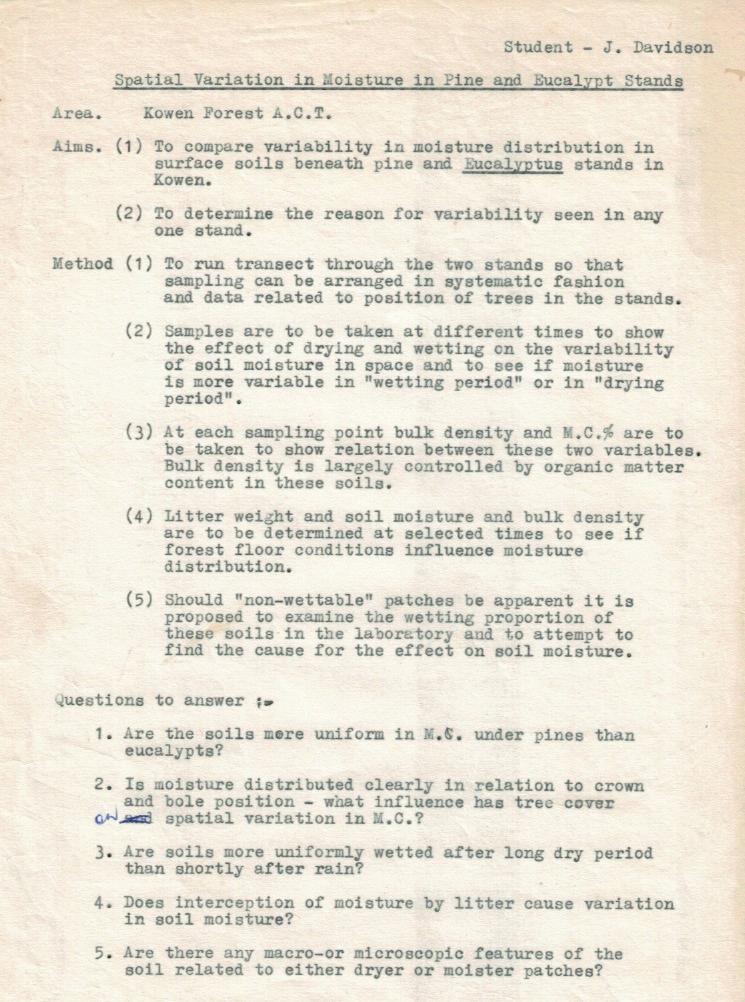
My research topic was Spatial Variation in Soil Moisture Under Eucalypt and Pine Stands. The University set the topic for study (left). My supervisor was Mr C D Hamilton. Work started in April and continued through to December 1966. The aim was to build on work already published recently by Mr Hamilton.15
In between normal course work investigations were carried out at a single site beneath adjacent pine and eucalypt stands in Compartment 35 in the northern extremity of Kowen Forest about 15 km east of Canberra in the ACT.
14 From 1970, an additional option of a one-year full time Masters course became available for forestry students.
15 Hamilton C D 1964 The effect of Monterey Pine (Pinus radiata D. Don) on the properties of natural eucalypt forest and woodland soils. Thesis submitted for MSc (For.), University of Western Australia; and, Hamilton C D 1965 Changes in the soil under Pinus radiata, Australian Forestry 29(4): 275-289.

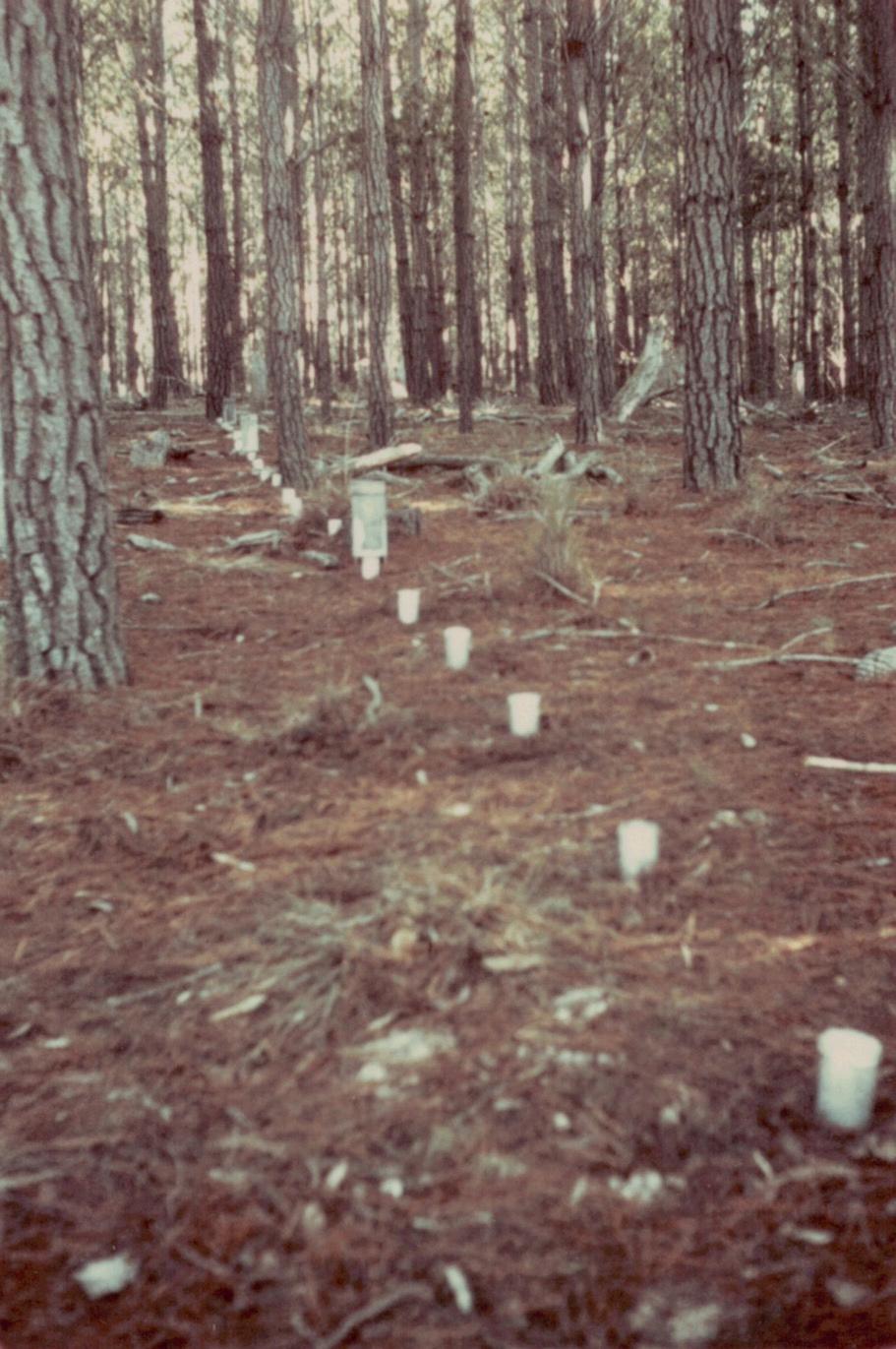
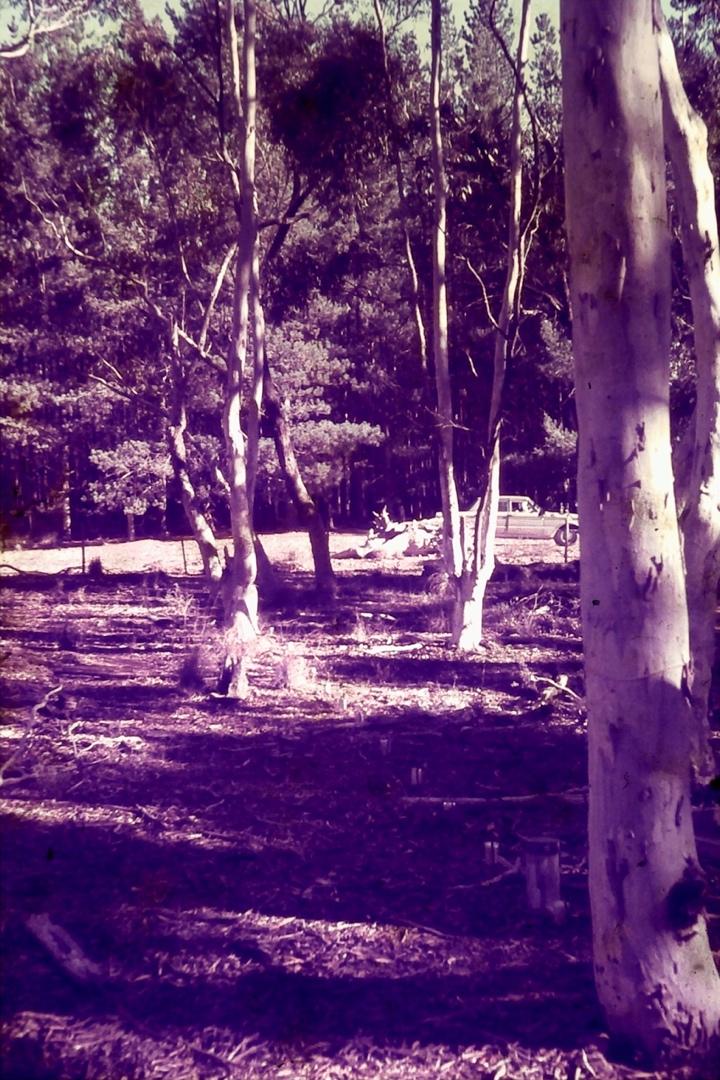

Soils under the pine stand were more uniform in moisture distribution than those under the eucalypts. However, the pine surface soil contained less moisture than the eucalypt soil after a long dry period. It was apparent that masses of soil in the “A” horizons beneath the eucalypts remained dry over the entire period of investigations despite periods of rain. These “dry bodies” were absent from the pine soil. These observations indicated a phenomenon of non-wettability in the eucalypt soil but this property was absent from the pine soil. Wetting resistance was found to be of two types:

i) One developed as a result of wetting resistance in the surface layer when the layer was stained with organic matter; this type was nullified if the soil was forcibly wetted, but returned on thorough drying
ii) A second type that was many times more effective than the first in preventing initial wetting but that preventative effect did not return after the soil was forcibly wetted and thoroughly dried. (The nine-month period of observations in this study was too short to determine if wetting resistance would eventually return over a long period of time.)
A non-wettable aggregate containing fungus from under the eucalypt stand floats on water for hours, while an aggregate taken from an adjacent wettable part of the same soil immediately takes up water and sinks.
The second type of non-wettability (wetting resistance) was connected with the presence of a profuse fungal growth in the eucalypt soil.
A dry sclerophyll forest eucalypt vegetation, thick litter layers, a coarsetextured surface soil relatively high in organic matter, exchangeable calcium and magnesium, and a particular fungal association apparently all combine to produce non-wettable patches in the eucalypt soil. This forms a variable surface soil moisture distribution pattern, which is visible under the litter after rain.
The combination of a pine stand (planted, age 23 years), thinner litter layers, a coarse textured surface soil low in organic matter, exchangeable calcium and magnesium and having an apparently different fungal association, appears not to support the formation of dry bodies in the pine soil. As a result the soil moisture distribution under the pines is more uniform than that under the adjacent eucalypts.
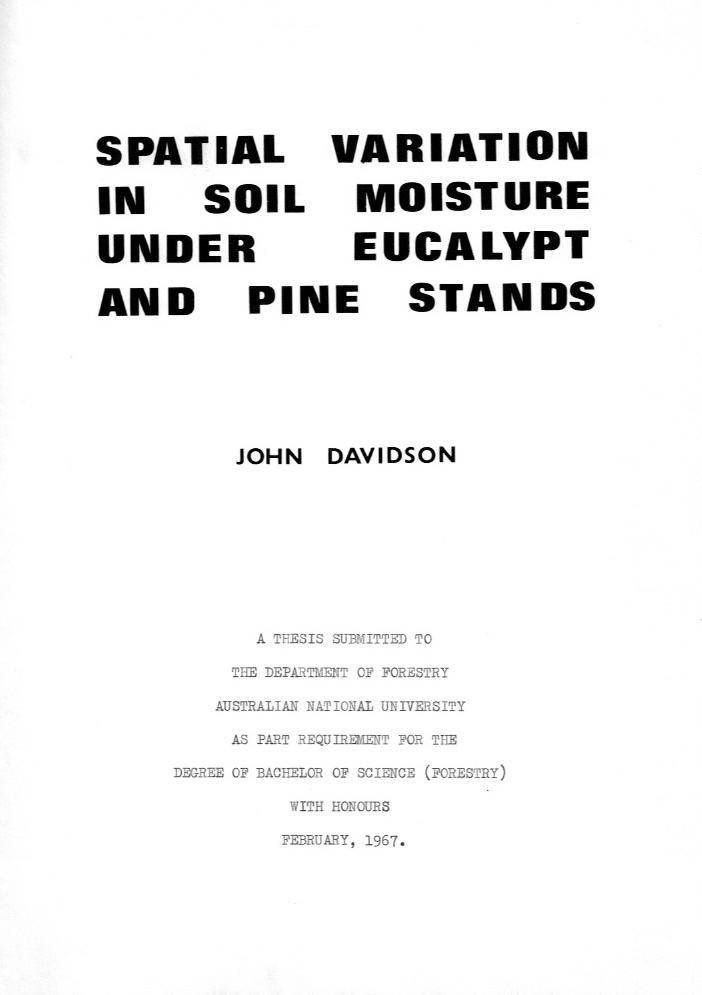
Writing up this research was completed during January and the thesis submitted in February 1967.
A required seminar presentation of the research was made to Department of Forestry staff and others illustrated with 35 mm slides of photographs and diagrams copied from the thesis.
A Science French language exam was sat.

On 8 March 1967, the Registrar, School of General Studies wrote to me (right) to advise that I had achieved Distinctions in both Forestry C (H) and Forestry D (H). (There was only one grade available for Science French: either “Pass” or “Fail”.)
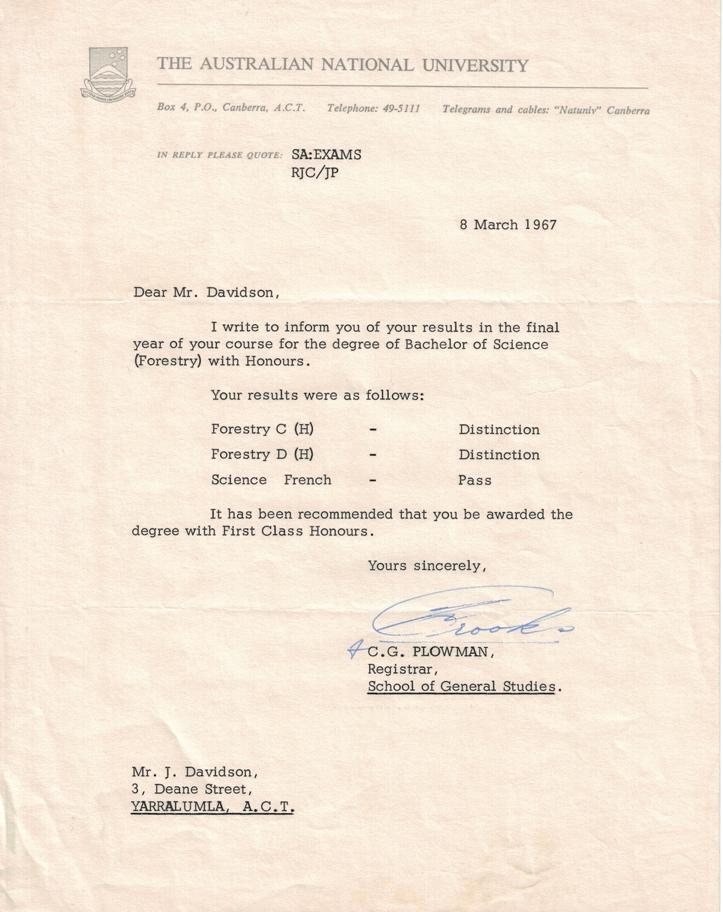
Following the end of the Honours course, there was a new ranking of the final year honours students: 1 Davidson, 2 Sands, 3 Boomsma, 4 Siemon, 5 Barwick, 6 Vowles, 7 Bowyer, 8 Meakins, 9 Dundon, 10 Hodgson and 11 Chuong.
Dr Jacobs had written on 1 March 1967 (below) informing me that he had been advised by Professor Ovington of my selection for the award the Schlich Memorial Medal for 1966 at the end of my forestry undergraduate studies.
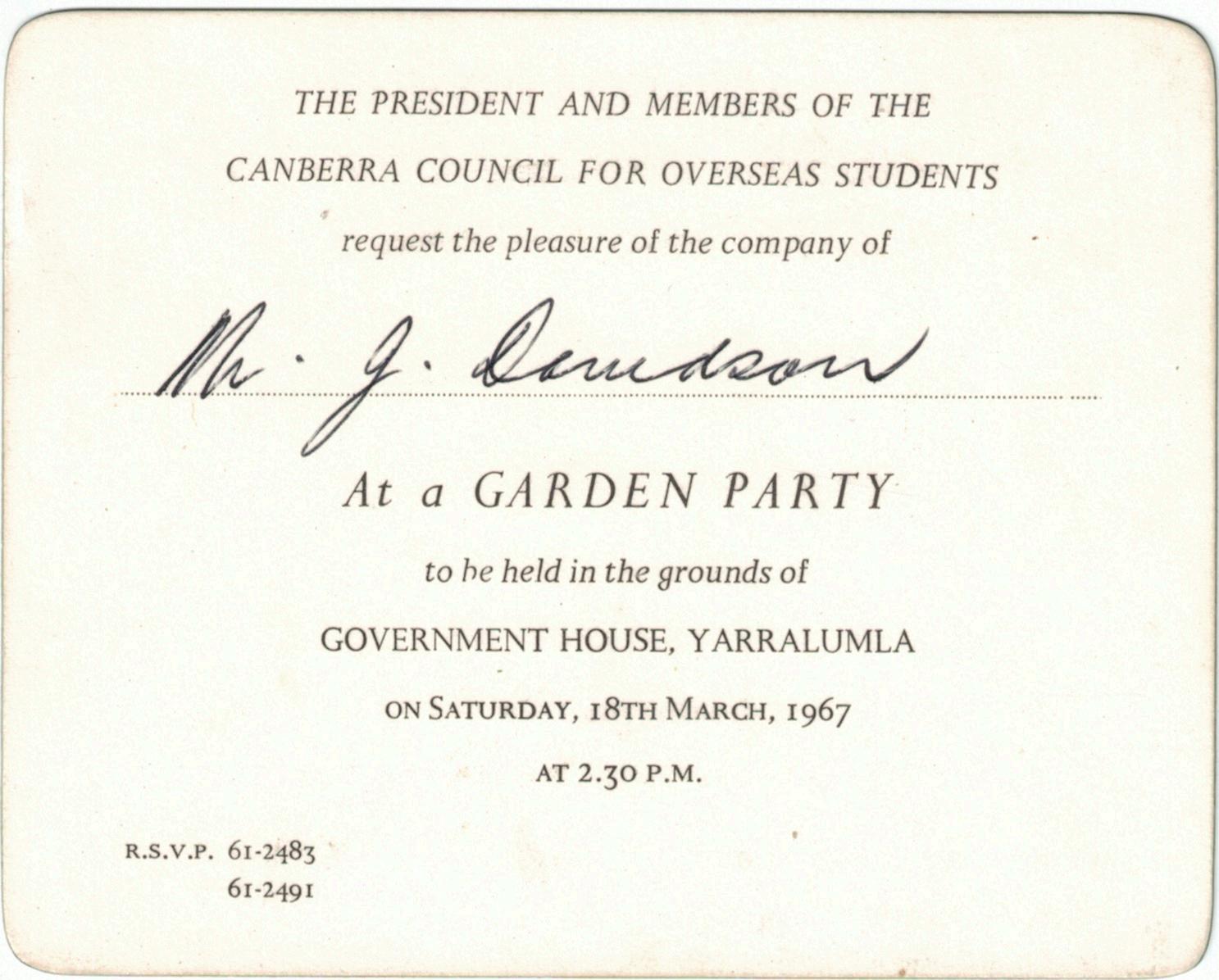
This letter had been dictated to Gloria by Dr Jacobs taken down in shorthand and typed up by her (indicated by the initials MRJ/GJD at the top left hand side), but she had kept the award a secret from me for over a week until I received the letter in the post at 3 Deane Street on 8 March, just two days before my departure for the Territory! I missed out on the Garden Party for overseas students held eight days after I left Canberra!
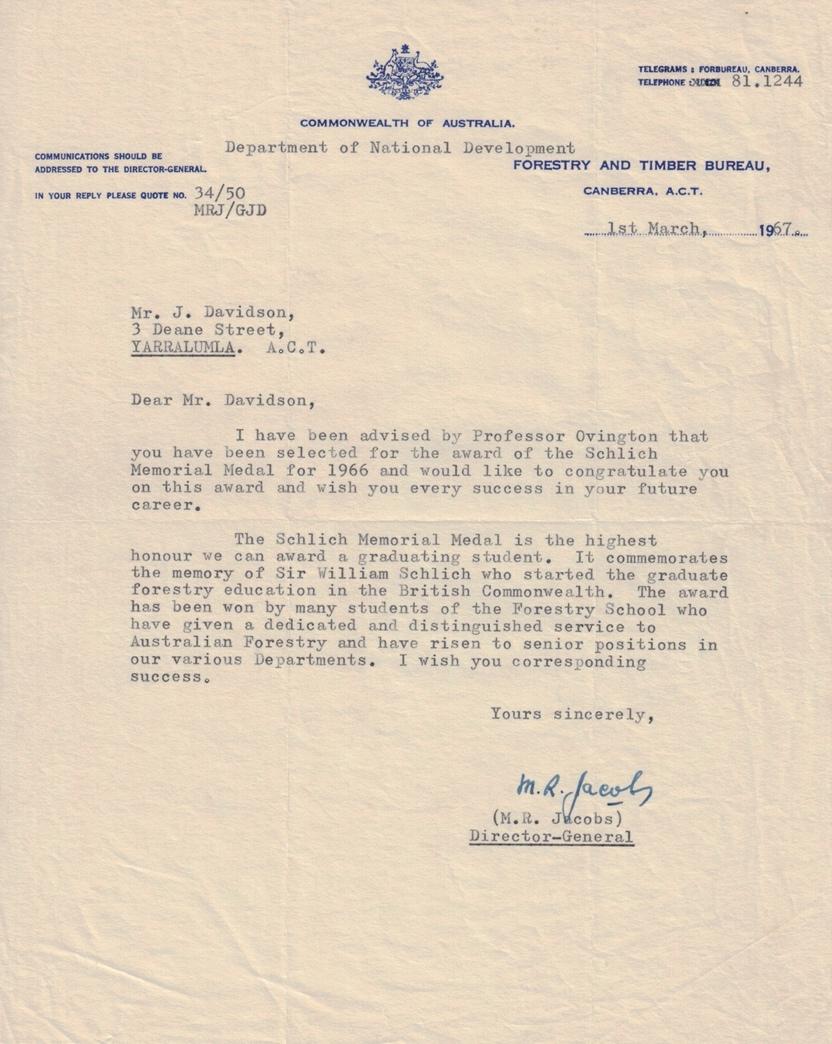



Meanwhile, plans had been released for a proposed new building for the Forestry Department to be built on the ANU campus.
Plan of the relatively sparsely occupied ANU campus in 1966. The asterisk (*) southeast of Daley Road indicates the approximate location of the proposed new building for the Forestry Department in a then large open space. Key: 1 The Chancelry, 2 University Union, 3 Economics-Law Building, 4 Childers Street Buildings (Faculties of Economics, Law and Oriental Studies and Student Administration School of General Studies), 5 Haydon-Allen Building (Faculty of Arts), 6 General Studies Building of the University Library, 7 Maintenance Depot and Boiler House, 8 Geology Building, 9 Chemistry Building, 10 Physics Building, 11 Bruce Hall, 12 Zoology Buildings, 13 New halls of residence, 14 Botany Department Experimental Area, 15 South Oval, 16 Central Store, 17 Old Hospital Buildings (site from where one of the former nurses’ residences was relocated to the Forest School precinct), 18 John Curtin School of Medical Research, 19 Research School of Physical Sciences, 20 Vice-Chancellor’s House, 21 University House, 22 Telephone Exchange, 23 R G Menzies Building of the University Library, 24 H C Coombs Building (Research Schools of Social Sciences and Pacific Studies), 25 Old Administration Buildings, 26 Oriental Studies Building, 27 Lennox House.
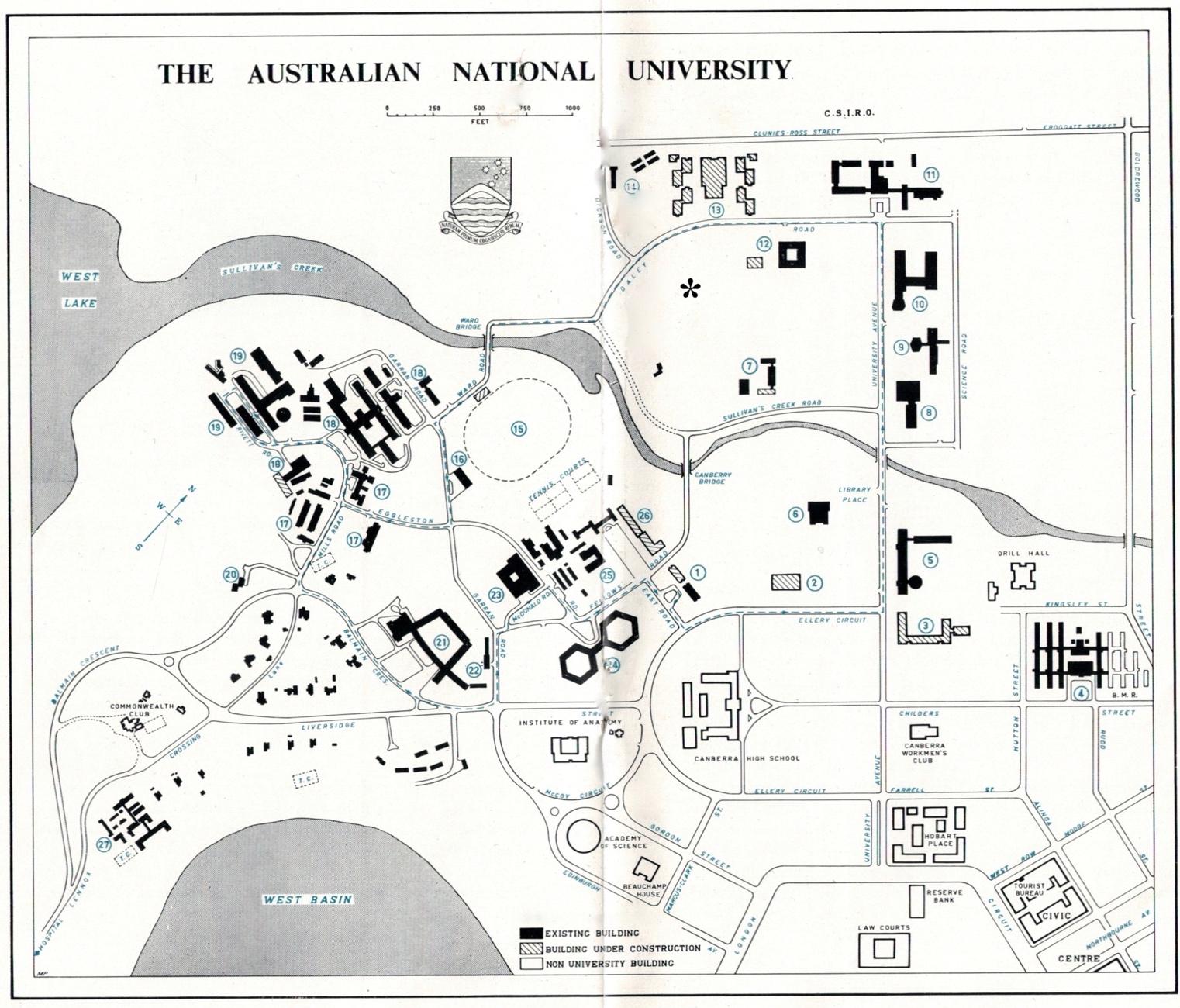
Gloria in Canberra September 1966 through to April 1967

Gloria continued to work as Dr Jacobs Personal Assistant, while I completed my exams and honours work, and she also typed up my honours thesis. Gloria served on the respective Secretariats of the Seventh United Nations Regional Conference on Water Resources Development in September 1966 and the Fifth United Nations Regional Cartographic Conference for Asia and the Far East in March 1967, both hosted by the Department of National Development in Canberra.

Though not able to attend the conferences’ proceedings I did get invited along with Gloria to attend some of the receptions!

After I left for Papua and New Guinea, Gloria stayed behind in Canberra for an additional period to serve on the Australian Secretariat for the FAO/IUFRO sponsored World Symposium on Man Made Forests and Their Industrial Importance, 14-25 April 1967.
Just before this Symposium, Gloria was able to attend the ANU Conferring of Degrees Congregation on Thursday afternoon 13 April 1967, at which the Degree of Bachelor of Science (Forestry) with Honours was conferred on me in absentia. Of note on the scrolls presented at the time the word “Forestry” in brackets was added by hand probably because there had not been time to print new degree certificates with “Bachelor of Science (Forestry)” meant to be all in the title line in large capital letters.

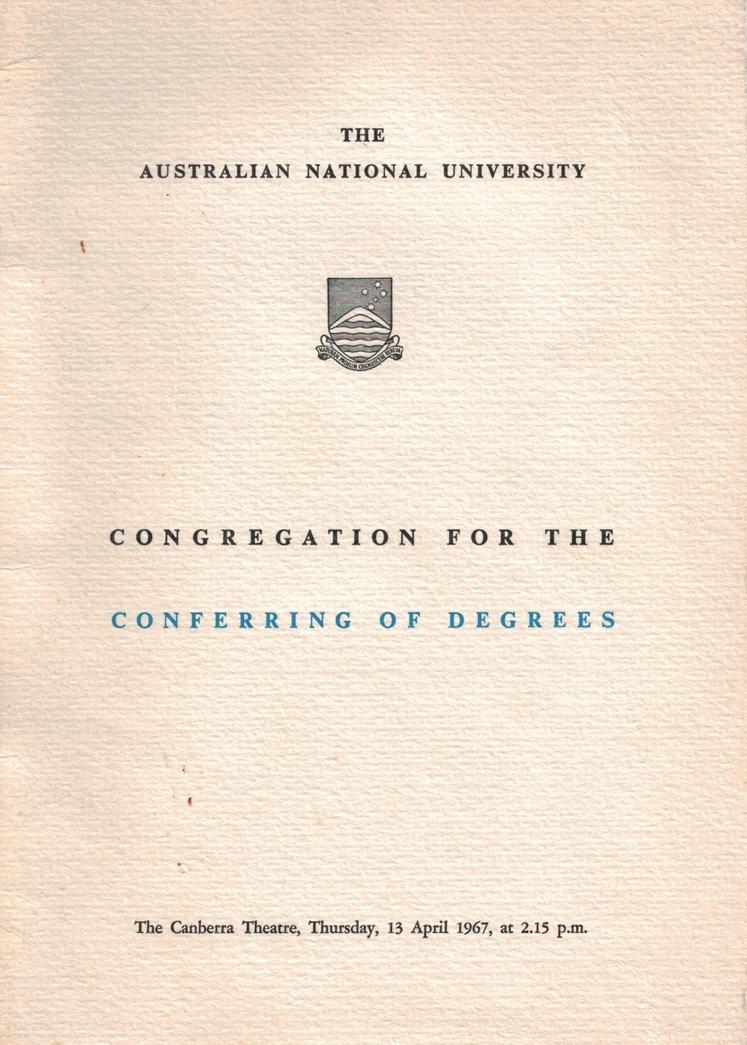

Fourteen final-year forestry students were present at the graduation ceremony: M R Allen, A D Benson, E L Chiswell G J Cross, M H Farrow, P P Hitchcock, R L Holesgrove, R R Horne, G A King, H N Lewis, R H Pfitzner, J G Reynolds, M E Searley and M P Udarbe. One Honours graduate was present: P H Chuong.
Bachelor of Science (Forestry) degrees were conferred in absentia on 18 final year students: T Bird, T
B Butcher, L C Cheah, P R Emery, D McD Greve, J L Grimmett, H bin Ismail, D G Hiley, R N James, G T Johnson, C A Nicholson, S bin H Noordin, J F Nowill, R K Orme, P A Ryan, S R Shea, S I bin S Ali and K W Traise.
Bachelor of Science (Forestry) (Honours) degrees were conferred in absentia on 10 final year students: D S Barwick, D B Boomsma (The Commonwealth Forestry Bureau Book Prize, 1966), P C Bowyer, me (First Class Honours) (The Schlich Medal, 1966), R L Dundon, B S H Hodgson, J S Meakins, R Sands (First Class Honours) (The Timbind Utilization Prize, 1966), G R Siemon, and T A Vowles.
Of the class of 48 final-year forestry students, 2 obtained their degree with first class honours, 9 with honours and 32 with a pass. Five students failed.
On the evening of 14 April, Gloria attended the World Symposium on Man Made Forests Reception in (old) Parliament House. She then had Symposium Secretariat duties from 15 to 25 April 1967.

Opening Ceremony of the United Nations World Symposium on Man Made Forests in Canberra, Dr Max Jacobs in the Chair (second from right), Mr Jack Westoby, Deputy Director Forestry and Forest Products Division, Food and Agriculture Organization (FAO), Rome,
Dr Max Jacobs Director-General Australian Forestry and Timber Bureau, Commonwealth Department of National Development (left) and Mr Jack Westoby, Deputy Director of the Forestry and Forest Products Division, FAO, on the occasion of Australia’s hosting of the United Nations World Symposium on Man Made Forests in Canberra 14-25 April 1967. (As Captain Jacobs of 1 Command, Royal Australian Engineers, Max had been posted to New Guinea during WW II to join the embryonic forest service under Major James Banister (Jim) McAdam (after the War, the first Director of the Department of Forests, Territories of Papua and New Guinea.)
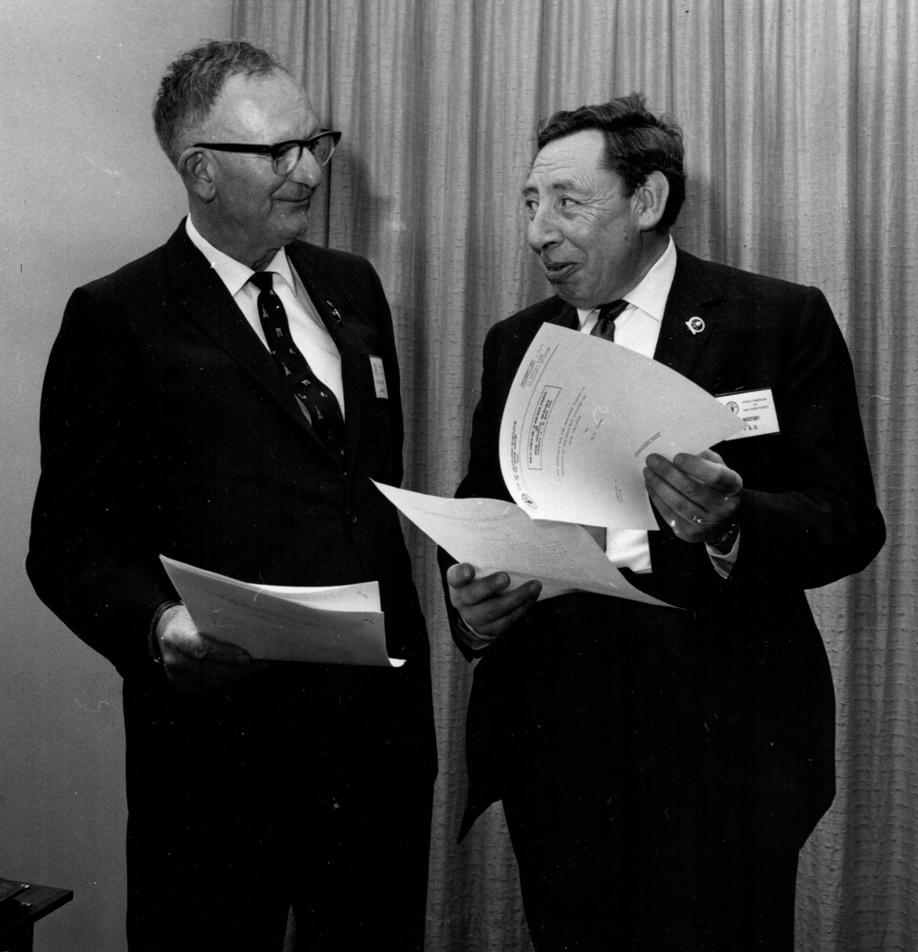


As the time for uplift approached many pages of “service particulars” and “information statements” were received in the post from the Department of Territories, some dated “July 1965” but apparently still current in early 1967, and there were several forms, such as the removal form S. F. C. 9.4.1 to be filled in, and Statutory Declarations made. There was a requirement to prepare a list “in fine detail” of effects to be uplifted, that is down to the individual teaspoon in a set of cutlery and to individual books and phonograph records by name and value. All this had to be done three weeks before the removal date, and everything submitted in triplicate!

One piece of information sent was somewhat off-putting at the time:
“There is at present a shortage of Administration married accommodation in the Territory. …. If married accommodation is not immediately available officers are required to take their turn in the allotment of married accommodation and some time may elapse before housing can be provided. …. Until such time as housing becomes available married officers will be provided with accommodation on the same conditions as single officers.”
At least the promised rental charge was relatively very cheap:
“The present rental charge for Administration married accommodation is £208 ($416) p. a. A married officer occupying such accommodation receives a rent allowance of £160 ($320) p. a.” This meant a net of only A$96 for rent for a year!
Other information concerned what and how much would be relocated at Administration expense:
“The Administration will bear the cost (including packing charges) of the removal of furniture and effects (not exceeding in all two tons weight) from the place of residence in Australia to the Territory. The Administration will also meet the cost of excess baggage charges up to a total of 100 lbs each including the airlines free allowance, for an officer and his wife (but not for children) travelling to the Territory by air.”
“As the following basic items of furniture are made to officers occupying Administration owned residences, similar furniture etc. owned by appointees will not be conveyed to the Territory at Administration expense –
(1) Beds, Mattresses, Mattress Covers.
One to each person or dependant [their spelling of “dependent” retained throughout] being in the residence and able to use it. Cots are not supplied. The issue is not one to each bedroom.
At outstations all bedrooms are usually supplied with beds because of the need to accommodate visitors from time to time.
Beds are not supplied for use by non-dependants in urban areas.
(2) Dressing table is supplied where such fixtures are not built in, for each female dependant, including the wife, over 12 years of age.
(3) Stools are supplied on the same principle.
(4) Wardrobes are supplied as required, and a lowboy or chest of drawers is also available as additional issue if needed, always according to what is or is not built in.
(5) A single officer has 2 webbing and duralium lounge chairs, a married officer 4, plus 1 for each member of the family able to use them.
(6) A sideboard is supplied if required to any residence.
(7) A dining room table and 4 chairs is normal issue, and extra chairs are supplied in accordance with family needs.
(8) All residences are issued with a refrigerator – Kerosene or electric according to the hours of availability of electric power.
(9) Unless electric power is supplied, no lighting is supplied to residences.
(10) Electric, wood, kerosene or bottled gas stoves are supplied according to location.
(11) Kitchen tables are only supplied if there are no built in fixtures such as benches.
(12) Floor coverings and curtains are not provided in Administration residences.
“Dependents of officers moving to the territory, when accommodation is available, might consider the possibility of travelling by sea. This has some advantages in that it enables priority on shipping space to be obtained for furniture and household effects and, at the same time, it ensures that the effects are available immediately on arrival, which may not be the case should dependants travel by air.”
Detailed suggestions were made about clothing, personal and household equipment:
“(i) These suggestions represent the composite opinions of a number of people who were asked for their views, but naturally the subject of personal clothing and other requirements in one on which there are wide individual preferences, and therefore the following is intended merely as a guide.
(ii) In almost all cases, appointees to the Public Service spend at least a few days in Port Moresby following their arrival in the territory, and personal shopping can be done on the first morning if desired.
(iii) Climatic conditions vary within the Territory, and particularly there is a marked difference in temperature ranges between Highland and Coastal areas. The area to which you are being posted should therefore be taken into consideration when you are bringing clothing.
(iv) All fabrics should be washable, - e.g. drip dry shirts, terylene shorts and trousers. Cotton underwear is usually preferred to nylon as the latter can cause discomfort in a humid climate.
(v) Generally, an umbrella is sufficient protection against rain, particularly so in Port Moresby where the “dry” season lasts some eight months. Plastic raincoats are used (particularly by officers employed on field duties), but for general use they are considered unsuitable due to the temperature and humidity factors.
(vi) Main Territory centres (Lae, Rabaul, Madang, Port Moresby) have shopping centres where any of the items listed in (x) and (xi) are available, Although sometimes slightly more expensive than Capital cities in Australia. The range of items is more restricted in the smaller towns.
(vii) British made dress materials are cheaper than in Metropolitan centres in Australia, and are in good supply, but readymade cotton dresses are usually dearer. Shoes may not be obtainable in the sizes and styles desired and officers should bring a reasonable supply with them.
(viii) Shorts are worn by many male officers for all but formal occasions. A lightweight suit is not essential but may be needed for formal occasions. It is possible to purchase lightweight suits in the main Territory centres, or to order a suit from Hong Kong, and this would be cheaper than a similar suit in Australia. Limited tailoring facilities are available in Port Moresby, Lae, Rabaul and Madang.
(ix) For female officers, long evening gowns are very rarely worn and for formal occasions a short gown would be suitable. Usual day wear is light cotton frock (or skirt and blouse). The wearing of shorts other than for sport, such as tennis, etc. is not encouraged.
Article
General Requirements
Shirts, short sleeve, preferably 4 white
Non-iron with pockets
Shirts, long sleeve, preferably non-iron 1 white
Trousers shorts
(a) if trousers preferred
(b) if shorts preferred
3 pairs trousers
3 pairs shorts, 1 pair trousers
Underwear, sets 5 cotton
Socks, pairs
5 short
1 short and 4 long
Field Officers
1 white and 3 khaki or grey
1 white and 1 khaki or grey
3 pairs trousers (at least 2 khaki)
3 pairs shorts and 2 trousers (2 pairs shorts should be khaki or grey and pair trousers should be khaki).
5 cotton
5 short (including 3 in heavy wool for field use).
2 short and 4 long (including 2 in heavy wool for field use).
(Except for field work, socks should be cotton or nylon for coastal wear and of light wool for highlands wear. Long socks should be in colours to suit the shorts worn).
Boots, pairs -
Shoes, pairs 3
Summer pyjamas
Pullover
2
2 lightweight, with thick soles, Preferably waterproof.
1
1 light wool
2
1 thick wool
Neckties, slippers, casual shoes or sandals, handkerchiefs, umbrella, hat, toilet gear, etc. lightweight dressing gown.
8 dresses (or skirts and blouses) of cotton or durable washing material – 6 for day wear, 2 for evenings (one of these semi-formal).
5 sets underwear
3 pyjamas or nightgowns
1 housecoat, short summer-weight
1 cardigan
5 pairs shoes
1 pair sandals
scarf, umbrella, handkerchiefs, toiletries, hat, etc.
Sports clothing is desirable but may be obtained in Territory main centres.
Personal items such as curtains, bedspread, irons, jug, crockery, cutlery, etc. if required have to be provided by all appointees, but it is desirable to purchase these as necessary after arrival in the Territory. Electrical appliances for use in the Territory should be rated at 240 volts, A. C. as is common in Australia.”
“Household equipment
Normally, a single officer would require the following bedding:
1 pillow
2 pillowslips
4 sheets
1 lightweight rug or blanket
2 towels
1 mosquito net if accommodation does not have screenwire. All items may be brought in the main towns of the Territory, but you could take with you:-
1 pillowslip
2 sheets
1 lightweight rug or blanket
1 towel.”
Some notes were provided on sporting facilities and medical services:
“Sporting Facilities
Facilities are available at all main centres and some outstations for swimming, tennis, baseball, basketball, fishing, softball, cricket, football (all codes), golf, etc. Hockey, bowls, squash, skin-diving, water-skiing, yachting, speed boat racing, go-kart racing and rifle and pistol clubs at Port Moresby.”
“Medical Services
(i) Medical and dental facilities and full scale hospital services are available at main centres. Treatment at Administration hospitals is not free of charge. The major hospital and sickness benefits funds in Australia have agencies in the Territory.
(ii) Dental facilities are not always readily available at outstations and appointees should ensure that they are dentally fit before proceeding to the Territory.
(iii) Anti-malarial tablets may be obtained free of charge and issues are made as and when required. Malaria is not accepted as a compensatable disease.”
A very efficient team of packers from Stores and Transport Branch, Department of Supply came to our flat and within half a day had everything packed and on board a van to be conveyed to Fyshwick to be placed in a specially constructed lift van (which wasn’t seen until its delivery in Keravat). Our green 1975 Falcon was driven to Clybucca by me and gifted to my parents in appreciation for the many return road trips my father made to the University of New England in the old Ford Customline.
It was time to bid goodbye to Canberra, back then a very small place with a population of less than 100,000. There was no tower on Black Mountain and few buildings on the south side of the Lake other than (old) Parliament House and the just-completed National Library.
On Friday 10 March 1967, I left Clybucca for Kempsey and then by air via Sydney and Brisbane for Papua and New Guinea to take up my post as Forest Officer Class I at Keravat.
Lake Burley Griffin on a weekend in March 1967. Top: Looking towards Canberra Hospital on the north side of the Lake (just left of centre), Commonwealth Avenue Bridge in the centre and the new National Library building on the south side (right of centre). (The Canberra Hospital was demolished in July 1997 to make way for the building of the National Museum.) Bottom: Black Mountain with its two original radio and television transmission towers and with very little development visible around the foreshore of the Lake. This was long before the Telstra Tower was built on top of the Mountain and before the narrow road between the base of the Mountain and the Lake was widened to form the multi-lane Parkes Way.


Canberra, March 1967, looking westwards over lake Burley Griffin. Kings Avenue Bridge over the Lake is on the left, Commonwealth Avenue Bridge is right of centre. (Old) Parliament House is the white building in the trees on the far side of the Lake and left of centre. Just right of centre on the other side of the Lake the recentlycompleted but still unpainted National Library is prominent. The Canberra Hospital sits on the Acton Peninsula just behind the Commonwealth Avenue Bridge. In the foreground are the Russell offices of the Department of Defence, with the spire of the 84-metre-tall Australian – American Memorial dominating.
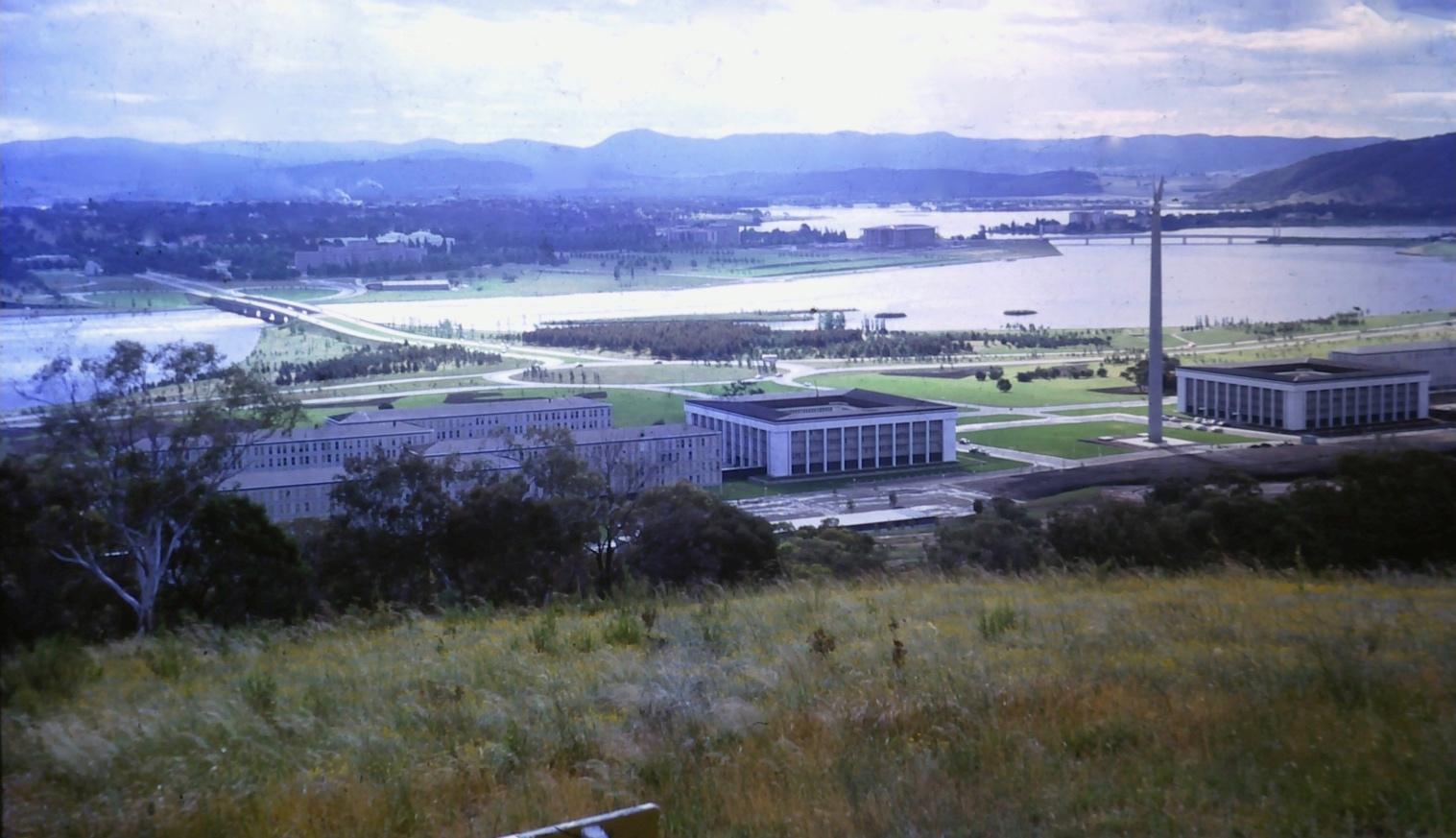
I arrived back in Papua and New Guinea on the morning of Saturday 11 March 1967 to start my career as a Forest Officer Class 1 with the Department of Forests on an annual salary of $2,810 inclusive of $860 overseas allowance This time I was booked into the Hotel Papua in downtown Port Moresby, which was air-conditioned! I met up with Alan Cameron in the evening for a meal and discussion on my role in proposed research at Keravat16, New Britain. I would be the only Forest Officer tasked with silvicultural research full-time while posted outside of Port Moresby and Bulolo. At Keravat I would be primarily involved with a new intensive programme on Eucalyptus deglupta (Kamarere), but would assist also with ongoing work on Tectona grandis (Teak) under Alan’s direction.
16
Now more likely to be spelt by government as “Kerevat”. Examples: “Kerevat Correctional Institution”, “Kerevat National High School”.
Later in the evening, Alan and I went to a local football match under lights. There, I had a chance meeting with Ms Leslie Campbell, a fellow pupil from my final year at Kempsey High School in 1960, who was then working in the Commonwealth Bank in Port Moresby!
I headed off by air via Lae to Rabaul, then by road to Keravat on 13 March 1967.

Rabaul town on the left, Simpson Harbour in the foreground, Lakunai Airport at centre, Matupit Crater and Matupit Harbour in the background, on approach to land in 1967
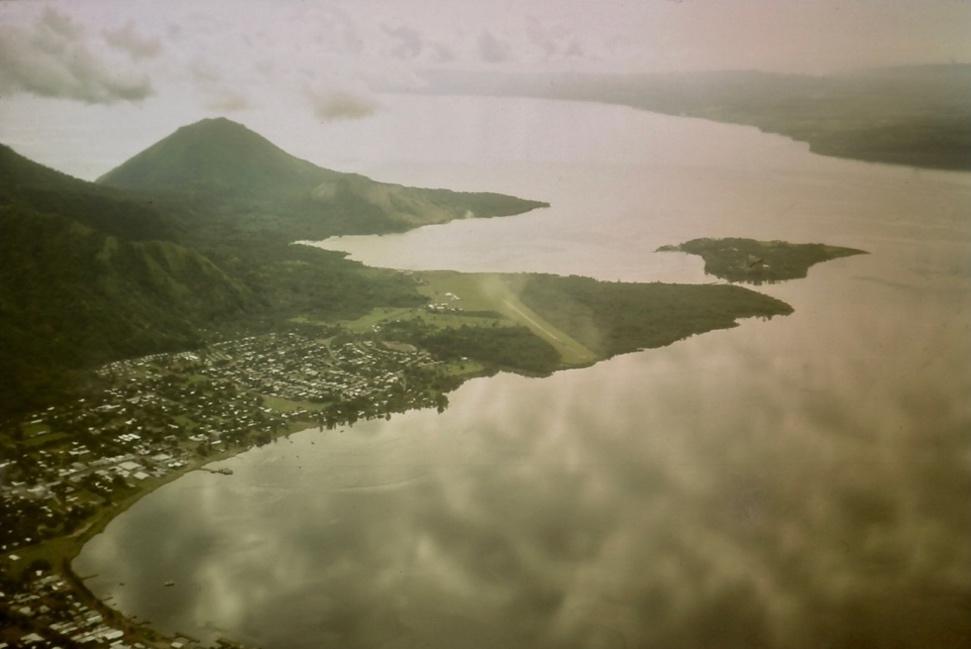
The Regional Forest Officer in Rabaul in 1967 was Elliott Tuckwell. The Officer-in Charge (OIC) of Keravat Forest Station was Allan Fraser. Chris Borough was a Forest Officer there at the time. In 1967 there were about 630 ha of Teak and 311 ha of Kamarere plantations at Keravat. Since Gloria had not accompanied me immediately, I was initially accommodated in the house that was at the time reserved for single officers, near to and on the Rabaul side of the Keravat Forestry Office. Robert Wills (Technical Officer) and Ian Grant (Forest Officer) were the other residents.

Keravat in 1967 – 1968. 1. Derelict sawmill, one of 20 or so built on the Gazelle Peninsula and used by the Japanese during WW II. After rehabilitation using mainly salvaged Japanese sawmill equipment, it was operated by the Government for a few years (1946 – 1949) with “Jim” Cavanaugh in charge, producing timber for the rebuilding of Rabaul, and intermittently to the early 1960s with Arthur Mobbs as manager for training national operators and preparation of wood of local tree species to send to CSIRO, Melbourne 2. Small shed used by me for experimental grafting and mist propagation of Eucalyptus deglupta, 3. Area of nursery with beds with a concrete base set aside for mass propagation of E. deglupta cuttings, 4. Routine section of nursery with wire mesh on frames to hold seedlings in plastic tubes (this was relatively small as Teak (Tectona grandis) was raised elsewhere in bush nurseries near the current planting areas), 5. Keravat Forest Office and parking area (behind the trees), 6. The Davidsons’ house, 7. 1948 E. deglupta plantation, 8. The Williams’ house, 9. Keravat Police Station, houses and barracks, 10. Keravat Trade Store, 11. Road to Rabaul, 12. Road off to the left to cross the Keravat River, then straight ahead to Vudal Agricultural College or turn left to Keravat Correctional Institution (Jail, Kalabus), 13. Helicopter landing area in front of the Davidsons’ house, 14. Remnants of the old sawdust waste pile from the mill and also a storage area for soil for the nursery.

Keravat forestry precinct in 1967 – 1968, from a different angle 1. Derelict sawmill, last used in the early 1960s, with the associated long timber-sorting and stacking shed with a rusted roof stretching across the left foreground, 2. Nursery store buildings, 3. Nursery equipment and seed store, 4. Location of experimental grafting of E. deglupta, 5. Location of cuttings experiments on E. deglupta, 6. Nursery beds with concrete bases where mass propagation of E deglupta cuttings was carried out under mist sprays, 7. Keravat Forestry Office, 8. Office car park, 9. Single Officers’ house, 10. “Williams’ house”, 11. Helicopter landing area, 12. “Davidsons’ house”, 13. 1948 E. deglupta (Kamarere) plantation.
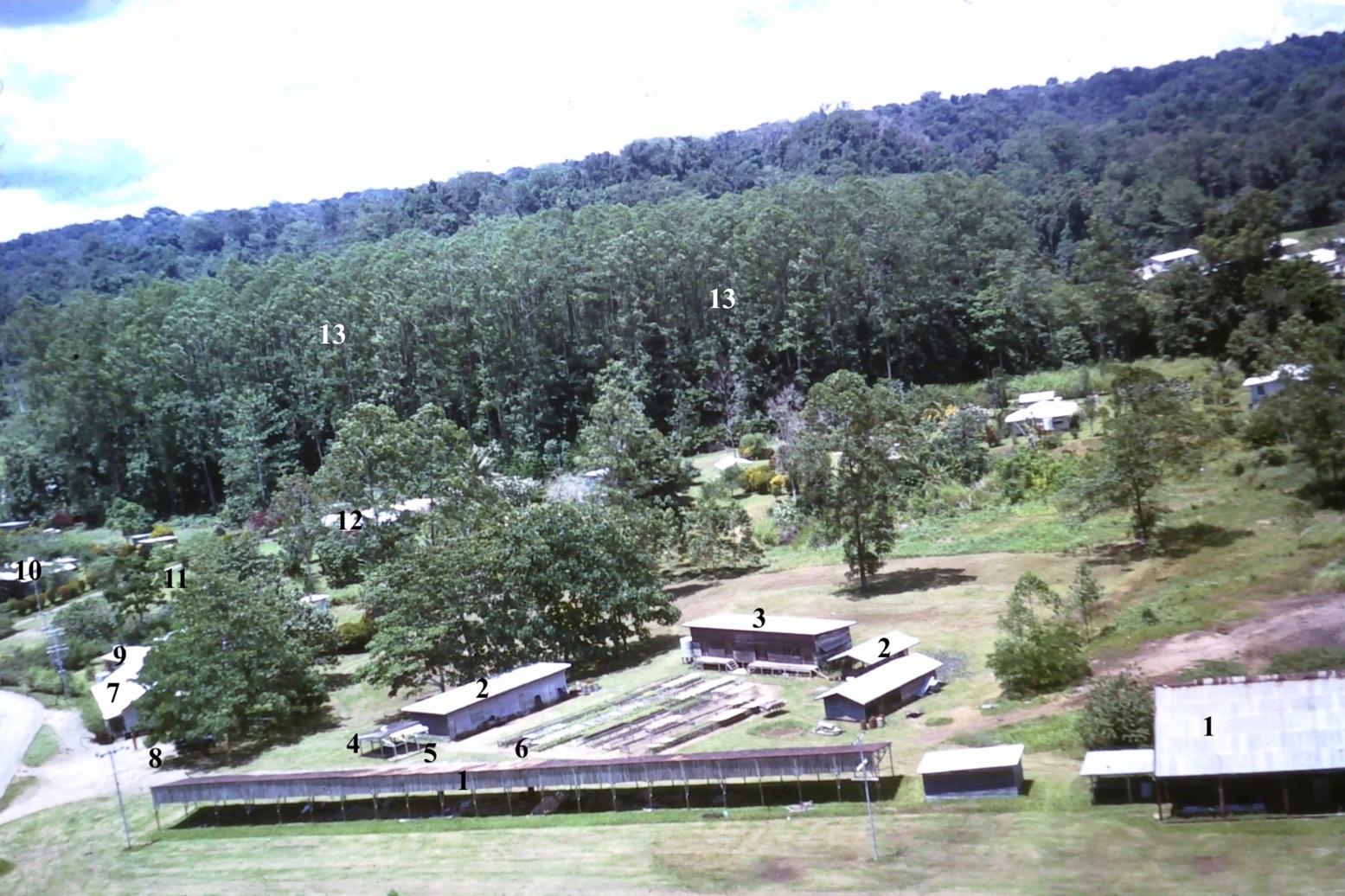
Keravat 1967 - 1968. The 1948 Kamarare (E. deglupta) plantation is shown almost in its entirety at age about 19 years, just behind the “Davidsons’ house”. Initially about 10 acres (4 ha), in 1967 it covered about ⅔ of that, having been encroached around the margins over time by expansion of the Keravat High School (behind and to the right) and Police Station (just off the photograph to the left).
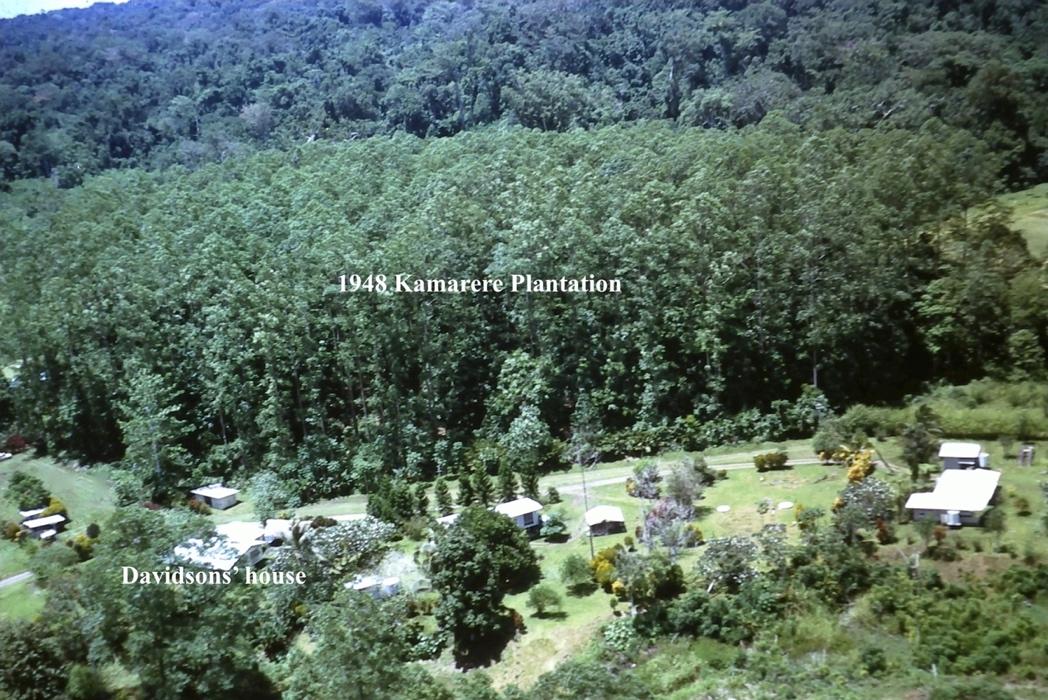
Keravat in 1967 – 1968. 1.
thinned to 150
and
and
rest of the country for the period 1962 -1968, that is, until seed became available from grafted seed orchards at Keravat and Brown River),
Keravat High School in 1967 - 1968. (Later renamed Kerevat National High School, then, later still, after renovation and expansion in 2016, renamed again as the Kerevat School of Excellence.)
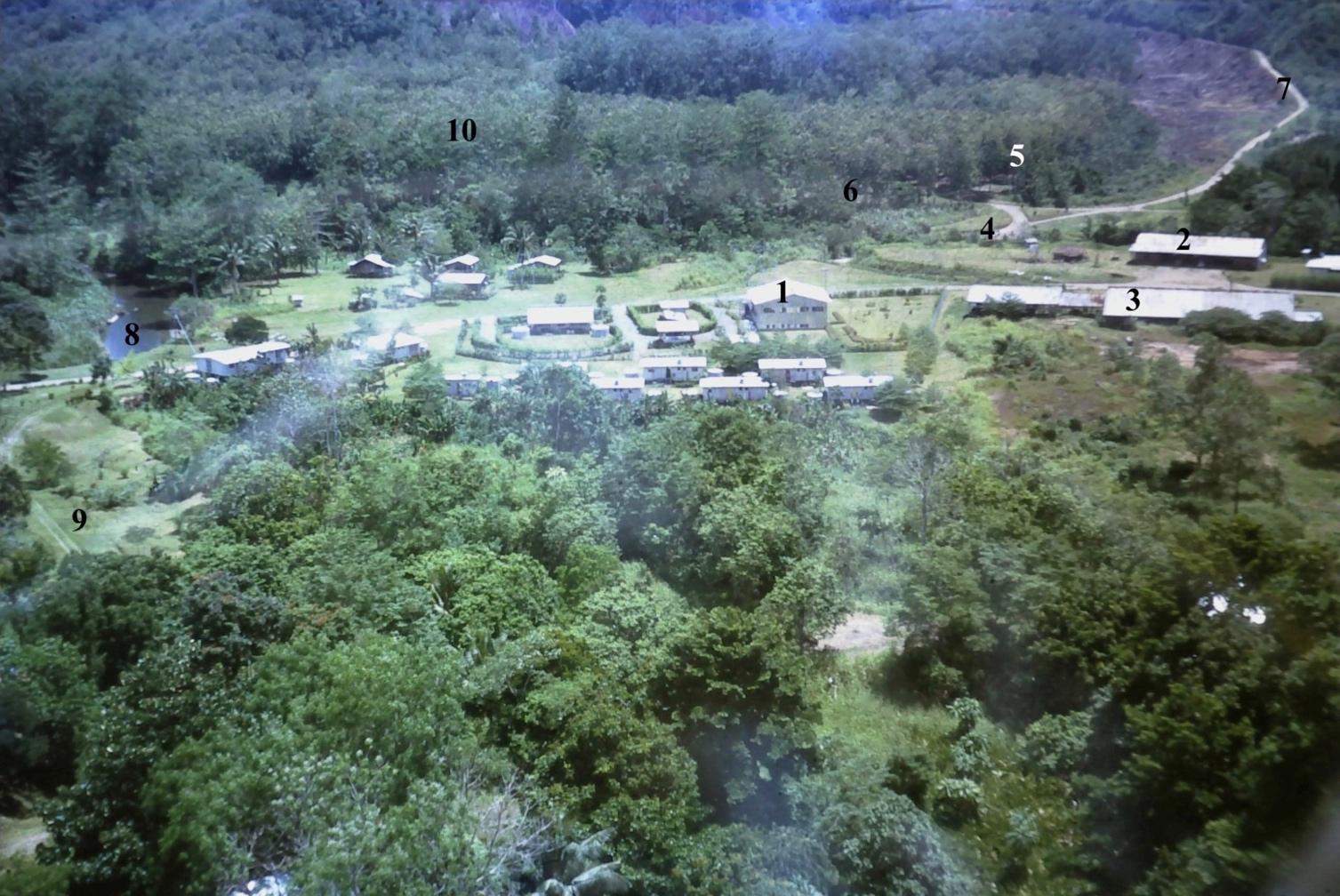

After arriving in Keravat, and initially accommodated in the single officers’ quarters near the office, I was immediately involved in forest resources survey work involving extensive use of a helicopter.17
A Bell 47G-3B helicopter is seen here coming in to land. It was on charter to the Department of Forests from Helicopter Utilities Pty Ltd. This was the aircraft of choice on almost all of the forest surveys in the 1960s. It carried the pilot on the left hand side and two passengers on his right on a single bench seat. Cargo was carried on two panniers, one on each side above the floats. Flexible rubberized air-filled floats like these were normally fitted as they provided the most appropriate option for landing on all kinds of terrain.

had their names entered in a Register in which they had to sign or place a thumbprint on receipt of payment. On the foldable table are bundles of cash for those owners who preferred cash and Commonwealth Bank passbooks and a Bank stamp to record Treasury Investments for those owners who preferred to invest. Not visible on the ground nearby was a metal patrol box containing over 80 kg of 20c coins for those who would not accept paper money! On the table also is a then state-ofthe-art manually operated calculating machine. All this was flown in by helicopter in turn to the several different villages involved.
One of my first tasks was a boundary survey for a proposed concession area in April 1967. I flew to Manginuna airstrip18, then crossed Jacquinot Bay by mission boat to a tented camp already established on a sandy beach southwest of Galowe in East New Britain. The helicopter was operating off the beach. I undertook two river-to-river straight-line compass, abney and chain surveys to establish the inland boundary of the proposed concession.
18 Now Jacquinot Bay Airport.
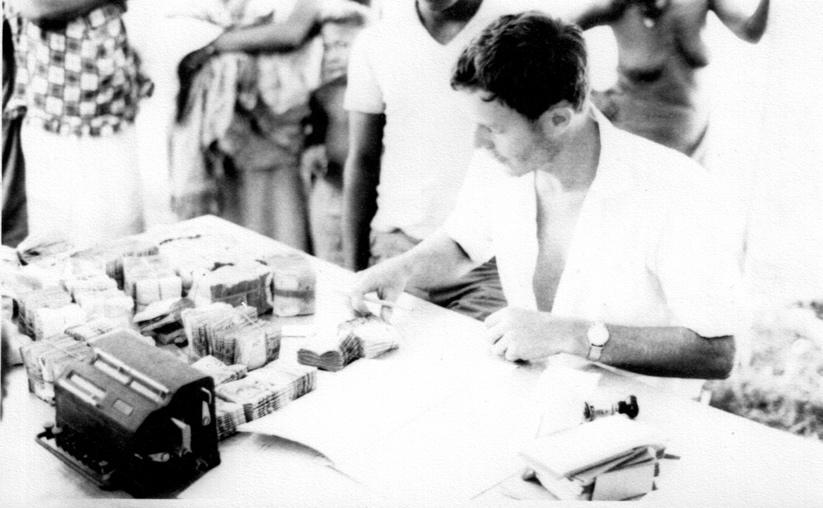
I took the opportunity to collect herbarium specimens of E. deglupta at Pad 10 and at Pad 2 on the Sai River. These were deposited later in the National Herbarium in Lae.
It was at this beachside camp on a pitch-black night that I had my first and only encounter with bioluminescence in tropical rainforest. The forest lit up with a greenish blue light that outlined the whole structure of the vegetation from the litter up to the canopy. It was almost as bright as moonlight but there was no moon. In addition to this static display, numerous fireflies added their pulsating and brighter moving lights. This phenomenon lasted for only three successive nights then disappeared. There was no transition before or after. It was suddenly there on the first night and completely gone again on the fourth night. Apparently, with exactly the right conditions, numerous species of fungi, particularly those involved in decay under high humidity, periodically and unpredictably set off this synchronized glow.
The Timber Rights for 40 years to the 211,000 ha of the Open Bay Timber Concession were purchased from the local landowners at this time. $22,405 was paid in cash and $191,127 deposited in Treasury Investments at an interest rate of 5.75% maturing in 10 years.

One of the urgent tasks for me was the purchase of a private vehicle. We decided on a new 1967 white Volkswagen beetle that was immediately available in Rabaul for $850. One advantage of this car was that it was high enough to straddle the numerous coconuts found lying on New Britain’s roads!
Gloria left her employment with The Forestry and Timber Bureau in Canberra on 26 April 1967, and travelled to the Territory on the same aircraft as the World Symposium on Man Made Forests postSymposium tour delegation to Papua and New Guinea. While they disembarked in Port Moresby, Gloria continued by air through to Rabaul, where she was met and taken to Keravat on Thursday 27 April 1967.
“Our” house at Keravat in May 1967 before a repaint. It was of early post-WW II timber horizontal weatherboard construction. The kitchen and bathroom were separated from the three bedrooms and large open dining-living room by a very effective internal breezeway with a screened door at each end. The floorboards throughout were kwila (Intsia bijuga). The empty lift van made out of radiata pine tongueand-grooved boards that contained our effects shipped from Yarralumla, Canberra sits on the wide verandah. The lift van had been temporarily “lost” in the Rabaul docks area and was eventually found stored out in the open! Thanks to the waterproof roof fitted to it in Canberra, the contents remained dry. Nearby there was a separate servant’s quarters and laundry of similar construction on a concrete slab. The 1948 plantation of E. deglupta was immediately behind the house, a daily source of inspiration for my research on the species. The front lawn running down to the main road was used as a helipad.
I had neglected to warn Gloria about the frequent earthquakes that shake Keravat with varying degrees of severity. Soon after arrival she was in the bath when the water started to slop around and spill over on to the floor despite no movement on her part. An anxious moment not repeated. Keravat sat on a deep layer of pumice. During any earthquake centred towards Rabaul it was possible to see the rolling sine wave of ground disturbance come down the road past the police station and towards the Forest Office.

“Our” house at Keravat in late 1967 after a repaint and the addition of a bush materials shelter for our VW car. In the top photograph the steps and screened door led to an internal breezeway (corridor) that had an identical set of steps and door at the other end. In the bottom photograph can be seen the innovative plastic bag hot water system we purchased from Steamships and installed on the roof. This house still exists today (2019), whereas others built next door and nearby later (“AR 20s”) are not there anymore. Of course, the 1948 E. deglupta plantation is now long gone. Our pet cat in the bottom right hand corner is chasing cane toads. These were very numerous everywhere, especially during and after rain, and made a loud “pop” when run over on the road!

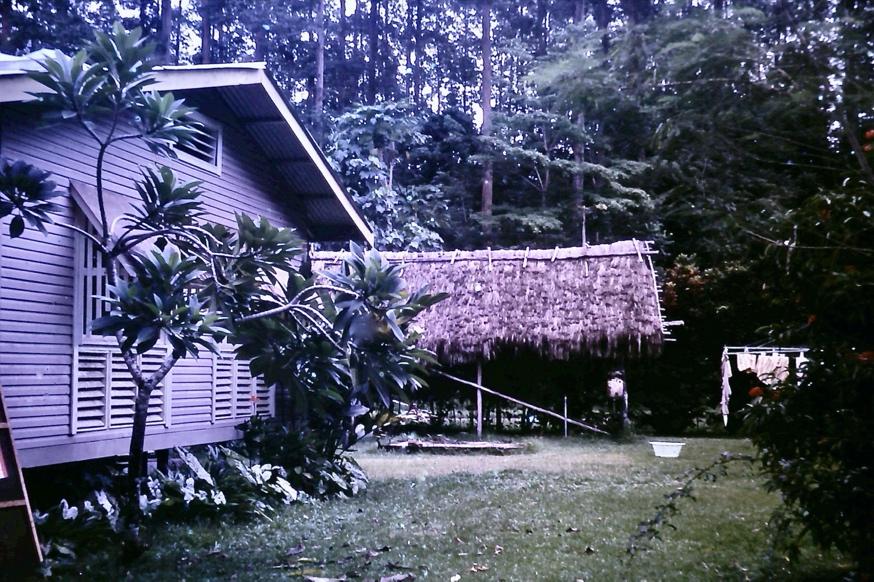

It looked like the effect when one shakes the end of a carpet runner or a thick rope up and down to send a ripple running along it. At home on some mornings one would find the refrigerator had “walked” out from the wall into the middle of the kitchen!
The house was showing its age and needed painting (it was painted three months later), but with three bedrooms it was spacious. The wood-burning stove had rusted almost to the point of disintegration and kitchen benches were rotting away. A request to Forestry to remedy these shortcomings was ignored.
Gloria was able to obtain immediate employment as Personal Assistant to Mr Syd Saville, Principal of the Vudal Agricultural College. There was a rush for Gloria to obtain her first driving licence so that she could commute to the College and drive into Rabaul and back before I left on surveys. She was tested in the Volkswagen by the OIC Keravat Police Station, passed immediately, and had her licence issued.
Vudal Agricultural College in 1967, only two years after its establishment as a male-only college of the Department of Agriculture, Stock and Fisheries. The then Principal was Mr Syd Saville. (In 1992 the College became coeducational when it merged with the Papua New Guinea University of Technology. Later, and after expansion, it became the autonomous University of Vudal, and still later, from 2005, the Papua New Guinea University of Natural Resources and Environment.)
When Gloria started work at Vudal, she mentioned the poor state of the kitchen in the house at Keravat. The next day the College organized the installation of a new gas stove and bottled gas supply and
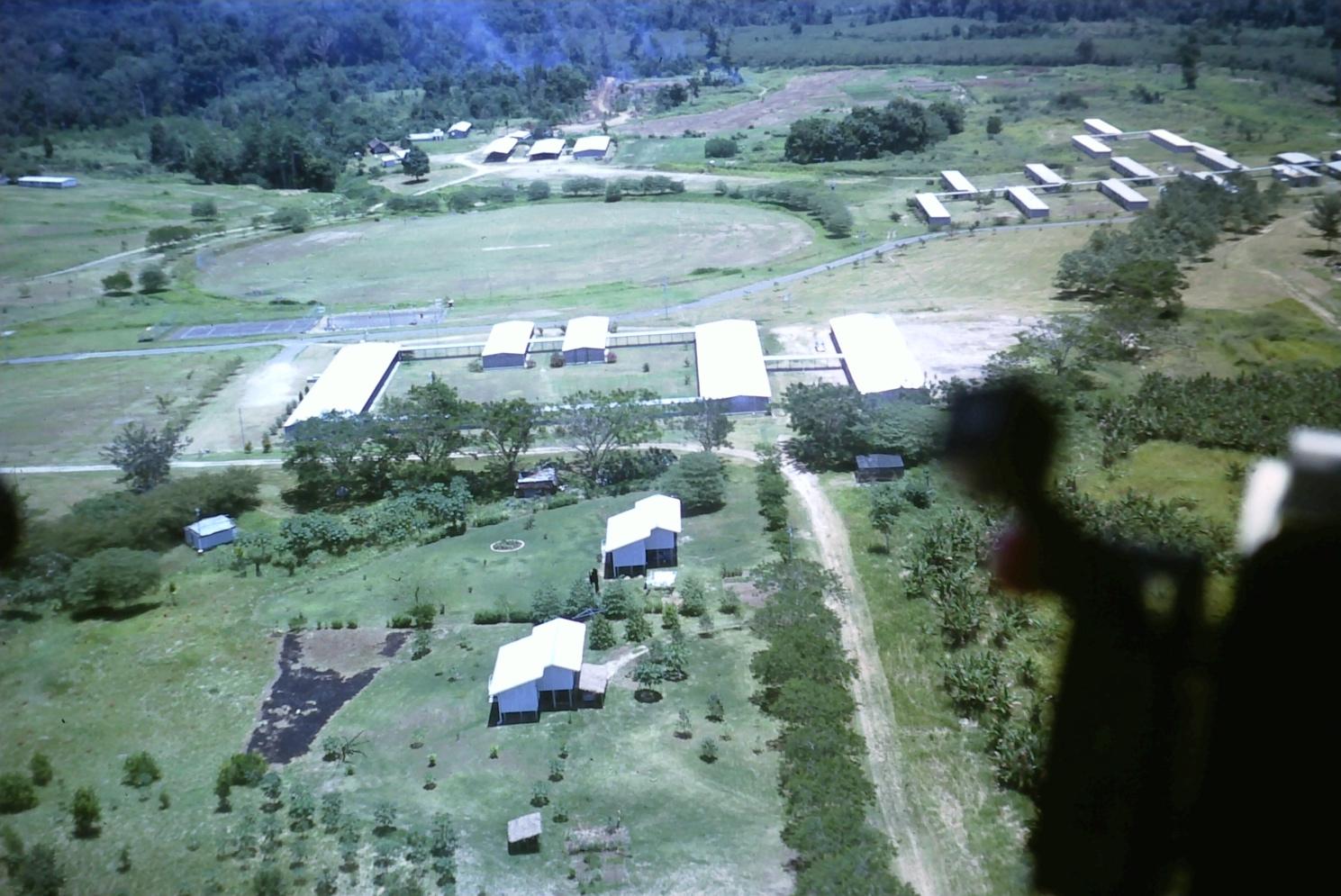
replaced the kitchen bench top and sink. Gloria and I then turned our attention to buying curtain materials and making curtains, applying estapol to the bare kwila floors, and laying down a sheet of vinyl on the kitchen floor. Temporarily in the too hard basket was the necessity to obtain from Government Stores some replacement webbing strips for the ubiquitous duralium lounge chairs.
At first, there was no hot water system in the house. Water was boiled on the stove for washing up. After our clothes washing machine arrived it could be set just to heat an adequate quantity of tap water and pump it into the bathtub without using the wash cycle.19
The District Commissioner and Mrs West invited Gloria and I to the Residency, Namanula Hill, Rabaul on 5 May 1967 to meet a number of delegates of the World Symposium on Man Made Forests who were on a post-Symposium tour to Rabaul and Keravat, among several forest centres in PNG.

I was surprised to find that my Schlich Medal20 had been sent in secret by Dr Max Jacobs from Canberra to Rabaul with one of the tour participants, Col L W Bryan, a forestry consultant based in Kailua-Kuna, Hawai`i, USA, who made the formal presentation of the Medal to me at this District Commissioner’s function. I was the third officer of the Department of Forests to be awarded the Schlich Medal, but only the second serving officer, as noted in the press at the time. The first was actually J B McAdam21 in 1933, before he became a Forest Officer in the Territories in 1948. The second awardee, and first serving
19 Later a simple solar water heater was purchased from Steamships in Rabaul and set up on the roof (see photograph earlier). It comprised a rectangular plastic bag about 1 x 2 metres in size, black on the bottom, clear on the top supported on curved wire hoops, all on a flat marine plywood base. The bag was periodically filled with water by pumping up from a rainwater tank. Warm to hot water was piped down under gravity to the kitchen and bathroom. The temperature reached depended on the duration and intensity of the sunlight received and how long the water had been held in the bag. The temperature of the water delivered ranged from just warm to so hot as to require cold water to be added in the sink or bath.
20 Sir William Schlich (1840–1925), Knight Commander, Most Eminent Order of the Indian Empire (KCIE), Fellow of the Royal Society (FRS), Fellow of the Linnaean Society (FLS), PhD, MA Oxford, was a famous German forester who became Inspector-General of Forests in India. He later established the forestry course in the Royal Indian Engineering College at Coopers Hill (Surrey, UK) in 1885 and founded the School of Forestry at the University of Oxford (UK) in 1905 with the transfer of the forestry course from Coopers Hill. He was appointed Professor of Forestry at Oxford in the same year. A Memorial Fund in his name was established in Oxford, to recognise outstanding contributions to forestry by both individuals and organisations in a number of countries, including Australia, New Zealand, UK, USA and Canada.
21 Written in the official list of Schlich Medal awardees as “J B. MacAdams”.
officer, was Alan Cameron (jointly with D. Doley (Australia)) in 1960. The Department of Forests had won the Schlich Memorial Award for Organisations in 1966.
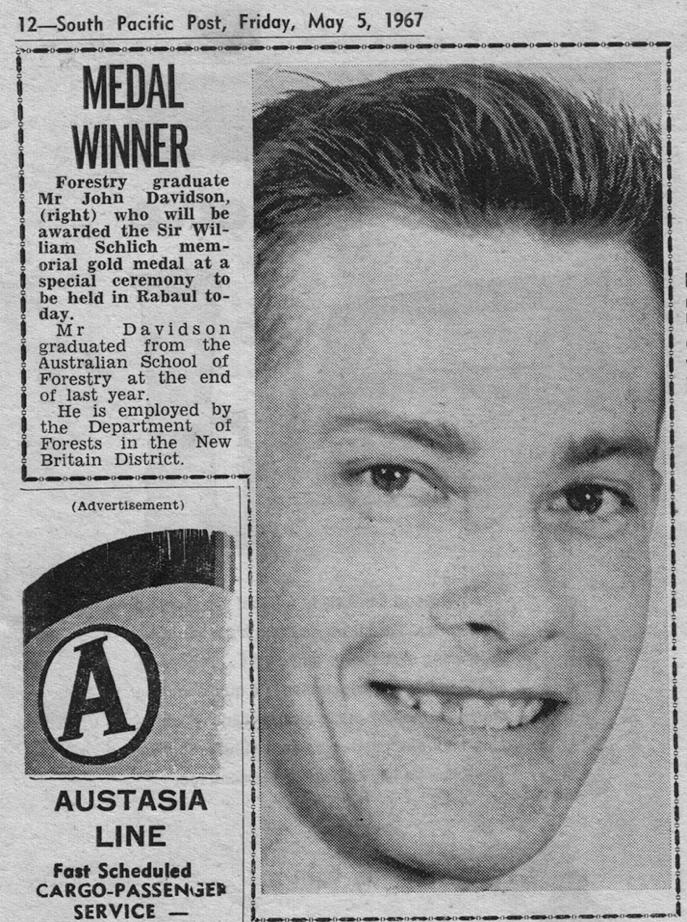
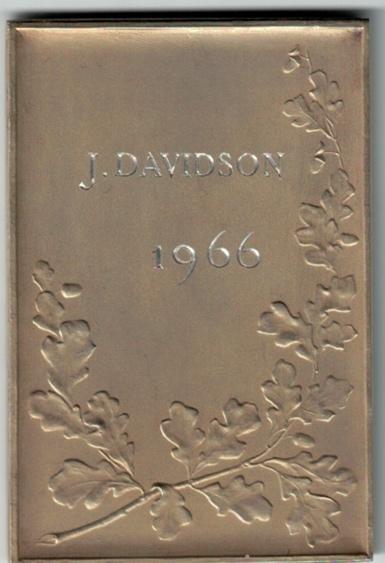

Shortly after this event, I was assigned to one of the Department’s timber resource surveys (IomaKumusi, near Popondetta). So, after only 17 days in the Territory, Gloria was left virtually alone to fend for herself for two months 14 May to 15 July 1967 in a challenging climate, at an unfamiliar and somewhat remote location, and having to deal with an alien culture and language. Thus, Gloria joined the ranks of a number of young and recent newlywed expatriate wives, some with very young children,

on which a seemingly uncaring Department had inflicted a similar fate when they first arrived in the Territory during the 1960s.
A presentation original fifth edition of Schlich’s Manual of Forestry Volume III Forest Management published in early 1925 and signed on the flyleaf by Sir William Schlich on 25 February 1925, only eight months before his sudden death on 24 October 1925.

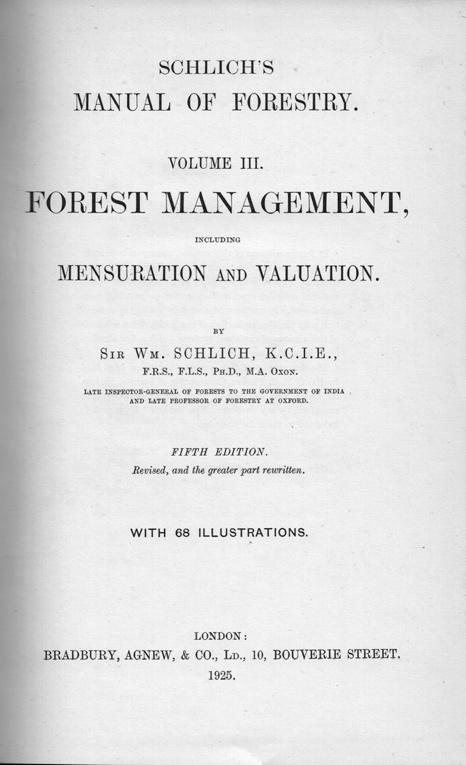

In mid-May 1967 I flew to Port Moresby then to Ioma near Popondetta in the Northern District to participate in my one and only full-scale timber resource survey and one of the last conducted by the Department of Forests. This was the 15 May – 14 July Ioma-Kumusi survey of about 467,000 ha stretching from the Kumusi River to the then New Guinea-Papua border. I made an edited 20-minute 8mm colour silent movie film of this survey which I have not got around to digitising yet! (2019)
A number of straight-line surveys in the local forest areas near the coast was carried out by a team of four comprising me and three local Technical Officers (graduates of the Forestry College in Bulolo). Each survey line was pre-planned in the “office” tent based on previously interpreted air photographs, and a landing site chosen for the helicopter usually on a sand or shingle bank of a river or stream or on land near a village, where sometimes a landing pad had been cleared beforehand using a chainsaw, axes and bush knives by a team that had walked in.
The helicopter made two trips to the same landing site near the start of each line. The pilot and team leader worked from a marked-up air photograph carried by the team leader to locate the landing site.
Each trip carried two passengers (half the team of four) and camping equipment, a radio, bush knives, a shotgun (usually), personal kit and food. A temporary camp for four was set up with a single flysheet pitched over the top and canvas bed sleeves stretched over poles. Each transect line was established by cutting an access track through the undergrowth on a bearing set by hand-held compass, running out a metal band (“chain”) to measure distance and using an Abney Level to measure slope of the terrain.
Ioma
temporary
in mid-May to mid-July 1967. The survey’s generator was connected to the Kiap’s house (centre) for the duration of the survey. Although the Kiap’s residence was near new and was wired and fitted with electric lights, there was no 240 -volt electricity generation available up until that time in Ioma. The playing field was an ideal landing ground for the helicopter that was providing fulltime support for the survey. The track in the bottom right led down to a substantial highwire suspension bridge from which the bravest of us dived or jumped into the river for a swim.
Lines normally were 3 to 5 miles (4.8 to 5.1 km) long, sometimes two or more radiating from a single start point near the landing pad, other times single lines from nearby landmarks. Temporary circular plots of 1 chain (about 20 m) radius were set out every 5 chains (about 100 m) along the line. Tree girth above buttress (GAB) was estimated using a “girth stick” (a graduated board that was a local variation of the Biltmore Stick) held up horizontally above buttress for each tree in the plot. Merchantable tree height was estimated by eye and sometimes checked using instruments (for example by an angular method using an Abney level set at 45° and a 100ft cloth tape for measuring the distance from the base of tree which equated to tree height (at least on flat ground)). The species, merchantable height and GAB of the trees greater than 1.5 m GAB within each plot were recorded in a survey field book. From one to three lines were surveyed in the vicinity each landing pad location, usually at the rate of one per day.
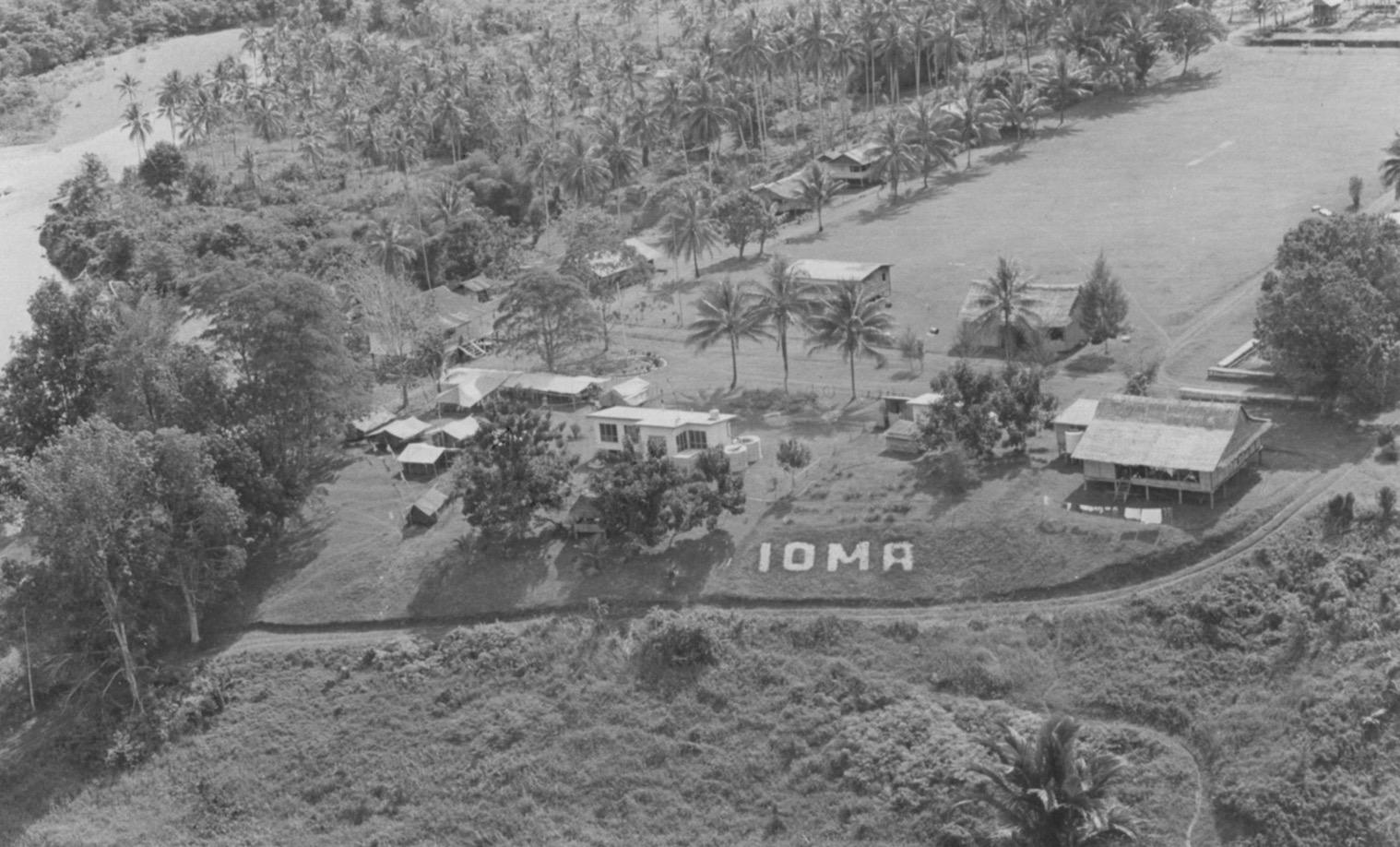
Thus, the team was camped in the field up to three or four nights at each site before being picked up by the helicopter and returned to base briefly before being repositioned to another field location.
Communication between the team leader in the field and base camp was by radio on a once- or twicedaily call schedule. Radio reception over the heavy portable radio was usually poor, even when the required long wire aerial was correctly oriented to point upwards at an angle and towards base. Weather was often an issue resulting in the helicopter not arriving for the pickup. Imagination often played a trick on the senses when a helicopter pickup was long overdue and waiting team members frequently thought they heard the noise of a helicopter that was not really there!
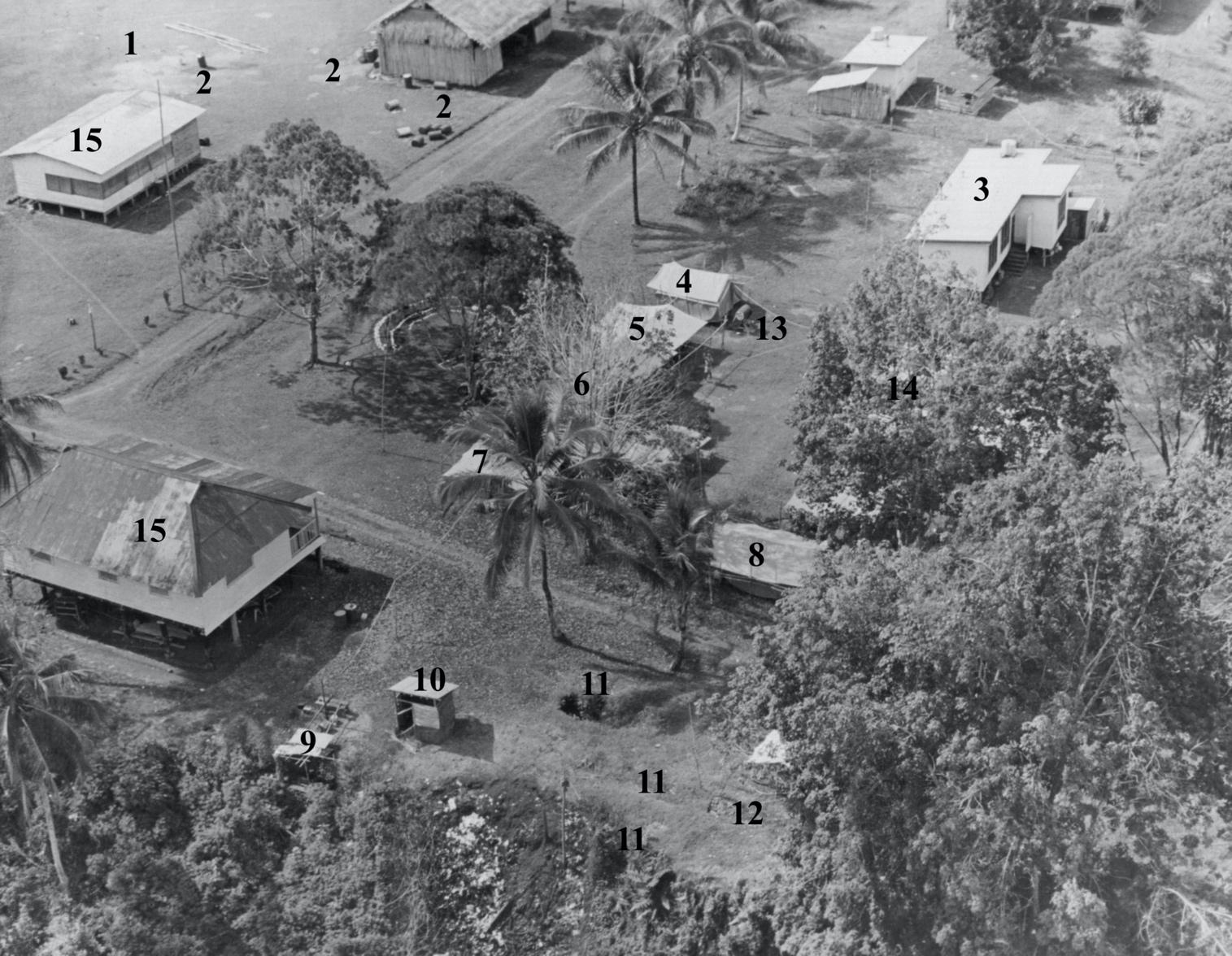
On leaving Ioma in mid-July 1967, I was in a Pilatus Porter22 next the pilot in front, two passengers seated behind and the back of the cabin loaded to the roof with camping and survey gear. A remark was made that did the pilot think it would fly with all this weight? The pilot said “No problem, watch this!” revved the engine, and while still in the loading area off the side of the aerodrome swung the tail around until the aircraft was pointing out towards the strip and took off from there and across the runway, easily clearing the trees on the other side! It was a beautiful clear day and flying conditions were smooth. The pilot trimmed the aircraft in a slow climb, pointed the nose past Kokoda and Mt Victoria to a gap in the mountains in front on the route to Port Moresby, put his feet up on the top of the instrument panel, pulled out a copy of the latest Time magazine and proceeded to read. As we approached the gap the pilot suddenly sat up and put away his magazine, barely a minute before Port Moresby airport control called him up to request his altitude and position and to pass on landing instructions.
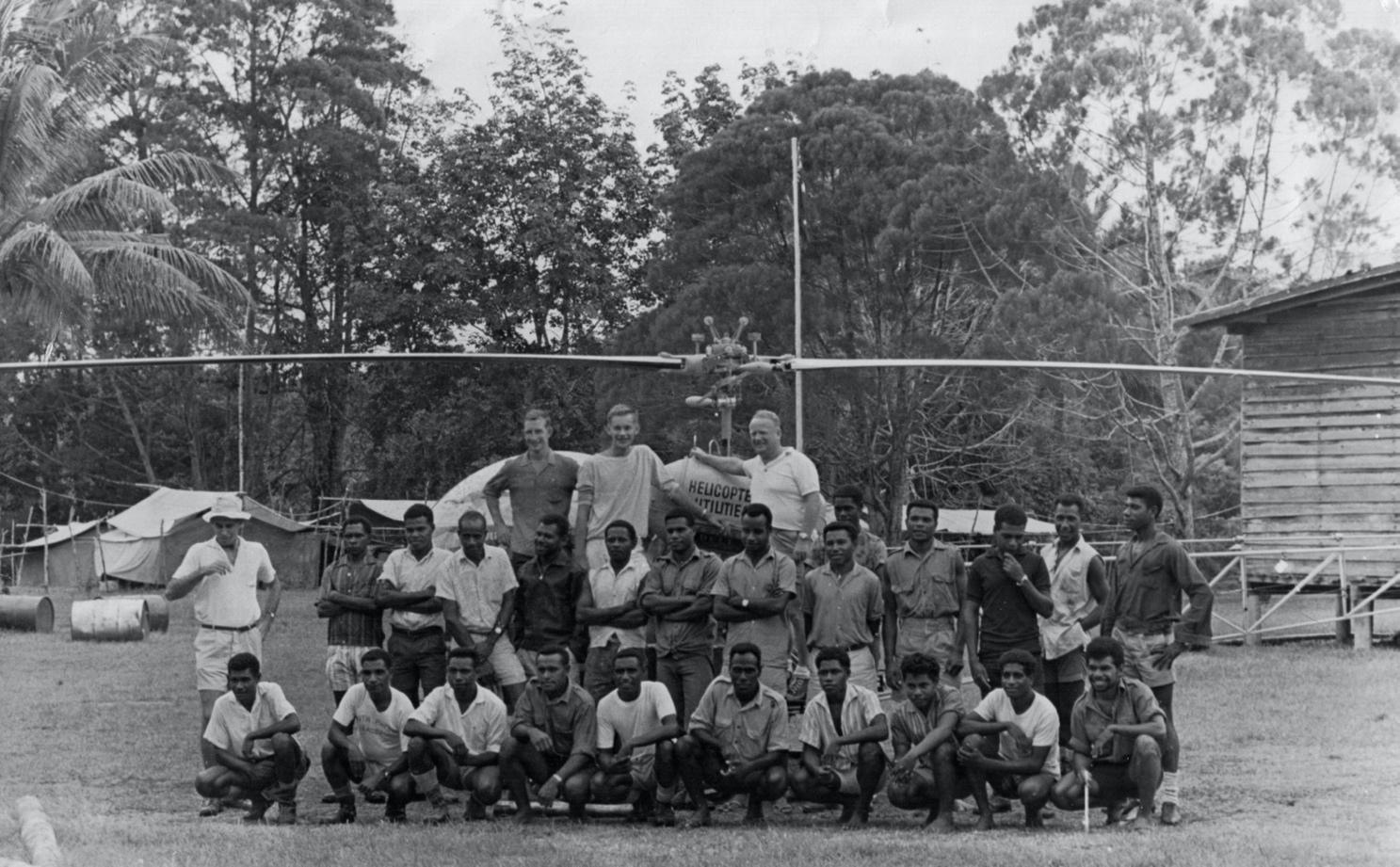

In 1967 Kamarere (Eucalyptus deglupta) poles were being treated with preservative for installation in electricity transmission lines. A sap replacement method was being used. Commonly known as the Boucherie Process, this method is applied to round timbers in the green condition with bark on and relies on gravimetric hydrostatic pressure to force the preservative from the butt end of the log through to the other end displacing the sap from the cell lumens which trickles out the top end. A water-soluble solution of a copper chrome arsenate salt (CCA) was used. A metal cap was fitted over the butt end of freshly cut poles and sealed around the pole with air-filled canvas or car tire inner-tube sleeves. A flexible tube connected the cap to a reservoir of preservative held as high as possible. The process was complete in each pole when preservative instead of sap was observed to be emerging from the top end. Two wood criteria were required to be fulfilled for this method to be successful:
Sapwood thickness: Only the sapwood shell is treated, so the sapwood should not be less than ½ the radius of the log, and,
Wood structure: In hardwoods the longitudinal flow is only through vessels.
CCA will only diffuse a short distance in a lateral direction. It follows that a species with relatively large, close together and uniformly distributed vessels are the best candidates. Young Kamarere poles fitted these requirements. A cross-section of Kamarere wood is shown here about 4x natural size showing the relatively large, close together and uniformly distributed vessels.

Inflatable canvas sleeve used to achieve a leak proof seal between the butt end of the pole and the metal cap (recently removed before this photograph was taken, so not shown here) through which the preservative was introduced.
Also, at Keravat in 1967, thousands of teak thinnings were being processed as treated house stumps for government housing projects. Teak has a narrow outer ring of relatively non-durable sapwood surrounding more naturally durable heartwood. The process adopted was the hot and cold bath process. At Keravat, a large rectangular steel water tank with the top cut out was supported above the ground with space underneath for a wood fire. The oil-based preservative used was creosote. The one-metre long debarked posts were immersed in the cold creosote to fill the tank, which was then heated from below. The heat lowered the viscosity of the creosote, which then more easily penetrated the wood, while at the same time drove expanding air and water out of the wood cell cavities. The creosote with the posts still immersed was then allowed to cool and what little air remained in the cells shrank, pulling more preservative into the sapwood. The posts were then removed and allowed to dry. Despite the flammability of the near boiling creosote, the need to work near a very hot fire, and the open-topped tank, no one got burnt or fell in and there were no accidental creosote fires or injuries among the workers.
One of the research tasks at Keravat in the late 1960s was to monitor the New Britain replication of a long-term extensive in-ground stake test of PNG timbers treated with different types and loadings of preservatives.23 After each monthly inspection any stake that had failed through termite or fungal attack was packaged up by Alan Fraser and sent to the Forest Products Laboratory in Port Moresby.
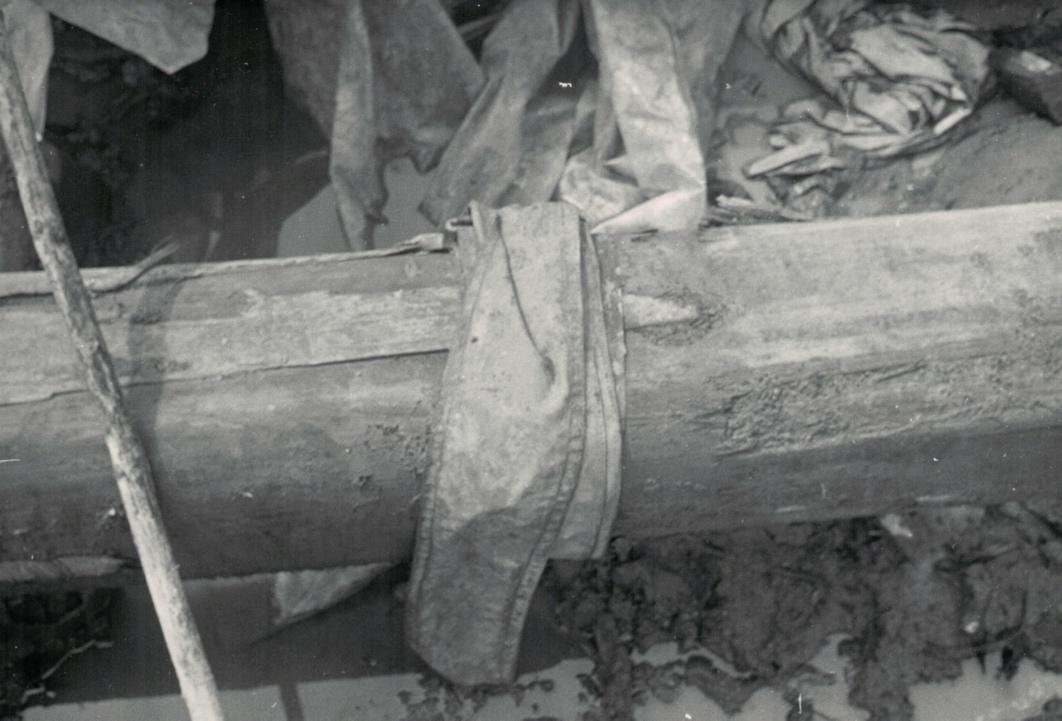
The Giant African Snail Achatina fulica (left), introduced to New Britain during the Japanese occupation in WW II, was a significant pest and a threat to the establishment of new plantations at Keravat. Cardboard rings that had been soaked in metaldehyde and creosote had to be placed around each new eucalypt seedling or teak stump at the time of planting to improve early survival of the young trees. The Cane Toad Bufo marinus was introduced to Keravat in 1937 to control the sweet potato hawk moth. The toads have spread all over New Britain and to parts of mainland PNG, posing an increasing threat to local fauna.

The decision had been taken to start a comprehensive research programme on Eucalyptus deglupta as the first placed candidate for reforestation after harvesting in the lowlands of Papua and New Guinea. I was designated to lead this project. It would be wide ranging and especially involve the exploration, evaluation, conservation and utilization of the genetic resources of the species.

Considerable effort was expended by me during 1967 and 1968 in searching the World’s herbaria and libraries for specimens, photographs and literature.24 The results are set out in the companion article
“Rainbow Eucalypt Man” (Part 1, pages 2 – 29). In parallel with this work was the development of techniques for vegetative propagation by both grafting and cuttings essential for tree breeding and development of mass clonal forestry (Part 1, pages 33 – 44).
Initial events leading up to the introduction of a university degree course in forestry
With a rapidly expanding forest industry in the country and a simultaneous call for self-reliance, an urgent need was seen for national professional forestry staff be trained to manage the forest resource by the Government and for the industry. The Bulolo Forestry School had been established in 1962, the same year in which I started my forestry cadetship, to train local foresters to take up positions in the forestry sector and other organisations. The phasing out of the PNG Cadetship Programme by the Australian Government from 1963 meant expatriate professional forest officers destined for employment in PNG would no longer be sponsored by the Department of Territories for training in Australian institutions, though a small number of other scholarships was available.
The Department of Territories had started a series of enquiries into higher education in Papua and New Guinea leading up to the “Currie Commission” (1963-1964) which produced the “Currie Report”25 , the first major milestone leading to development of a university in the Territory. The Currie Commission
24 In 1967 - 1968 these individuals and organisations contributed information, photographs and some loaned herbarium specimens: Prof. Dr van Steenis (former Director) and Prof. Dr C Kalkman (Director) of the Rijks Herbarium, Leiden, Netherlands; the Keeper, Arnold Arboretum and Gray Herbarium, Harvard University, Cambridge, Massachusetts, USA; Dr D M Churchill (Government Botanist and Director), Royal Botanic Gardens and National Herbarium, South Yarra, Victoria, Australia; the Keeper, Herbarium, Royal Botanic Gardens, Kew, UK; Prof. L D Pryor and the Gauba Herbarium, Department of Botany, ANU, Canberra; Mr T Hurley, the Herbarium Australiense, C S I R O, Canberra, Mr J Womersley, Director, Alick Dockrill Keeper and Colin Risdale Botanist, the National Herbarium, Lae, PNG; Dr S L Everest (Government Botanist), Dr L Pedley and Dr S T Blake, the Queensland Herbarium, Indooroopilly, Queensland; the Museum Curator for Botany, National Museum, Manila, Philippines; the Regius Keeper, Royal Botanic Gardens, Edinburgh, UK; Mr J Turnbull, Forest Research Institute, Canberra; Mrs S G M Carr, Research School of Biological Sciences and Dr W Heather, Department of Forestry, ANU, Canberra. I took the photographs of herbarium specimens, except where indicated otherwise. Mr C Roach, Department of Forests, Port Moresby assisted with processing black and white negatives and printing photographs. Ms J Shone and staff of the Library, Department of Forests, Port Moresby assisted with information sourcing and in obtaining interlibrary loans of a number of often rare or hard to source publications in an era before there were efficient photocopiers, digital photography or an internet.
25 Currie G, Gunther G and Spate O H K 1964 The Commission of Enquiry on Higher Education in Papua and New Guinea, Canberra.
(Sir George Currie
Vice Chancellor of the University of Western Australia 1940
1952; Vice Chancellor of the University of New Zealand 1952
1962; Currie Commissioner 1963 -1964. Sir John Gunther – Director of Public Health for P & NG 1946 – 1947; Assistant Administrator 1957 – 1966; Currie Commissioner 1963 – 1964; Vice Chancellor University of Papua New Guinea 1966 – 1972. Professor O H K Spate
Professor of Geography ANU 1951
1967; Director of the ANU Research School of Pacific Studies 1961
1972; Currie Commissioner 1963
1964; Member of UPNG Interim Council and Council 1967
1972; Professorial Fellow in the Department of Pacific and South East Asian History ANU from 1972.)
proposed graduate and postgraduate training for Papua New Guineans in forestry in Australia.26 The cessation of permanent appointment of expatriates to the Territory Public Service in 1965 reinforced the need to train national professional staff in all sectors, not only forestry.
Immediately following the Currie Commission enquiry, the University of Papua New Guinea (UPNG) was established in 1965 in Waigani about 11 km out of Port Moresby by an Ordinance of the then House of Assembly under the Australian Administration (Department of Territories)27 as the first university in PNG, initially heavily influenced by the Australian education system.28 Sir John Gunther, one of the Currie Commissioners, became the UPNG’s first Vice Chancellor. At the same time the PNG Institute of Higher Technical Education (IHTE) was created, at first co-located with the University at Waigani.29
Exploratory negotiations for tertiary level training in forestry took place between the Department of Forests and the UPNG during 1967 – 1968. Events leading up to the introduction of a forestry degree course were paralleling those for the introduction of a degree course in agriculture. The then UPNG Vice Chancellor Sir John Gunther wanted UPNG to teach both agriculture and forestry. The UPNG Professor of Biology Ken Lamb held discussions with the Department of Forests, which was keen initially for its Forestry College in Bulolo to be somehow linked to the UPNG to upgrade the courses and status of the Bulolo institution. However, the then Assistant Administrator Frank Henderson30 was absolutely adamant that a UPNG – Bulolo link for forestry was inappropriate as the College programme was subprofessional while he believed the chief manpower need was for mid-level personnel, and therefore a university course for forestry also was premature.
The Department of External Territories, following the Richardson doctrine emanating from the earlier Currie Commission, insisted that since so few professional forestry graduates were required, they should be trained in Australia, despite the debate on the lack of effectiveness of the Australian School of Pacific Administration (ASOPA, in Mosman, Sydney) summer school for preparing promising Papua New
26
The Commission consulted several times with Dr S D (“Dennis”) Richardson then consulting also for the FAO. He was of the strong opinion that PNG only needed a small number of local professional foresters and the cost of setting up a Department in the proposed university to train them could not be justified. Instead, they should be sent to Australia for graduate and postgraduate training.
27 The Hon. C E Barnes MP was Minister of Territories at the time. In 1965 the Department of Territories became the Department of External Territories when the Northern Territory in Australia was removed and placed under the responsibility of another Minister.
28 UPNG was founded just after a succession of new universities opened in Australia. The UNE was founded in 1954, Monash in 1958, Flinders in 1961, La Trobe in 1964 and Macquarie in 1964 (but the latter did not commence teaching until 1967).
29 In 1968 the IHTE moved to a large 500 ha campus near Lae (the current PNG University of Technology campus), and in March 1970 was renamed the PNG Institute of Technology (PNGIOT). Dr W Duncanson was the first Director of the IHTE/PNGIOT
30 Frank Cotter Henderson, MHA, Director Department of Agriculture, Stock and Fisheries until 1969, thereafter Assistant Administrator (Economic Affairs) until his death later that year.
Guinean science students in forestry and agriculture for tertiary studies in Australia.31 There the matter rested until early 1972.32
At Keravat, felling of logged over forest took place in May. The intention was always to have a broadcast burn followed by bunking and burning of the residue towards the end of the “dry” season, normally August – September. Usually, planting of E. deglupta was timed to begin in November. 8 x 8 foot (2.5 x 2.5 m) spacing was used at the time. Adequate tending was always an issue with grass and other weeds severely reducing early Kamarere growth.
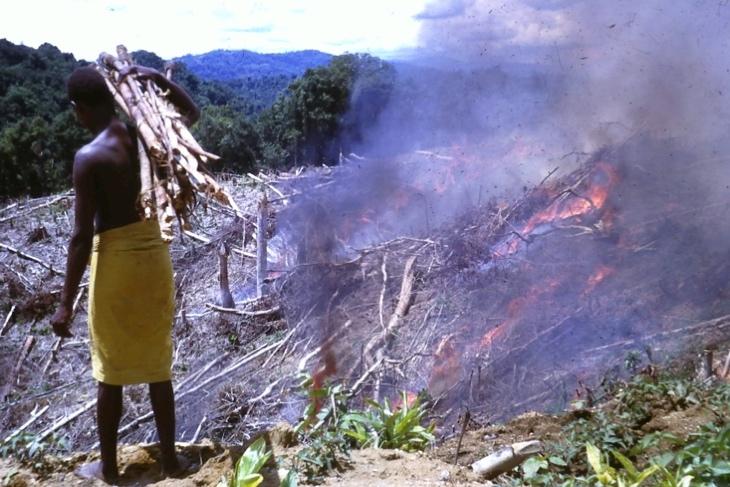
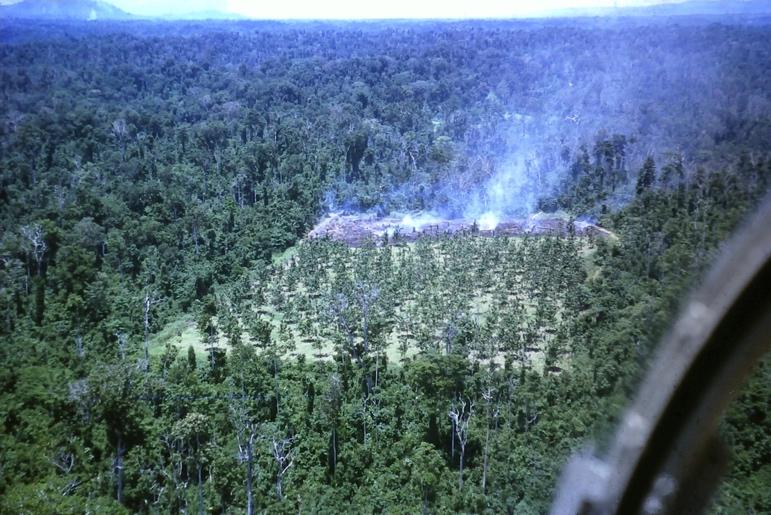
Above left and right: Plantation burn in Vudal LA Keravat, 1967. In the top left photograph plantation manager Robert Schneider (pointing) is directing operations. In the top right photograph the labourer is carrying firesticks, small bush saplings with hessian wrapped around one end and dipped in diesel fuel.
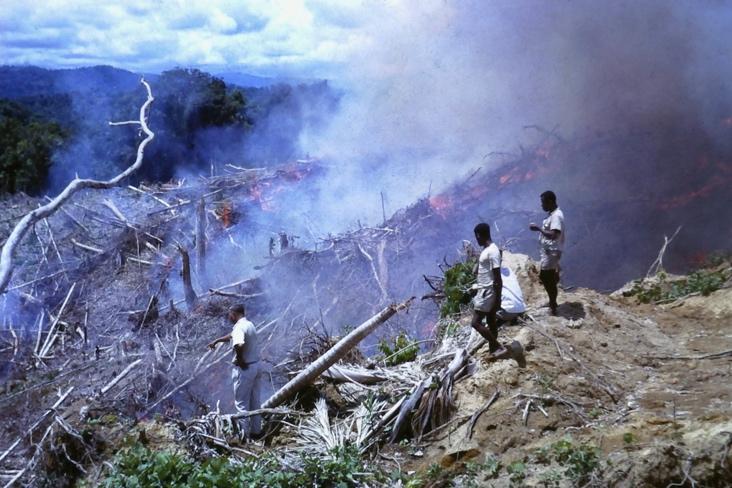
31 At ASOPA, students were given six weeks of intensive training to bring them up to Australian university matriculation level. The costly scheme was described by many as an “abject failure”. In the case of agriculture, only a couple of students were accepted into Australian universities and they soon dropped out. Advice back then had not been heeded that the alien educational and cultural background of Papua New Guineans would limit their success in Australian universities, the Australian courses were not designed to Papua New Guinean requirements and that graduate agriculturists could be better and more economically trained at the UPNG.
32 Communications included Suttie to Kedgley, 20 December 1967; Gunther to McNamara, 30 October 1968; Lamb to Gunther, 4 June 1968; Henderson to Gunther, 7 January 1969, and others later. See Page 167 In Howie-Willis I 1980 A thousand graduates – Conflict in university development in Papua New Guinea, 1961 – 1976, The Australian National University, Canberra.
In the 1948 E. deglupta plantation 4 plots each 0.5 acre (about 0.2 ha) had been marked out and thinned on 24 June 1952. Original spacing was 18 x 18 ft (about 5 x 5 m). Different thinning intensities were applied to the plots, Plot 1 was un-thinned, 2 had 40% of the trees removed, 3 60% removed, and 4 20% removed. Only a single replication was applied because of the small size of the stand. Annual measurements of individual tree diameters and predominant height estimates were made on these plots and the results recorded on original plot sheets hand carried to and from Port Moresby to avoid their loss in the post and to check new measurements against the previous ones on the spot to reduce errors.33
In October 1967 I was accepted by the Australian National University (ANU) to undertake a Master of Forestry degree externally. This gave immediate access to my appointed supervisor, Dr Peter Rudman, in the Forestry Department and to guidance of other staff, including Dr Bill Heather34 and facilities of the Forestry Department, the Botany Department (Professor Lindsay Pryor), the University Library and University Computing Centre with its IBM 360-50 computer and staff. A preliminary programme on the determination of wood properties in tree improvement project for E. deglupta was mapped out.
Vacation forestry students in Keravat for the long vacation 1967 - 1968
Lex Van Saane and John Mudge arrived in Keravat in early December 1967 for vacation employment. One of their assigned tasks was to re-measure 37 “yield plots” in each of E. deglupta and Tectona grandis (Teak) plantations, as well as plots in Ochroma lagopus (Balsa)35 , Terminalia brassii, T. catappa, Anthocephalus chinensis36 and Pometia tomentosa.37
33 There were no effective photocopiers back then to use to rapidly produce duplicate/backup copies of field measurement sheets.
34 Bill Heather was a DFO in Rabaul in the late 1940s and early 1950s. He and Forest Ranger W R Fryar at Keravat started the plantation programme with E. deglupta at Keravat in 1948, the first plantation was still existing and 19 years old, behind the “Davidsons’ house” in 1967. See Heather W A 1955 The Kamarere Forests of New Britain. The Empire Forestry Review, 34:255-278.
35 The preferred name is now Ochroma pyramidale (Cav. Ex Lam.) Urban.
36 A synonym is A. cadamba. The preferred name is now Neolamarkia cadamba (Roxb.) Bosser.
37 P. pinnata J R Forst. & G Forst. is now the preferred name, and P. tomentosa is an accepted synonym.
Australia’s Prime Minister Harold Holt disappeared while swimming at Cheviot Beach near Portsea, Victoria on 17 December 1967. His body was never found. John McEwan became Prime Minister.
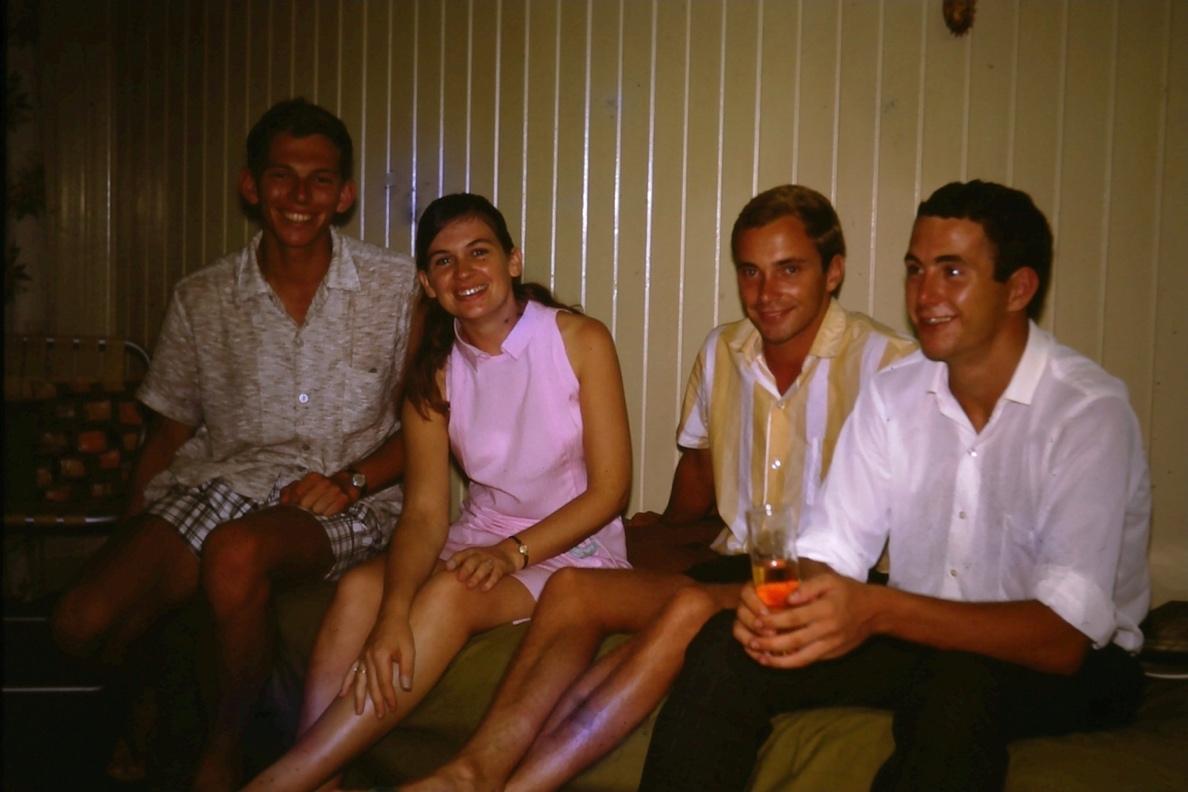
Petrol was available from a bowser at the Keravat trade store for 70 cents/gallon (15 cents/litre). A trip into Rabaul was required about every second Saturday for groceries and other supplies. Our “Supermarket” of choice was Kwong Chongs. Cheques were readily accepted nearly everywhere for purchases. Saturday lunch while in town was usually taken at the Rabaul RSL Club. If there were no perishables among the groceries, it was possible to stay in Rabaul to see a film at the picture theatre on the Saturday night. Occasionally we overnighted in the “Cosmo” (the Cosmopolitan Hotel). Otherwise, separate trips were made into Rabaul to see the latest film releases and return on the same evening.
A feature of the Keravat forestry social scene was our weekly darts night held in rotation around staff houses (Gloria and I, Heather and Terry Duggan, Chris and Robin Borough, Alan and Sue Williams, Robert and Mary Schneider, Robert Wills). Gloria tried her hand at golf at the 9-hole LAES course with borrowed clubs. She had not played golf before and did not continue to play after her time at Keravat!
A number of staff from Forestry, the High School and Vudal Agricultural College, formed a one-off business entity to indent a quantity of tape recorders, radios, turntables, speakers and other similar equipment and accessories in a single shipment direct from Akai in Japan at a considerable saving in cost even after duties were paid. Gloria and I purchased an up-market reel-to-reel tape machine (right) that we would otherwise not been able to afford, as well as a record turntable and other electronic items such as earphones.
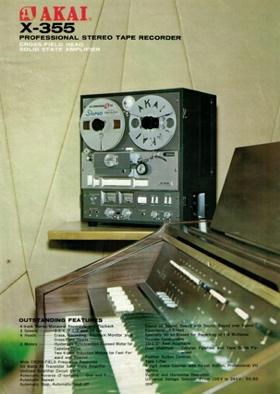

Gloria and I regularly swam in the ocean, usually by ourselves, from a black pumice sand beach on the shore of Ataliklikun Bay. On one occasion, Gloria had her wedding ring slip off into the shallows. In panic we searched the murky bottom without success until I felt the ring roll unseen over my submerged foot on its way out on a receding wave and I was able to grab hold of it! What luck and what a relief!
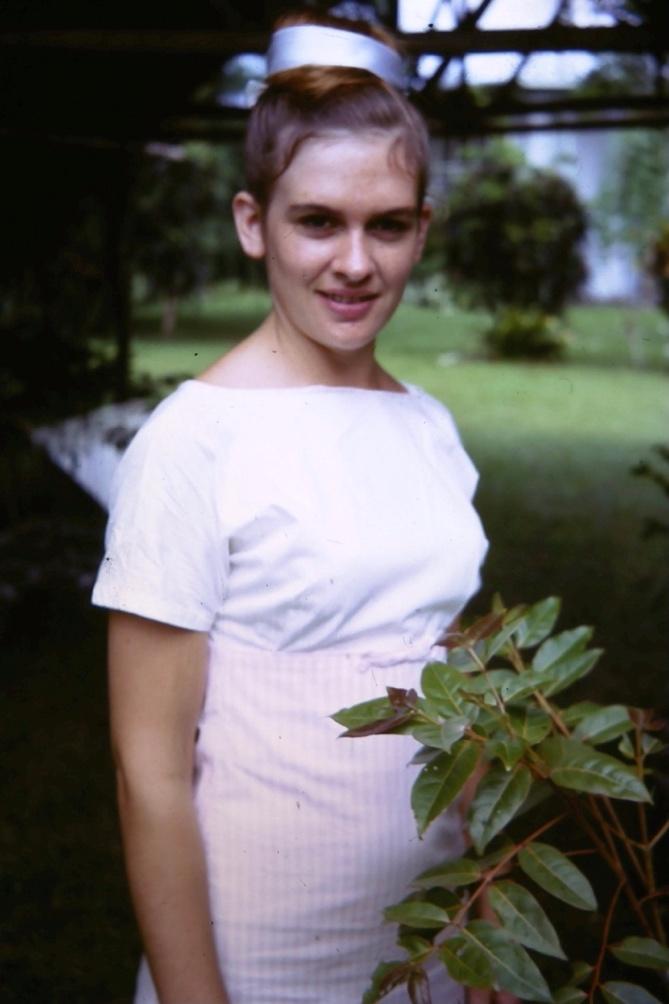
We once travelled around past Kokopo to a white sand beach, but after a short swim, noticed a rusty aerial bomb rolling back and forth in the shallows. We departed, and informed the bomb disposal squad in Rabaul, who went out and blew it up. Gloria and I never went back there!
Another pastime, given my interest in aviation history, was to seek out aircraft and other wartime relics, which were then still plentiful, and mostly left over from the Japanese wartime occupation. The then unsealed inland road from Keravat to Rabaul passed by the corner of Vunakanau Aerodrome, and there were still many Japanese aircraft wrecks and other equipment there. The grass strip was kept mown as an emergency strip for Rabaul, but to our knowledge was never used for that purpose while we were at Keravat. The derelict Keravat Aerodrome was located between the LAES and Ataliklikun Bay.
There were still the occasional explosions at various locations on the Gazelle Peninsula from wartime bombs and shells when the kunai grass was burned to make gardens.
Around the Gazelle Peninsula coast there were wrecks of barges, cranes and other wartime debris. Some barges were still intact in caves dug into the sides of hills near the shore around Simpson Harbour. In Rabaul town there were the remains of concrete bunkers, including Admiral Yamamoto’s bunker which had an opening near the Rabaul Hotel, and a couple of almost intact small Japanese tanks standing on side street verges.
There had been almost 500 km of tunnels under Rabaul and Kokopo including a hospital tunnel 4 km in length accommodating 2,500 beds. These tunnels were dug using prisoner of war labour, including Indian troops captured in Singapore and shipped by the Japanese to Rabaul.
In the middle of Rabaul there were remains of a bank vault that had been converted into a bunker and air raid shelter. Similarly, there were several round concrete water tanks that had been converted into bunkers by having slits cut in their sides.
We visited the superbly kept Bita Paka War Cemetery 48 km from Rabaul a couple of times.


“The Beehives” (Dawapia Rocks) near the entrance to Simpson Harbour and said to be two parts of a volcanic plug in the hard core of the ancient large volcano that formed the present-day harbour and surrounding caldera. Just above the tip of the largest rock is the narrow causeway built by the Germans in 1884 joining Matupit Island on the right to the Rabaul mainland on the left. In the background are on the left the active and steaming Tarvurvur crater, behind it the cone of “The Mother” and to the right rear the cone of the “South Daughter”.

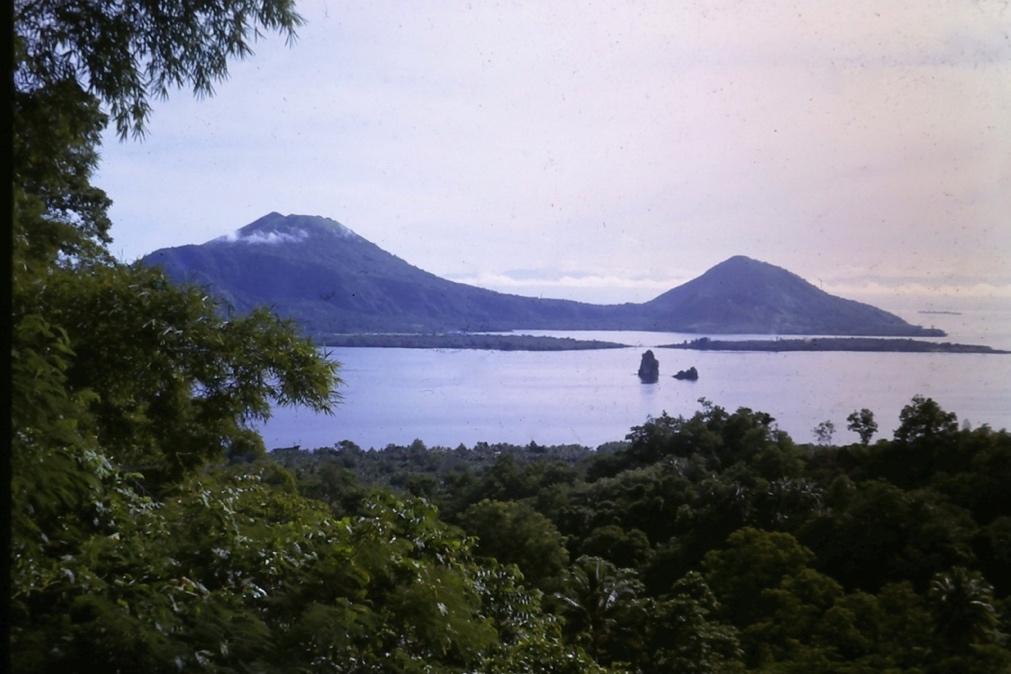
Volkswagen’s white paint was sometimes a disadvantage when following an open passenger motor vehicle (PMV) as the occupants spat their masticated buai into the slipstream. When it landed on the white paint of our car behind, it would make a permanent red mark in the paint if not washed off immediately! On one occasion, when returning from Rabaul to Keravat around midnight after watching a film, I noticed a bright light in the back window of the VW and took no notice at first thinking that it was the moon. Thick smoke and the smell of an electrical fire soon dispelled that and we evacuated the car. Inspection revealed the corrugated unsealed pumice road had caused the battery under the back seat to bounce out of its housing and short on the wir e seat frame. With the battery put back in place and no permanent damage done, we cautiously proceeded on our way!
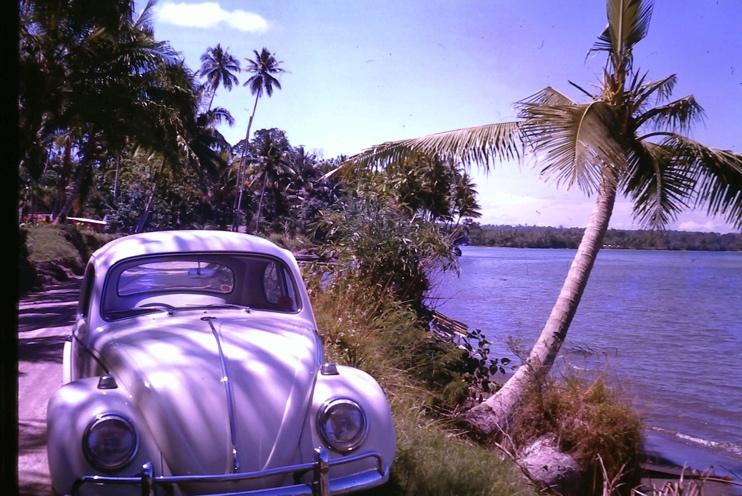
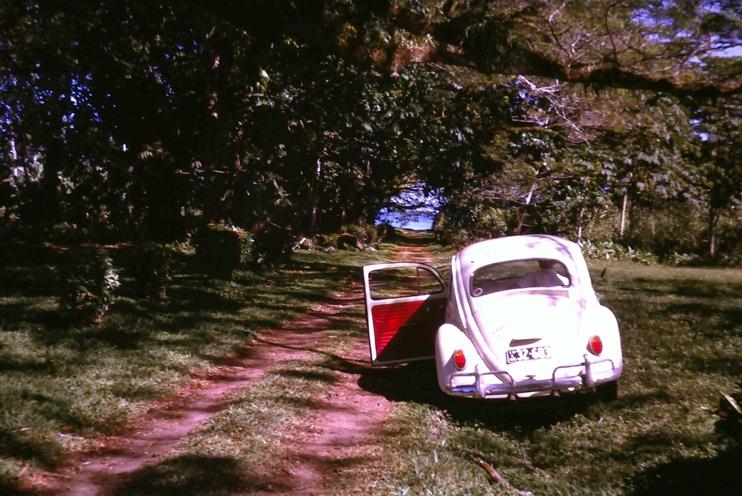
where we often
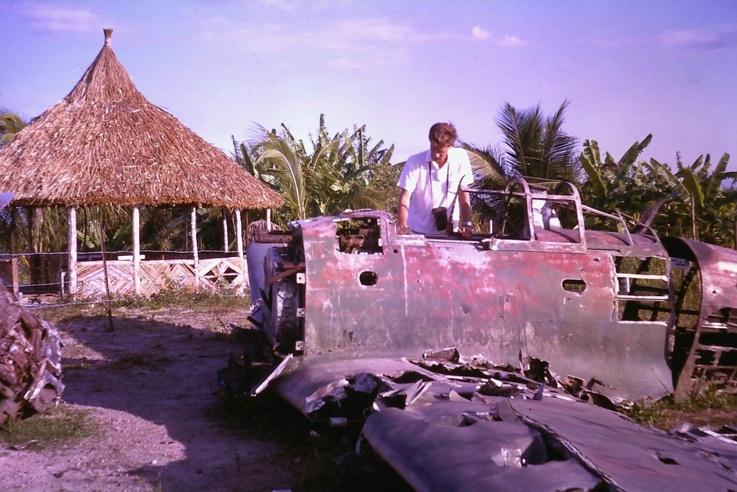
More remnants of the WW II Japanese occupation of Rabaul and Keravat photographed by me in 1967. Top left: Wrecked Japanese Zero aircraft on the edge of the Keravat aerodrome. Top right: Remains of a Japanese anti-tank gun mounted on concrete blocks in a Rabaul street. Middle left and right: Wrecked Japanese tanks on the coast, and in Rabaul town. Bottom left: Concrete bunker. Bottom right: Former bank vault in Rabaul that had been converted by the Japanese into a bunker/air raid shelter.
